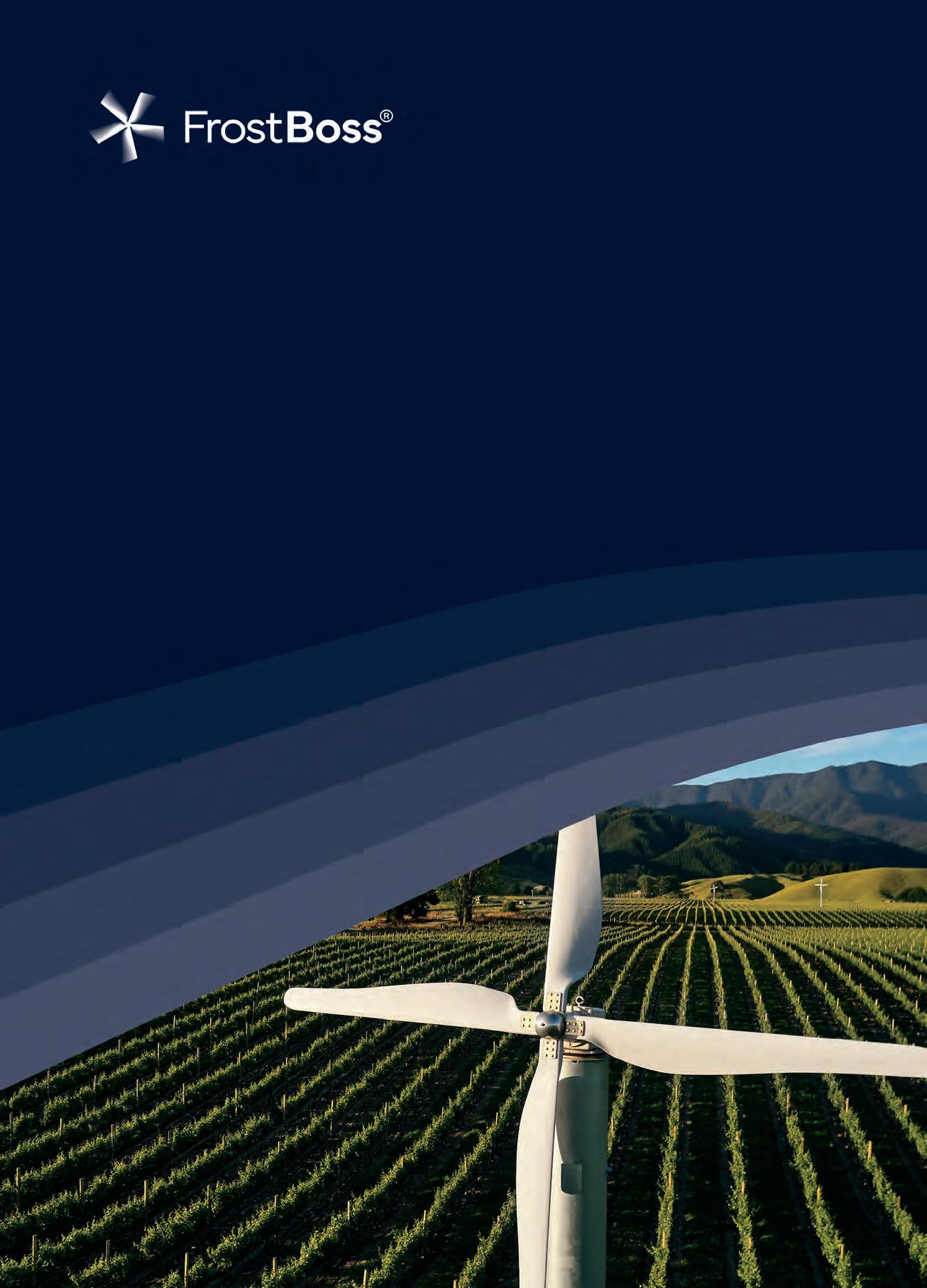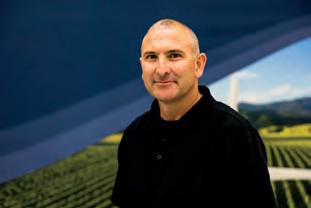
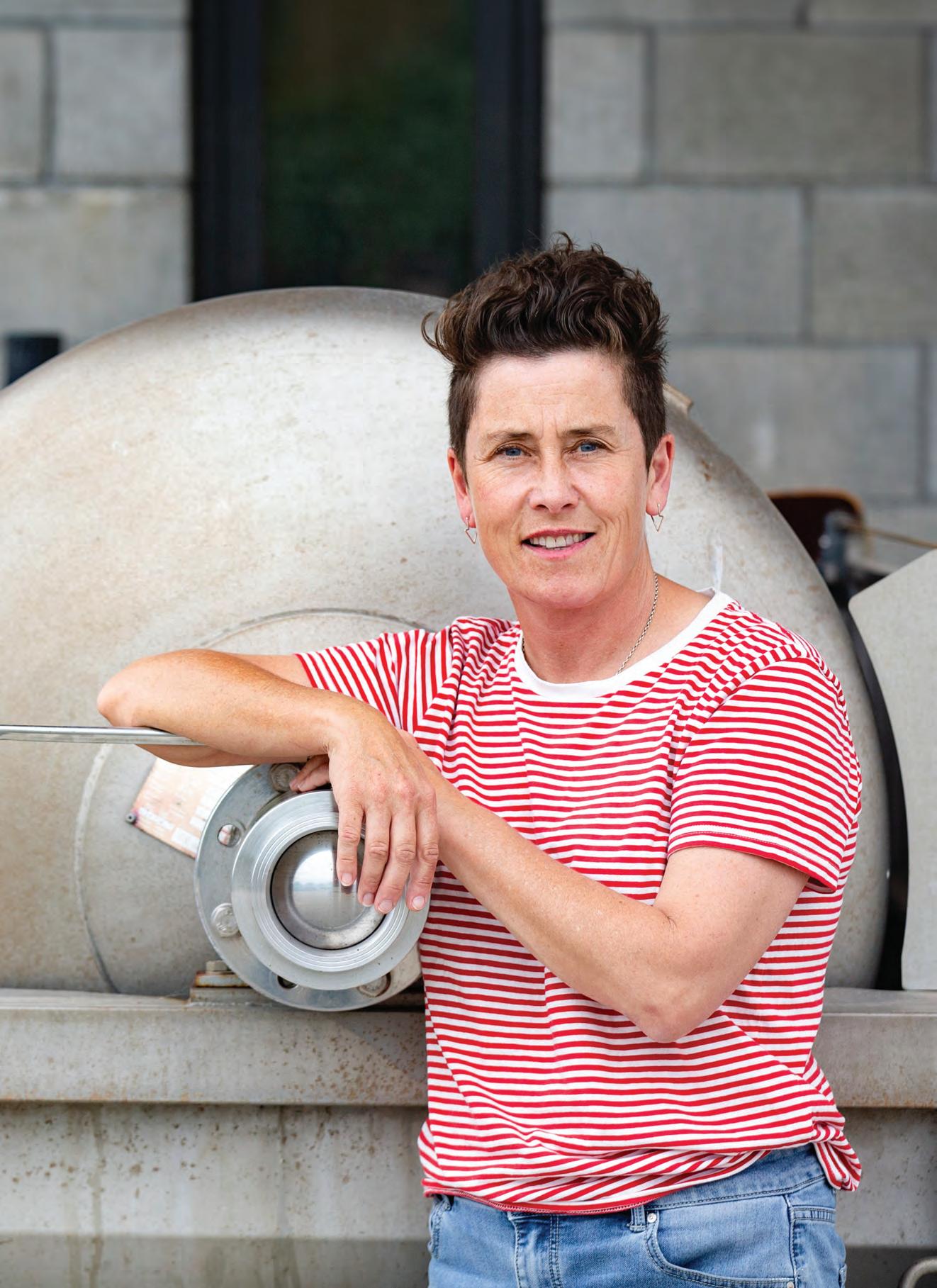
BRIght



BRIght
Industry accolade for legends of New Zealand wine


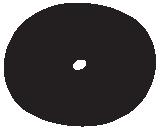




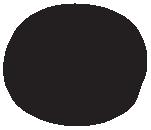













UPL crushes Botrytis, powdery mildew
UPL chemistries deliver against Botrytis (Kenja® 400 SC) and powdery mildew (Kusabi® and Flute®) in grapes.












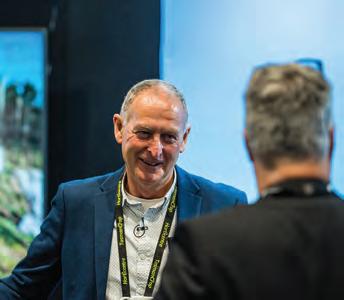
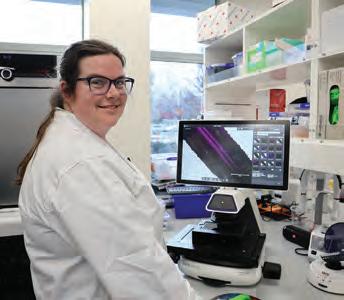
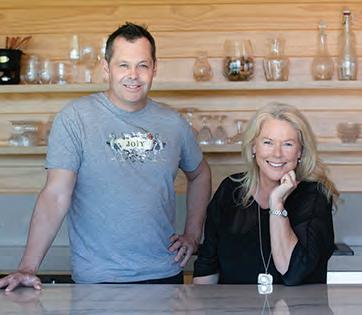

Editorial
Sophie Preece
From the CEO
Philip Gregan
Bright Ideas
RNA technology
The Profile
Aaron Jay
Women in Wine
Jane Cooper
Wine Weather
James Morrison
Sustainability Update Roadmap to Net Zero
NZW Fellows
Winemaker and Chardonnay champion Michael Brajkovich, viticulture and research “taonga” Nick Hoskins, and Hawke’s Bay grape grower Xan Harding are the 2024 New Zealand Winegrowers Fellows.
Packaging Update
New Zealand’s wine industry needs to change the way it talks about packaging, say industry leaders in an expanding niche market. “At the end of the day it’s the magic that’s inside the packaging that the consumer is buying,” says Chris Archer of Joiy.
How Hortus Happened
Growing up in an English council estate, Aaron Jay had a simple life plan – join the army, earn some money, get ahead. A few decades on, Hortus employs 110 full-time staff across three provinces, and 1,200 Recognised Seasonal Employee scheme workers.
EDITOR Sophie Preece sophie@sophiepreece.co.nz
CORRESPONDENTS
North Island
Joelle Thomson
Emma Jenkins MW
South Island
Claire Finlayson
Katy Prescott
Rachel Petrie
ADVERTISING
Upper North Island: Stephen Pollard
stephenp@ruralnews.co.nz
Ph: 021 963 166
Central & Lower North Island: Lisa Wise lisaw@ruralnews.co.nz
Ph: 027 369 9218
South Island:
Kaye Sutherland kayes@ruralnews.co.nz
Ph: 021 221 1994
CIRCULATION & SUBSCRIPTIONS
Sarah Adams saraha@nzwine.com 027 700 0740
New Zealand Winegrowers PO Box 90 276, Auckland Mail Centre, New Zealand
PUBLISHING & PRE-PRESS
Rural News Group
PO Box 331100, Takapuna, Auckland 0740
Ph: 09 307 0399
Location: Top Floor, 29 Northcroft Street, Takapuna, Auckland 0622
Publisher: Brian Hight
Managing Editor: Adam Fricker
Production: David Ferguson, Rebecca Williams
Published by Rural News Group Ltd under authority of New Zealand Winegrowers Inc. Unless directly attributed, opinions expressed in the magazine are not necessarily those of Rural News Group and/or its directors or management, New Zealand Winegrowers Inc. or its constituent organisations. Published every second month. One free copy is mailed to every member of New Zealand Winegrowers Inc, New Zealand Society of Viticulture & Oenology and the New Zealand Vine Improvement Group, and to such other persons or organisations as directed by the owners, with provision for additional copies and other recipients to be on a subscription.
ISSN 1174-5223

This edition celebrates three champions of the New Zealand wine industry, and their many decades of commitment to our vines, wines, research and organisations. New Zealand Winegrowers (NZW) Board Chair Clive Jones notes that the country’s wine industry is well established now, following four decades of transformational growth, with Michael Brajkovich MW, Nick Hoskins and Xan Harding all playing key roles in that. “It is important to recognise that there are a lot of people who have been heavily involved in the industry for most of that time and have made a real contribution to where we have got to.” Clive says while there will continue to be opportunities for transformation, it feels like New Zealand wine is reaching a period of maturity. “I think the next 40 years will be quite different.”
Certainly, the maturing of the industry will mean future Fellows are surely not quite so dominated by, well, fellows. I am so happy to see women taking the regional wins in the Wairarapa, Marlborough and Central Otago Young Viticulturist of the Year this year, and to see the success of industry leaders like Jane Cooper, the winemaker and wine judge on this month’s cover. Then there’s the likes of molecular biologist Dr Ellie Bradley, one of the scientists behind the Bragato Research Institute Tuned Vines programme. Our influencers are increasingly diverse, which can only make our industry better and more resilient.
Maturity doesn’t necessarily mean settled times, and in this edition NZW Chief Executive Officer Philip Gregan discusses the uncertainly being served up by nature and the economy, with yo-yo-ing harvest yields and market demand. “After the roller coaster ride of the past four years, it’s a fair question to ponder, ‘is this the new normal?’”
Sophie Preece EDITOR

Rachel Petrie



Rachel Petrie is a senior lecturer at Otago Polytechnic and presented at Grape Days on phenology and wine chemistry from a Pinot Noir clonal trial. Read about it in updates from Grape Days.
Go to page 29

Jo Grigg
Jo Grigg is a freelance journalist specialising in primary industries, and is involved in the family business growing beef, sheep and grapes in Marlborough. In this edition Jo checks out the potential of AI.
Go to page 32

Nadine Worley
A lighter environmental footprint is pushing alternative packaging options into the limelight, says Fugitive Organic cofounder and winemaker Nadine Worley, who checks out a recent packaging webinar. Go to page 36
With over 20 years’ experience working with the wine industry throughout the New Zealand Pacific region, we understand what it takes to enhance productivity and decrease costs for your winery. We can help you make your vintage a success by:
• Controlling fermentation
• Providing temporary cooling for cellars or other critical functions
• Providing additional power when needed
We are on call 24 hours a day, seven days a week to serve you.
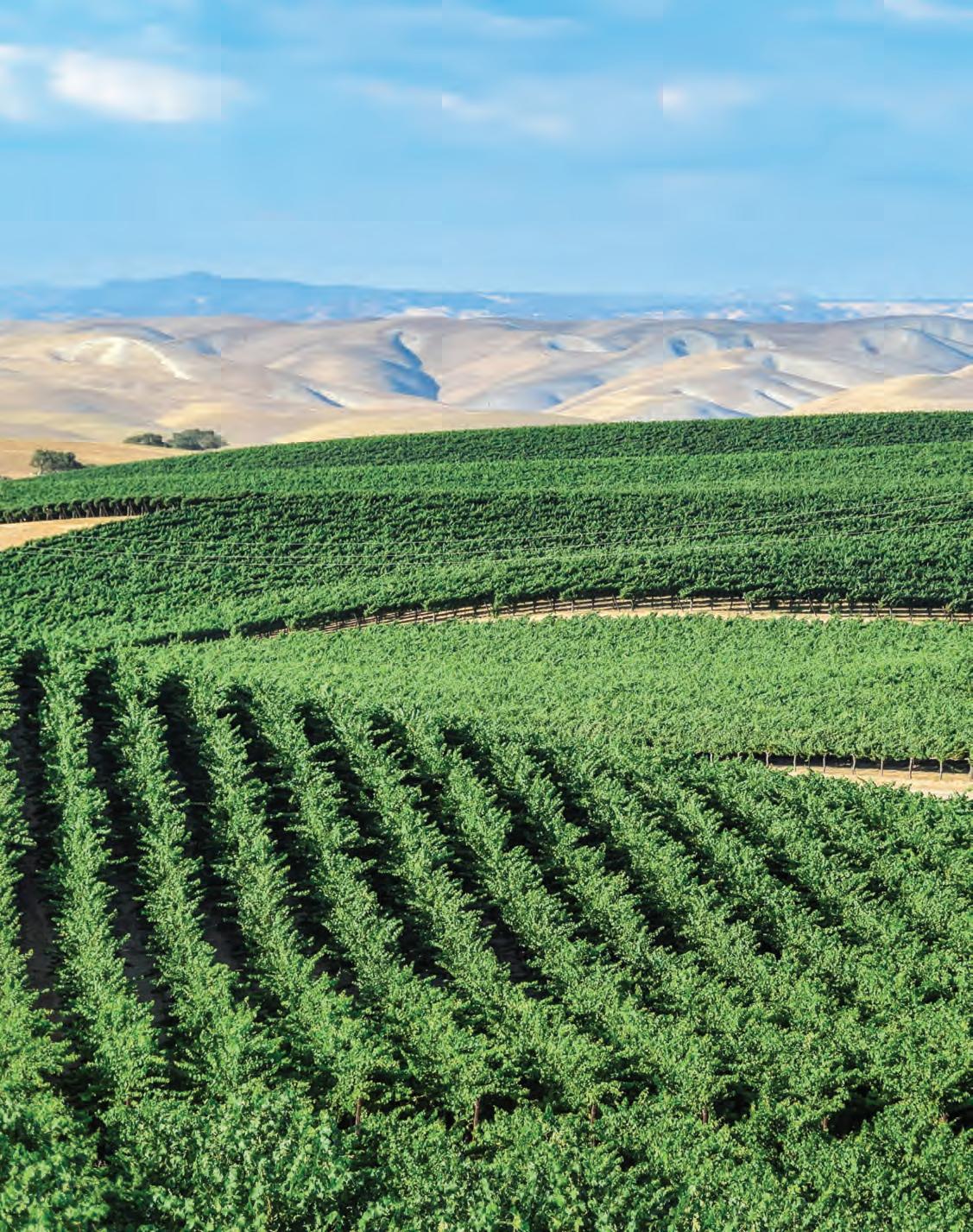


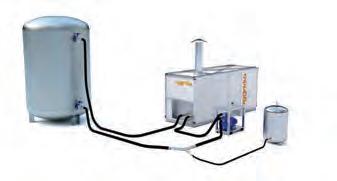

PHILIP GREGAN
Before Covid-19, the rise and rise of wine tourism was a much talked about feature of the wine sales landscape. With steady increases in tourism, the number of overseas visitors to cellar doors rose, year on year. The benefits to regions and the country as a whole were significant, with the data showing wine tourists stayed longer in the country, visited more regions, and spent more money than the ‘average’ overseas visitors. But Covid and closed borders changed all that. Visitor numbers slumped, as did sales through cellar doors, with some closing down, and many opening for reduced hours.
“Travellers from afar want the best experience possible and the Winery Cellar Door Bill is going to help make that a reality.”
Philip Gregan
How things have now changed. Although tourism numbers are not back to where they were, they are rising strongly, as the latest data from Statistics New Zealand demonstrates. Nevertheless, the current operating environment remains challenging. Credit card transactions were down 2.2% for the June 2024 quarter in the hospitality sector, not forgetting that inflation was around 3% at the same time. In this environment, cellar doors need as much help as possible. That is where MP Stuart Smith’s Winery Cellar Door Tasting Bill, which is nearing the end of its Parliamentary journey, comes into play. The Bill, which we are hopeful will be passed very shortly (after it received strong cross-party support in the committee stages in Parliament), will enable winery cellar
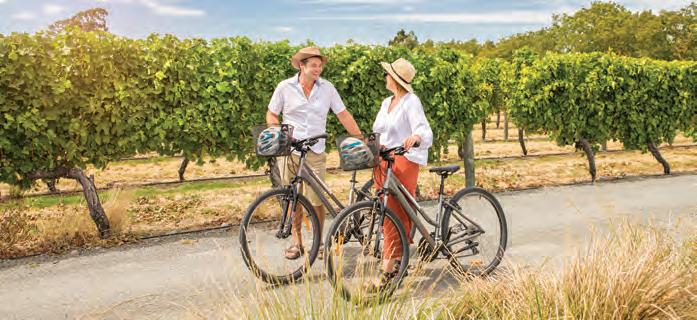
doors to charge for tastings. This is a simple change, but it will make a difference as it will enable wineries to both generate more revenue and to save money. The saving money part of the equation is because wineries will no longer need to go through the costly and time-consuming process of applying for an on-licence to charge for tastings. The Bill will also tidy up some other technicalities in the legislation which will make life simpler and easier for winery cellar door operators, including for those needing to hold both an on-licence and an off-licence.
The process getting these legislative changes in place has been a long one. It was well over five years ago that we started talking with officials and MPs about the challenges for cellar doors with the current legislation. Having to give wine away when customers were happy to pay for a tasting was top of the list, but there were other concerns as well, some of them simply reflecting different interpretations around the country.
Fortunately, Stuart, who is a former Chair of New Zealand Winegrowers (NZW) and the MP for Kaikoura (which of course includes Marlborough), was listening. He developed a Private Members’ Bill which is the one currently before the House. To date the Bill has garnered strong support from across Parliament, and we are hopeful it will be in force prior to the coming busy summer tourism season.
Ultimately the outcome everyone wants
to see when the Bill comes into force is a higher quality wine tourism experience at cellar doors. Travellers from afar want the best experience possible and the Winery Cellar Door Bill is going to help make that a reality. Well done Stuart for being such a strong supporter for the Bill as it has wound its way through the parliamentary process.
NZW’s Advocacy team will be keeping members updated as the law progresses and will be providing guidance on what the changes will mean for your businesses – watch this space. A quality experience is also the focus of the Qualmark New Zealand Wine Tourism Award recently announced by NZW. Acknowledging the important role that wine tourism plays in New Zealand’s visitor economy, this new award will recognise excellence in the visitor experience at the vineyard, from the cellar door to the quality of the hosting. Emphasis will be placed on providing sustainable tourism experiences across environment, people, and culture. The award is free to enter and is open to all NZW members, regardless of whether they are Qualmark-accredited. The winner of the Qualmark New Zealand Wine Tourism Award will be announced at the Altogether Unique industry celebration in Wellington on Thursday 29 August, alongside the induction of the new NZW Fellows, and the winners of the Young Viticulturist and Tonnellerie de Mercurey Young Winemaker of the Year Awards.

Philip Gregan is Chief Executive of NZW
Proudly NZ Made for over 30 years
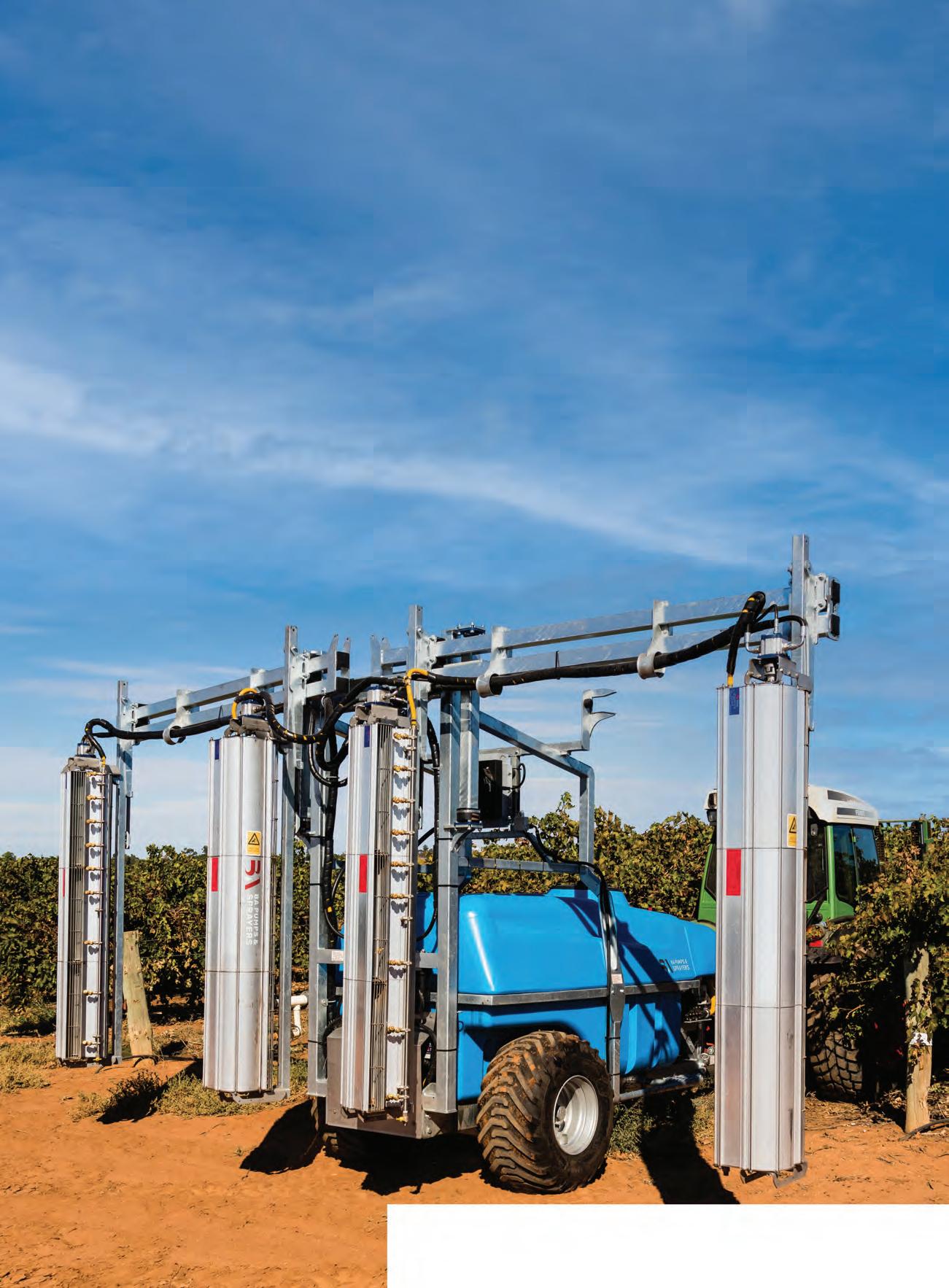
For over 30 years BA’s Vine sprayers have been the choice for New Zealand’s leading corporate vineyards, contractors and vineyard owners alike.
Available now with BA’s second generation tangential cross flow heads, the industry standard in spray technology, just got better.
The Vine Sprayers tangential fan heads provide excellent turbulence within the canopy to maximise coverage.
Each head is fitted with nine individual nozzles to enable full canopy or bunch line spraying. Simplicity of spray head adjustment (nozzles on or off), ease of application rate setup (12 presets) with the ARAG Bravo 350 Auto Rate Control makes this the market’s simplest sprayer to set up while achieving maximum spray coverage.
Visit the new BA Pumps & Sprayers website to find out more about our range of vineyard sprayers and Collard vine maintenance equipment - bapumpsandsprayers.co.nz
Simple to setup to maximise coverage
Hot dipped galvanised and robust chassis construction for maximum corrosion resistance
Bertolini Poly pump for maximum chemical resistance
BA tangential fan technology for maximum leaf coverage.

The 2024 Hawke’s Bay Wine Auction will see a 40-year private collection of Te Mata Estate’s prestigious Coleraine going under the hammer. The collection, donated by local wine enthusiast and plant scientist Stuart Tustin (pictured), features a bottle from each vintage, from its very first in 1982, through to 2021, with 1992, 1993 and 2012 being non-producing years. “This feels like the perfect opportunity to find a new home for the collection, at a healthy price, and support a fantastic facility,” Stuart says. “I hope we do it justice.” The Hawke’s Bay Wine Auction is the largest annual private contributor to Cranford Hospice each year, with last year’s auction raising more than $300,000. “It has to be noted that some of our 2024 lots are without doubt the most thrilling we’ve seen,” says Hawke’s Bay Wine Auction Chair Peter Cowley. “We’ve been blown away by the quality of the lots so generously donated by winemakers and supporters, and the excitement that is building as we head into the auction is palpable.” The first opportunity to sip and sample the wines on offer takes place on Wednesday 14 August at the Napier War Memorial Centre with the auction itself, including a tasting prior to the gavel being lifted on the first lot, at Toitoi Hawke’s Bay Arts and Event Centre on Saturday 14 September. To see all lots on offer and purchase tickets go to hawkesbaywineauction.co.nz. Anyone wanting to make a phone bid on the day should email office@hawkesbaywineauction.co.nz
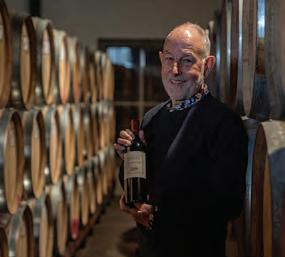
Rob Walters from Place of Changing Winds, in Australia’s Macedon Ranges, is the guest speaker at the 2025 Southern Pinot Noir Workshop, to be held at the Hanmer Hotel in Hanmer Springs from 23-25 January 2025. Rob will discuss topics such as high-density planting, canopy management, Poussard pruning, marketing potential, and how to improve the image and sales of New Zealand Pinot Noir both domestically and overseas. The 2025 workshop is three days rather than the usual four, with the content condensed to fit the tighter timeframe.

Hosted by the New Zealand Society for Viticulture and Oenology, the 11th International Cool Climate Wine Symposium will be held in Ōtautahi Christchurch from 25-28 January 2026. Boasting an innovative programme of leading international and New Zealand practitioners, the symposium will feature plenary sessions, workshops and tastings alongside offsite tours and social functions. iccws2026.nz

Pinot Noir New Zealand 2025 invites global wine lovers to reconnect over three days in Ōtautahi Christchurch. “We have some amazing speakers lined up and are looking forward to hosting influential trade and media from our key export markets,” says committee Chair Michael Henley MW. United Kingdom wine commentator Rebecca Gibb MW calls it an opportunity to reconnect with a constantly evolving wine community, “whose thirst for self-improvement can never be quenched”. See more on page 13.
Selaks is celebrating a big birthday in August, marking 90 years since Marino Selak released his first vintage from a small vineyard in West Auckland. In 2024, Selaks (based in Hawke’s Bay for the past 20 years) is highly recognisable and remains among the top selling wine brands in New Zealand, “so still successful after 90 years”, says Stephen Cheadle, Constellation Brands Managing Director New Zealand and Australia. Marino, who arrived in New Zealand from his native Croatia in 1906, planted 300 vines on his Henderson property in 1930 and launched his first vintage in 1934. In 1939 he was joined in the business by his nephew Mate, who took over the business when Marino retired. Stephen says the 90th celebration will be marked with localised events in all Constellation Brands’ locations in this part of the world. “We are still in touch with members of the Selak family, so we will invite them to take part in our festivities marking this major milestone. It’s incredible to think that 90 years after the first bottle was sold, the Selaks brand is still going from strength to strength. It’s something we’re really proud of. We think it’s important to stop and take a moment to reflect and celebrate.”
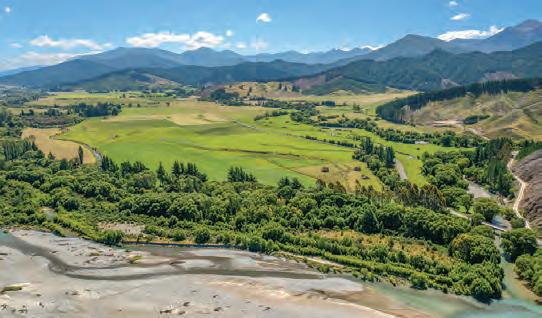
Craigmore Sustainables has added to its viticulture portfolio with the purchase of a 418-hectare development site in Marlborough. Cat Creek, located at North Bank in the Wairau Valley, will have nearly 200ha of Sauvignon Blanc vines when fully developed. It is the first viticulture venture in the South Island for the food and fibre investment company, which has vineyard holdings in Gisborne and Central Hawke’s Bay. “The Marlborough Sauvignon Blanc story continues to provide strong long-term fundamentals that make further expansion attractive,” says Craigmore’s General Manager Horticulture Con Williams. Craigmore will invest $40 million in the development over the next two years and about 3,000 tonnes will be harvested from the vineyard at maturity, with an export value of more than $20 million. Craigmore has partnered with Babich Wines and the wine company’s Marlborough team will be responsible for the management and development of the vineyard. “It’s rare to have access to such a sizeable vineyard development,” says Babich Wines Chief Executive David Babich. “There is a lot of common ground between our two businesses, most prominently our shared view that environmental stewardship and long-term, sustainable business success go hand in hand.” Babich Wines will also invest additional capital into its Marlborough winery to increase processing capacity to cater for additional grape supply.
Winning a Global Decanter Platinum Award for the Mutu Reserve Chardonnay 2021 is a a tribute to the enduring spirit of the region’s winemaking community, says Winemaker Kel Dixon. Shed 530, home to the Mutu label, required a complete rebuild after the 2023 storm destroyed three buildings and most winemaking equipment. “Thankfully a majority of our latest vintage had already been moved off-site, allowing us to continue sharing these delicious Hawke’s Bay wines,” Kel says. “Our team’s perseverance and the support from the community has been incredible and we plan to be back open this summer.”
The 2022 Saint Clair Omaka Reserve Chardonnay was also awarded a Platinum medal in the awards, with Senior Winemaker Stewart Maclennan describing the wine as “unapologetic in its design, staunch in character and traditional in method. It represents the best of what we believe well treated Marlborough Chardonnay can produce”.
The McArthur Ridge Southern Tor Pinot Noir 2022, from the Alexandra Basin in Central Otago, was the only New Zealand wine to win a Best in Show in the awards, with judges noting that the wine “shows why there is so much excitement about Central Otago”.
McArthur Ridge International Sales Manager Jason Dellaca says the “outstanding result” is testament to the vineyard site in Alexandra and the ability and quality of the vineyard team.
Wine scientist Dr David Heatherbell had a major influence on New Zealand’s horticulture and wine industry, says two of his colleagues. David, who died peacefully in Christchurch in May, led Lincoln University’s grape and wine programme for 16 years, influencing about 800 students, say Drs Wendy Parr and Mike Trought. “Many of these students have progressed into influential positions within New Zealand and international wine companies, a legacy that has helped our industry achieve the position it enjoys today.”
In addition to the undergraduate and post-graduate diploma programmes, David mentored numerous graduate research students. “And again these are now found throughout the world leading research and teaching programmes, particularly in New Zealand, the United States, Canada, Great Britain, and Australia,” they add. “David was a creative, innovative, and philosophical scholar, his work standing out in a scientific field that was, at the time, largely descriptive. He took pride in his research and ventured into new fields, including work on colour stability of Pinot Noir wines, protein instability, psychological aspects of sensory perception, and early work on the production of lower alcohol wines. He had great satisfaction in seeing the adoption of his research and the success of his graduates both nationally and internationally.”
“We estimate that during his 16 years at Lincoln, about 800 students would have participated in the wine courses.”
Dr Wendy Parr
David was raised on the Heatherbell Orchard near Brightwater, and gained a Bachelor of Science with Honours in Biochemistry at the University of Canterbury, then his PhD in food science and technology at Oregon State University (OSU), launching him into a love of wine research, Mike says. He returned to New Zealand and joined the Department of Scientific Industrial Research (DSIR) at Mt Albert in Auckland from 1965 to 1978, before returning to OSU as Professor Food Science and Technology, contributing to the early development of the Oregon wine industry, researching the management of Pinot Noir. It was during this time that he advanced the establishment of the International Cool Climate Grape and Wine Symposium. This legacy continues today, with the next symposium to be held in Christchurch in January 2026.
To have events added to our calendar contact sophie@sophiepreece.co.nz

National Final
27 August
nzwine.com/en/events/youngwinemaker
The National Final for the 2024 Tonnellerie de Mercurey Young Winemaker of the Year competition will be held at Foley Wine’s The Runholder in Wairarapa, with regional winners battling it out to win the bespoke barrel trophy presented to the champion. The challenges will cover laboratory skills, wine judging, industry knowledge and public speaking. The winner will be announced at the Altogether Unique Celebration Dinner on 29 August.
National Final
28 August
nzwine.com/en/events/young-vit
The New Zealand Young Viticulturist of the Year National Final will be held at Escarpment in Wairarapa, with the winner announced at the Altogether Unique 2024 Celebration Dinner in Wellington on 29 August. Read more about regional finalists on page 48
29 - 30 August
nzwine.com/en/events/altogetherunique-2024
Altogether Unique 2024 will bring together winemakers, grape growers and industry partners in Wellington, to gather, network and celebrate New Zealand’s wine industry while learning from the latest insights and innovations. The programme includes the Wine Business Forum and Celebration Dinner on 29 August, followed by the Women in Wine Breakfast and inaugural Research and Innovation Forum on 30 August. Attendees can book for all or some of the four events.
29 August
nzwine.com/en/events/altogetherunique-2024
Attendees at the New Zealand Winegrowers (NZW) 2025 Business Forum will navigate the beverage highway, guided by experts in marketing, sales, artificial intelligence and more. The high calibre lineup of speakers includes Felicity Carter on navigating future wine trends (see page 14), Rachel O’Shea, from Yabble, on the new “superhighway” of AI in wine business, Andrew Shedden, Head of Fine Wine for Endeavour Group, on the innovation driving wine growth, and Kevin Roberts (CNZM) on the inherent brand value of being of ‘New Zealand’.
29 August
nzwine.com/en/events/altogetherunique-2024
NZW General Manager Advocacy Sarah Wilson will be joined by comedian Te Radar in hosting this industry celebration at Te Papa in Wellington. The event will include announcements of the Young Viticulturist of the Year and the Tonnellerie de Mercurey Young Winemaker of the Year for 2024, as well as the presentation of the 2024 NZW Fellows, and a new Qualmark New Zealand Wine Tourism Award, acknowledging the important role of wine tourism in New Zealand’s visitor economy.
30 August
nzwine.com/en/events/altogetherunique-2024
Te Papa Chief Executive Courtney Johnston is the guest speaker at the Women in Wine Breakfast on day two of the Altogether Unique programme, speaking about her “two takes on a career journey”. Jo Cribb, Chair of New Zealand Women in Wine, will also update attendees on recent activities.
30 August
nzwine.com/en/events/altogetherunique-2024
The inaugural Research and Innovation Forum will explore research on the horizon, technology on the ground, and smart ways of increasing efficiency in vineyards and
wineries, says Bragato Research Institute Knowledge Transfer and Engagement Lead Braden Crosby. As well as expert insights on utilising data to maximise potential in the winery and the vineyard space, the forum will include presentations on the potential of RNA technology in vineyards and the role of enzymes as a precise tools of winemaking, with Dr Ellie Bradley of the BRI Grapevine Improvement team (see page 34) joined by biochemist Dr Wayne Patrick, Victoria University’s Associate Dean of Science. The forum will include the launch of the New Zealand Wine industry’s Roadmap to Net Zero 2050 (see page 54).
5 September
nzwine.com/en/initiativesevents/ women-in-wine
As part of the Women in Wine Development Series, leadership coach Trish Lui will run a webinar on “Crushing Imposter Syndrome; building your confidence and your career”, including practical tips and tricks. The series of webinars is also being recorded.

16 - 22 September
organicwinenz.com
Organic Wine Week, which ushers in the Spring Equinox, is a seven-day celebration of all things organic wine. The week includes two Down to Earth gatherings, at Prefab Hall in Wellington on 17 September and Brad’s Warehouse in Auckland on 19 September. The success of the inaugural Down to Earth last year led OWNZ to find a bigger Auckland venue and expand into Wellington, says Marketing & Events Coordinator Naomi Galvin. “The expansion will allow for greater participation and more good vibes to flow. It’s a sign that consumers are really interested in learning more about organic wines.” Each Down to Earth event kicks off
with a registered trade session from 2:304:30pm, followed by a ticketed public session from 5:30-7:30pm. Other Organic Wine Week activities include wine list takeovers, winery pop ups, winemaker dinners, retail promotions, and instore tastings.
26 -27 September
hawkesbaywine.co.nz
Packed with tastings, case studies, and stellar keynote speakers, the 2024 Aotearoa New Zealand Chardonnay Symposium, to be held in Hastings, will build on the success of the inaugural event last year. The programme is focused on a sense of place, with day one exploring Aotearoa’s geology, terroir and Chardonnay with experts that include Elaine Chukan Brown, Brenna Quigley, and Stephen Wong MW, followed by Burgundy and Californian perspectives from Jasper Morris MW and Elaine. Day two moves the spotlight back to New Zealand, with a consideration of clonal impact and reflections on global influences and comparisons, including Tasmanian Chardonnay, and an exploration with Jasper of the challenges facing White Burgundy. Read more on page 50.
15 October
nzsvo.org.nz/technical-workshops
The theme of the New Zealand Society for Viticulture and Oenology 2024 technical workshop, to be held in Blenheim, is ‘Keeping it Fresh’. Sessions will discuss technology and trials, wine trends, unique perspectives, packaging innovations and consumer facing strategies. Themed tastings throughout. Tickets now on sale, capped at 100 delegates.
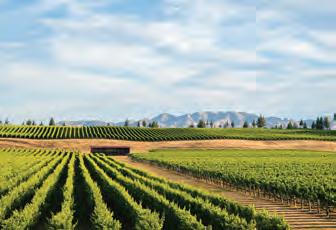
18 October
nziws.co.nz
The 2024 New Zealand International Wine
MCC New Zealand is committed to telling your brand’s story through beautifully crafted labels, that complement the design and brand vision.
Talk to MCC New Zealand, where every product is labelled with care.
Producer: No1. Family Estate
Designer: Alex Lloyd
Photographer: Jim Tannock
Show marks 20 years of the competition. Bob Campbell MW is Chief Judge, supported by Assistant Chief Judges Larry McKenna, John Hancock and Tony Bish, along with a senior judging team that includes a number of leading winemakers and key industry personnel. Judging will take place in Auckland 23-26 September with the awards function in Auckland on 18 October.
3 November
nationalwineawards.co.nz
The National Wine Awards of Aotearoa New Zealand is the country’s newest national wine competition, run by the same team that organised New Zealand’s longest running wine show, the Royal Easter Show Wine Awards. Convener Jo Gear says the competition merges the event’s heritage with focussed ambitions for the future, to identify, celebrate and elevate excellence in New Zealand wine. Entries open 12 August and close 6 September, with initial results released 11 October, and the Awards of Excellence Long Luncheon on 3 November. Read about Chair of Judges Jane Cooper on page 44.

Charlotte Read
Our second Wine Business Forum is just around the corner and we are so excited about the programme of impressive speakers joining us at Te Papa in Wellington. Gathering together as an industry at a national level – to learn, be inspired, make new connections and reconnect with peers – is a special opportunity. We look forward to seeing many of you there and hope you will be able to participate in the multiple Altogether Unique 2024 events from 29 to 30 August.
The inaugural Qualmark New Zealand Wine Tourism award will be announced at our Industry Celebration dinner following the forum. Any winery offering a visitor (cellar door) experience is eligible to enter this award, which celebrates the best of wine tourism in New Zealand. nzwine. com/en/initiativesevents/altogetherunique/ au24-celebration-dinner/qualmark/ Charlotte Read is NZW General Manager Brand

A ‘Somewhat Sommit’ event was held in London this May, chaired by Cameron Douglas MS. It featured blind tastings of 27 wines across five flights – aromatics, Sauvignon Blanc, Chardonnay, Pinot Noir, and wider reds – to deepen United Kingdom sommeliers’ understanding and spark discussions about New Zealand’s wine landscape and its on-trade relevance. Attendees could apply for a place at the 2025 Sommit in New Zealand, with well over half taking up the chance.

In June, Wine Australia and NZW teamed up to present a masterclass and free pour tasting in Manchester, attracting more than 60 guests from across the north of the UK. The masterclass, hosted by Rebecca Gibb MW and Emma Symington MW, featured sparkling, Sauvignon Blanc, Chardonnay, Pinot Noir and Shiraz/Syrah from both countries. There have been previous collaborations, both virtually and abroad, but this was the first time NZW and Wine Australia have held an in-person event together in the UK. Based on the positive reception from target audiences we will join forces again at the London Annual Trade Tasting in January 2025.
New Zealand Winegrowers (NZW) public relations strategy to drive frequency of mention of our premium New Zealand wine in our key markets and working with ‘NZ Inc’ is paying dividends. See how the NZW PR Programme performed for the period July 2023 to June 2024.
NZW had a significant presence at Vinexpo Asia in Hong Kong in late May, hosting more than 33 wineries and 20 wine brands in the New Zealand Wine pavilion. The event saw participation from 1,032 producers and 14,203 visitors, doubling last year’s attendance in Singapore. The New Zealand Consulate and New Zealand Trade and Enterprise in Hong Kong also hosted a networking evening that was attended by notable figures like James Suckling, and the MW contingent of Debra Meiburg, Fongyee Walker, and Edward Ragg.
Additionally, the Altogether Unique New Zealand Wine roadshow visited Beijing and Shanghai on May 22 and 24, attracting 1,200 trade professionals. Events included masterclasses led by MWs Fongyee Walker and Sophie ParkerThomson, focusing on ‘Iconic Whites of New Zealand’.

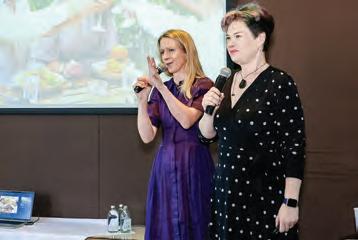
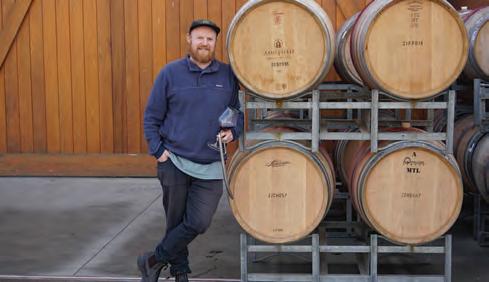
Pinot Noir New Zealand 2025 will be held in Ōtautahi Christchurch from 11 to 13 February. Committee member Ben Leen, Winemaker at Amisfield in Central Otago, focuses his Pinot obsession on the upcoming event.
I’m really looking forward to… a well-overdue Pinot Noir party! This event has been years in the making. A strong foundation was laid by the 2021 Pinot Bunch committee, before a pandemic got in the way. Now the 2025 Bunch is carrying the Pinot Noir torch and committed to putting on a world-class event that shows New Zealand Pinot Noir in all its glory.
“If global Pinot Noir was the theme of a talent quest, then New Zealand Pinot would definitely win most exhilarating performance. Hands down.”
Ben Leen
Our committee is… chomping at the bit to host 80-odd New Zealand Pinot producers and the who’s who of the wine world in Ōtautahi. The programme for the conference is looking superexciting. We have a great mix of international speakers and local heroes on board to share their stories and evoke all our senses on the uniqueness of New Zealand Pinot Noir. The themes we cover over the three days are Turangawaewae, Kaitiakitanga, and A Mua; our place, how we care for our land, and our future.
You have to try Pinot Noir matched with… truffleinfused baked camembert cheese! Tis the season for truffles. The earthy, warm spiciness of the truffle and the creaminess of the cheese is a 10/10 match with Pinot Noir. For maximum pleasure ensure the Pinot has bit of age on it and you’re sitting in front of a roaring fire at the Cardrona Hotel after a day up the slopes. That’s a very specific pairing but one you won’t regret!
When I think of New Zealand Pinot Noir I think of... The energy of our place, our unique natural environment and how truly transparent this can be expressed in a glass of New Zealand Pinot Noir.
One thing you should know about me is … I’m unapologetically obsessed with wine; specifically Pinot Noir. Chardonnay is a very close second. Maybe second-equal with Riesling. It’s a tight call; a dilemma I am happy to take my time (maybe my lifetime) to resolve.


IT




The brown marmorated stink bug is a pest that infests homes, ruins gardens, stinks when crushed, and is almost impossible to get rid of. It could also destroy our fruit and vegetable industries. It’s not in New Zealand yet, and we want to keep it that way. So if you see one, don’t kill it. Catch it, take a photo, and call us on 0800 80 99 66.
For more information (including how to identify the bug) visit biosecurity.govt.nz/stinkbug

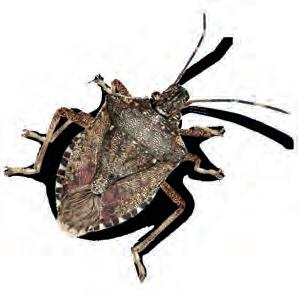
Felicity Carter – founder of the Drinks Insider podcast and research consultancy and Editorial Director of Areni Global in London
– is one of the speakers at the upcoming New Zealand Wine Altogether Unique Business Forum in Wellington. Here she shares a few insights into her wine career, global trends, and why she loves visiting New Zealand.
How did you first start writing about wine?
Back in the late 90s, I briefly worked as a copywriter for Cellarmasters in Australia, which did basic wine training. This convinced me I was a wine expert. After I began freelancing for newspapers, I successfully pitched a wine story. I had no idea how competitive wine writing was, or how little I knew, but it was a lot of fun, so I kept going. In those days wine writing was brutally competitive, and the other writers quickly realised I knew next to nothing. To save myself from complete embarrassment I had to learn as much as I could, as quickly as I could. Of course, the more you learn, the more you want to learn.
In 2007 I saw a job ad for an English language wine writer to work on a new German title, in Germany itself. I applied for the job and set off on what was supposed to be a one-year contract to work on a wine business publication, Meininger’s International. And here I am in 2024, typing this from my home office in Germany.
Are you still excited by the stories? I tend to report on what’s happening
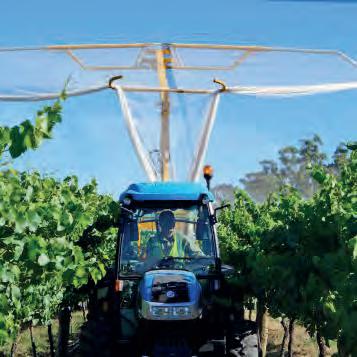

economically, rather than about individual wines, and it’s changing so fast there’s always something fascinating going on. Plus I get a chance to meet a wide range of people, which I love.
How has the telling of them changed?
The great thing that’s happened is the expansion of what’s possible, thanks to podcasting, social media, blogs, selfpublishing and all the other tools available. There are far more voices being heard now, to the benefit of everybody. The established wine media hasn’t changed as much as you might imagine. Early on, the wine media got into competitions and events, and so had other sources of revenue when the big advertising collapses happened. As a result, they’ve been able to keep on doing what they were doing, in a way that is no longer possible in the rest of the media.
Can you tell us about the thinktank Areni Global?
Based in London, Areni really does two things. The first is research into the world of fine wine, and the second is bringing people together to brainstorm. The big project we’re involved in at the moment is a limited series podcast, Inside La Place de Bordeaux, that’s exploring the La Place distribution system
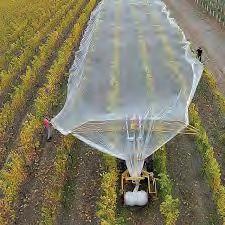
and the impact that’s having on the global fine wine market.
What’s on your mind for the Altogether Unique Business Forum?
Global trends in wine and some of the opportunities that are around at the moment. There are still some very bright spots if you know where to find them.
What’s a burning issue for New Zealand’s wine industry?
Diversification. Everyone knows New Zealand is the best place in the world for Sauvignon Blanc, so it’s time to start promoting other varieties and styles.
Are you excited to come to Aotearoa?
I’ll take any chance I can get to come back to New Zealand! I went to primary school in Waiouru (yes, I was an army brat), so it always feels like coming home. Plus I love hearing what everybody is up to. The honesty and creativity of the New Zealand wine industry is energising to be around.

The New Zealand Winegrowers Wine Business Forum is the first event in the Altogether Unique 2024 programme, to be held at Te Papa in Wellington on 29 and 30 August. The forum will be followed by a Celebration Dinner that night, with the Women in Wine Breakfast and inaugural Research and Innovation Forum to be held on 30 August. Attendees can book for any or all of the four Altogether Unique events. nzwine.com/en/events

New Zealand agent for Netwizz and Olinet netting applicators. Slim, standard and hydraulic mast models available.

According to respected United States beverage analyst Danny Brager, the number of wine drinkers in the US has increased over the past decade. However, the issue lies in the frequency of wine consumption among these drinkers. Many are drinking less or diversifying their alcoholic beverage choices, with options now including hard seltzers, RTDs, fruit blends, low alcohol, alcohol-free beverages, and THC infusions.
The competition for ‘share of throat’ has intensified, and the consumer demographic is also shifting. 10,000 Americans turn 21 every day in the US and most of the population growth is led by Hispanics of various origins. Wine is much less developed than beer and spirits among these growing segments. Baby Boomers, a key wine-drinking demographic, are ageing, while Generation Z approaches alcoholic beverages with more caution and different values.
Nonetheless, there are still category winners, including New Zealand wine, Danny said in a recent webinar with New Zealand Winegrowers members. Of the 100 wine brands that added the most dollar growth year on year, nine were from New Zealand. This is significant given New Zealand’s 3.6% value share of the US off-premise wine market.
New Zealand wine, particularly Sauvignon Blanc, performs exceptionally well in the US. It holds a 47% share in the Sauvignon Blanc category, surpassing US domestic Sauvignon Blanc by seven percentage points. In the top two Sauvignon Blanc price tiers ($11.00 to

• UDOR ceramic plunger pump
• Heavy duty 1440 RPM motor
• 230 & 400 Volt
• User Friendly

$24.99), New Zealand wines dominate with a substantial market share.
In the traditionally important onpremise channel, New Zealand Sauvignon Blanc leads with a 57% share compared to 34% for US Sauvignon Blanc.
Beyond Sauvignon Blanc, New Zealand Pinot Gris is growing rapidly, now ranking as the third most popular country for Pinot Gris/Grigio in the $11 to $15 price range, following Italy and the US. New Zealand wines are also strong in the $11 to $25 price range, where table wines are performing well. The demand for lighter, fresher white wine styles is growing, with whites generally outperforming reds.
Danny identifies other growth opportunities, including alternative packaging (375ml glass, premium cans, and tetra) and the ‘better for you’ segments like organic, non-alcoholic, and lower/ lighter alcohol wines. The lighter wine segment is a significant growth area for New Zealand brands in the US, growing at over 20% and representing 14% of overall

• Genuine Honda petrol engine
• 10 models from 1800 to 5000 psi
• UDOR ceramic plunger pump & gear-box
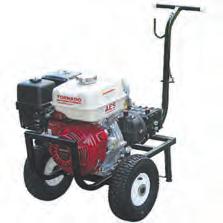

230 & 400 Volt 1440 RPM motor • 8 models from 1600 to 500 psi

New Zealand wine brand sales. He sees a promising future for nonalcoholic wines, noting that if that category could capture the same 1% share as beer, it would translate to an additional 4 million cases. For New Zealand, capturing just 10% of the no alcohol market would mean 400,000 cases of growth, largely incremental since 90% of non-alcoholic buyers also purchase alcoholic beverages. This segment also offers an opportunity to attract new consumers seeking sophisticated adult non-alcoholic drinks. Despite the challenging market, Danny concludes that New Zealand’s wine performance in the US is positive. There is potential to grow the share of Sauvignon Blanc in underdeveloped states (West and Northeast), expand the Pinot Gris footprint, and build on the momentum in the “better for you” segment, bolstered by early NPD and category development through the NZ Lighter Wines initiative. Richard Lee is Intel and Insights Specialist at New Zealand Winegrowers.

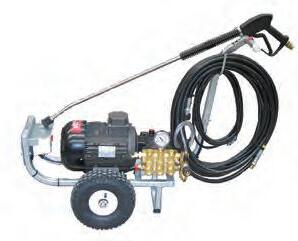
Rollercoaster sales, light harvest, rising costs & excess stock
SOPHIE PREECE
New Zealand’s wine regions harvested 395,000 tonnes of grapes in the 2024 vintage, which is 21% lower than 2023, nearly 30% down on the bumper 2022 crop, and slightly above the modest 2021 yield.
“After the roller coaster ride of the past four years, it’s a fair question to ponder, ‘is this the new normal?’” New Zealand Winegrowers (NZW) Chief Executive Philip Gregan told attendees at the three Grape Days events in June.
The 2021 and 2024 vintages are two of the three lowest yielding crops in the past ten years, despite growth in vineyard area, he said. “Sandwiched between them, vintages 22 and 23 are our two largest ever harvests.”
Meanwhile, demand for wine is flat to declining, costs are up, and “there’s an incredible degree of uncertainty about what’s going to happen in the year ahead”, Philip said, reflecting on “chaotic” GDP growth in 2020, and “anaemic” growth since mid-2023, with an impact on consumer spending.
A backdrop of high retailer inventory means the New Zealand wine industry is carrying much more stock that anyone projected at this time last year, “which is impacting profitability and cash flow”, Philip said. “There’s about 50 million litres of stock from vintage 23 out there that hasn’t been sold in the past 12 months.”
The lighter vintage will go some way to rebalancing that, with total sales currently at 320 million litres and the 2024 vintage set to produce 20 million litres less than that.
NZW board Chair Clive Jones says wine companies can delay the release of the 2024 vintage, in order to sell through 2023 stock. “We have got wine to sell. If we can get that wine to market over the next 12 months that’s got to put us in a better position. But we still don’t want a large harvest next vintage.”
Regardless of what nature serves up for harvest 2025, winery capacity may be a limiting factor, he adds, noting that while wineries were empty leading into the 2022 and 2023 harvests, some tanks remained
All Regions 2024
395,000
MARLBOROUGH
81.8% 312,812
HAWKE’S BAY
6.3% 24,143
CENTRAL OTAGO 3.0% 11,519
GISBORNE 2.2% 8,235
full going into vintage 2024 and the same can be expected going into the 2025 season. The industry has been bullish for the past couple of years, and now “it’s a steady the ship phase”, he says. “We need to be careful that we manage our way through.”
A lot depends on the next 12 months, Clive adds, noting that the past three to four months of sales have been positive. “We would hope that we are going to see stronger sales in the next 12 months than we did in the last 12 months so we can get through the surplus.”
Philip detailed a perfect storm of pressures being faced by winegrowers, including high interest rates and farm price inflation outstripping the Consumer
NORTH CANTERBURY 2.1% 8,216
WAIRARAPA 1.2% 4,625
NORTHLAND 159
OTHE R WAIKATO, BAY OF PLENTY & OHAU 384 NELSON 3.0% 11,593
AUCKLAND 0.2% 613
WAITAKI VALLEY 254
Meanwhile, competition from other beverages is growing and health and wellness trends are impacting market demand for wine, contributing to growth in lower and zero alcohol products. Demographic changes are impacting markets, and government regulation and taxes are also having a major impact. “These factors are contributing to flat or declining markets for wine.” *Estimated
Price Index. According to the Ministry for Primary Industries (MPI) Situation and Outlook for Primary Industries June 2024, “all parts of the industry are facing increased operating costs, further constraining profitability,” he told Grape Days attendees.
Export growth was “remarkably steady and consistent” through the 2010s, reflecting strong demand from key markets. “No wonder in 2010 that NZW felt confident to predict New Zealand wine exports would reach $2 billion in 2020, which they did.” Fast forward four years, and wine export revenue is forecast to decrease 13% to $2.1 billion in the year to 30 June 2024, with a high degree of uncertainty about sales in the year ahead, Philip said.
On the plus side, looking beyond declining export numbers New Zealand wine is performing “solidly” in most markets, with NZW member webinars over the past six months revealing good in-market sales performance and opportunities (see Intel and Insights on page 15). It’s “certainly not spectacular” but performing better than most, and there are still opportunities in market, he said, noting that the MPI outlook report predicts Sauvignon Blanc demand will remain strong from 2025.
“That is not to deny the tough market conditions, that the small sales gains have been very hard to achieve, nor the many immediate challenges confronting growers and wineries,” Philip said. “But the numbers confirm the reputation of New Zealand wine remains solid, and this a strong platform from which to build for the future.”

See more from Grape Days on page 29
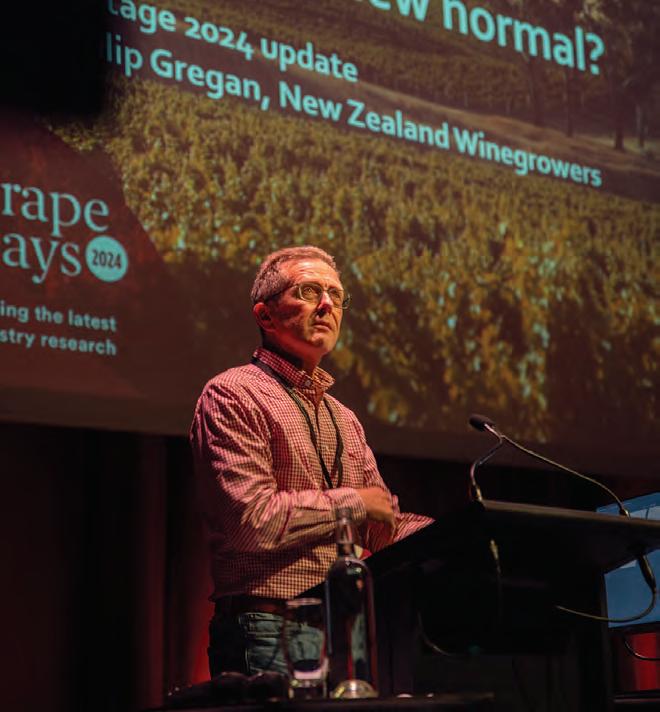

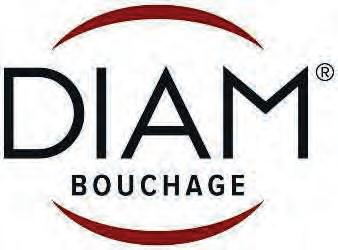
Diam Bouchage truly embodies the expression of a new closure tradition. The French company, respectful of the past and firmly focused on the future thanks to its unique cork closures, is today celebrating the 20th anniversary of the first Diam.
On this significant milestone, Diam Bouchage reaffirms a distinct vision and identity, namely a manufacturer of the future who combines authentic know-how and technological innovation. From the outset, Diam considered itself as the veritable guardian of aromas, a position recognized by winemakers, sommeliers, and consumers globally with whom Diam Bouchage shares a mutual passion for wine, and a love of things done well.
Diam Bouchage truly embodies the expression of a new closure tradition. The French company, respectful of the past and firmly focused on the future thanks to its unique cork closures, is today celebrating the 20th anniversary of the first Diam.
On this significant milestone, Diam Bouchage reaffirms a distinct vision and identity, namely a manufacturer of the future who combines authentic know-how and technological innovation. From the outset, Diam considered itself as the veritable guardian of aromas, a position recognized by winemakers, sommeliers, and consumers globally with whom Diam Bouchage shares a mutual passion for wine, and a love of things done well.
The Diam revolution, consistency and the end of cork taint.
The Diam revolution, consistency and the end of cork taint.
Cork is a fantastic natural material that has always been popular for its elastic properties and capacity to conserve wine over several decades by providing it with the respiration necessary for its development in the bottle. However, cork poses several issues: possible organoleptic contamination (cork taint) and heterogeneity discrepancies leading to wine development that is sometimes too slow but more often too rapid (premature oxidation).
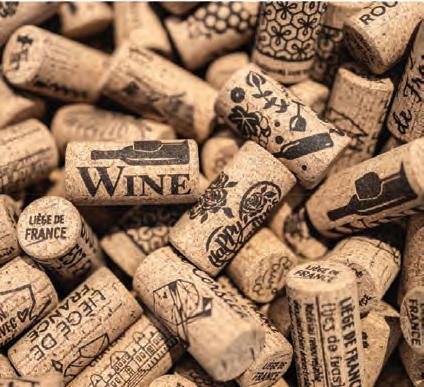
Cork is a fantastic natural material that has always been popular for its elastic properties and capacity to conserve wine over several decades by providing it with the respiration necessary for its development in the bottle. However, cork poses several issues: possible organoleptic contamination (cork taint) and heterogeneity discrepancies leading to wine development that is sometimes too slow but more often too rapid (premature oxidation).
in this way display unrivalled organoleptic neutrality* and best preserve the development of aromas in the bottled wine.

and its desired cellaring time.
In 2004, Diam Bouchage revolutionized the use of cork closures with groundbreaking technological innovations.
An innovation whose unmatched reliability still resonates as a paradigm shift in the world of wine: cork taint stopped being a concern 20 years ago for those who adopted Diam!
Diam Bouchage, the instigator of a new tradition.
The company provides numerous data and options for winemakers, enabling them to make the best choice for what they wish their wine to develop into. A choice that takes into account the characteristics of each wine, the development of the aromatic profile, the wine’s cellaring requirements, its enological journey and sensitivity to oxygen.
The company, its teams and winemakers share so much more than just customer relation, as they work together at nature’s tempo, guided by their experience: it is their choices that make all the difference.
• Selecting the best of what nature can offer
Its DIAMANT® process ensures deep cork cleaning thanks to the use of supercritical CO2 at differentiated pressures. This process is still unique in the market. It eliminates all TCA particles and many more molecules naturally present in the cork thanks to a solvent-free, non-chemical treatment that is respectful of the environment. Closures purified in this way display unrivalled organoleptic neutrality* and best preserve the development of aromas in the bottled wine.
In 2004, Diam Bouchage revolutionized the use of cork closures with groundbreaking technological innovations.
• Patiently harvesting the fruits of time
• Transforming raw materials
• And creating something unique.
An innovation whose unmatched reliability still resonates as a paradigm shift in the world of wine: cork taint stopped being a concern 20 years ago for those who adopted Diam!
Diam Bouchage, the instigator of a new tradition.
Its DIAMANT® process ensures deep cork cleaning thanks to the use of supercritical CO2 at differentiated pressures. This process is still unique in the market. It eliminates all TCA particles and many more molecules naturally present in the cork thanks to a solventfree, non-chemical treatment that is respectful of the environment. Closures purified
The pioneering company now sets the standards. Diam Bouchage also possesses specific manufacturing technology that enables the oxygen transfer to be precisely controlled in each closure, year after year, thus guaranteeing perfect consistency from one bottle to another.
By embracing values that have long been conveyed by the world of wine, Diam Bouchage aspires to be a company close to those who routinely chart new courses to meet tomorrow’s challenges.
The pioneering company now sets the standards. Diam Bouchage also possesses specific manufacturing technology that enables the oxygen transfer to be precisely controlled in each closure, year after year, thus guaranteeing perfect consistency from one bottle to another.
This incomparable process has made the closure more than a simple esthetic choice, but a genuine enological tool at the service of winemakers, who can now choose the oxygen input that is best suited to the aromatic profile of their wine
“Everything, from the vine to the glass, is a question of knowledge and decisions. Going well beyond a simple technical gesture, choosing the right closure is truly an enological act. It’s a new tradition that has now become firmly established with our clients, who day after day, through their vines, cellars and wineries, write unique narratives in which we play a role.”
Dominique TOURNEIX, CEO Diam Bouchage.
This incomparable process has made the closure more than a simple esthetic choice, but a genuine enological tool at the service of winemakers, who can now choose the oxygen input that is best suited to the aromatic profile of their wine and its desired cellaring time.
Diam Bouchage and the winemakers, a naturally inseparable duo
Fully engaged in research and innovation, Diam Bouchage is committed to supporting the authentic elaboration of a cuvee and envisaging, alongside winemakers, the future of enological tools which contribute to the pleasure of wine lovers.
The company provides numerous data and options for winemakers, enabling them to make the best choice for what they wish their wine to develop into. A choice that takes into account the characteristics of each wine, the development of the aromatic profile, the wine’s cellaring requirements, its enological journey and sensitivity to oxygen.
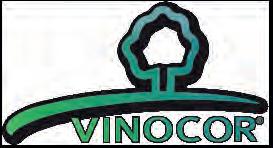
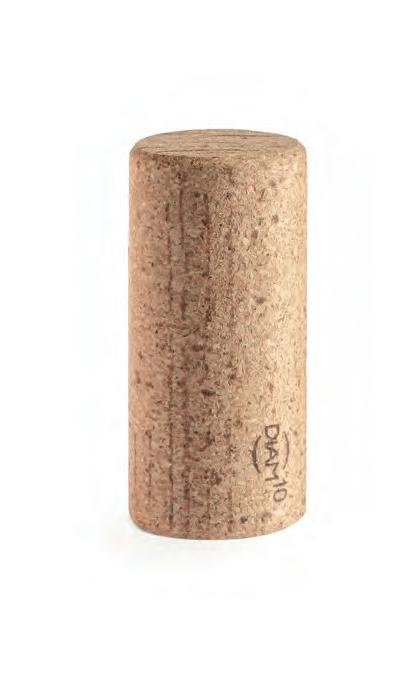


Three stalwarts of New Zealand’s wine industry have been recognised as the 2024 New Zealand Winegrowers Fellows, in recognition of their long commitment to the industry, pouring their passion, talent, intellect and experience into the betterment of New Zealand wine.
For services to winemaking
SOPHIE PREECE
Maté Brajkovich was 12 years old when he moved to New Zealand in 1937, bringing with him a heritage of winemaking from his village in Croatia.
His son Michael was the same age when he decided he would become a winemaker, carrying on the legacy of his family’s West Auckland vineyard and winery. “I think mum sat me down and said, ‘look you have everything here’,” Michael says more than 50 years on, having forged an extraordinary global reputation for Kumeu River Wines.
Michael’s academic bent, considered intent, and global perspective have been hallmarks of his winemaking success, as the Dux of Roseworthy College in 1981, New Zealand’s first Master of Wine in 1989, Chair of Judges at both the Air New Zealand Wine Awards and the Royal Adelaide Wine Show, and the 2024 Winemakers’ Winemaker, presented by the Institute of Masters of Wine and the Drinks Business.
It’s also seen him readily adapt over the decades, including jettisoning a Merlot dream when Auckland’s weather proved problematic, eschewing yeast inoculation in the 1980s to produce Burgundy-inspired Chardonnay, and moving entirely to screwcap in 2001 to protect the quality of his wines. “It is a very New Zealand thing that if something is not working quite right,
we have the ability to change quickly and move on,” Michael says.
A 2015 comparative tasting with Burgundy wines in London saw critics and wine writers put Kumeu River’s Maté’s, Coddington, Hunting Hill and Estate Chardonnays above a range of Premier Cru and top Village Burgundies, except for one, which was deemed first equal. That result, along with glowing reviews from the likes of Jancis Robinson and James Suckling, mean Kumeu River wines are on allocation in markets around the world.
“He has got to be our most respected Chardonay producer,” says New Zealand Winegrowers (NZW) Board Chair Clive Jones on the announcement of Michael as a 2024 NZW Fellow, calling him “a direct or indirect mentor to most premium Chardonnay producers in the country”. Larry McKenna has long worn the moniker of the Prince of Pinot, Clive adds. “Is Michael the King of Chardonnay?”
Multigenerational family business Michael is in Croatia when we talk, on the eve of a visit to Živogošće, the coastal town his grandparents Mick and Katé grew up in, working small plots of productive land. “Like everyone in the village, if you had a few vines, you made wine. Always a very good source of calories, that you could
store for the rest of the year. For my father, who was 12 years old when they came to New Zealand, it was the basis from which he started to make wine, and in particular red wine.” Maté, who was always a “forward thinker”, would go on to learn a lot more in New Zealand, including from Dalmatian colleagues in Henderson and his good friends Alex Corban, Tom McDonald and Peter Hubscher. “But the basics always went back to what was learned by my grandparents in the old country,” Michael says.
The Brajkovich family worked tirelessly when they arrived, first in the gum fields up north, and then in Henderson, taking jobs in local vineyards and orchards. “It’s the same immigrant story across all of New Zealand. They worked really hard.” By 1944 they had saved the £200 deposit for their Kumeu block, where they milked cows and grew grapes, strawberries and pumpkins. Mick died in 1949, but by the mid-1950s Maté and Katé had paid off the mortgage, while Maté grew the focus on San Marino Vineyards. He met his wife Melba in 1957, and in 1960 Michael arrived, followed by Marijana, Milan and Paul, all of whom worked in the winery from a young age, and remain with Kumeu River today.
Photo to left NZW Fellow Michael Brajkovich MW: “We never dreamed then we would have the kind of success we have had.”
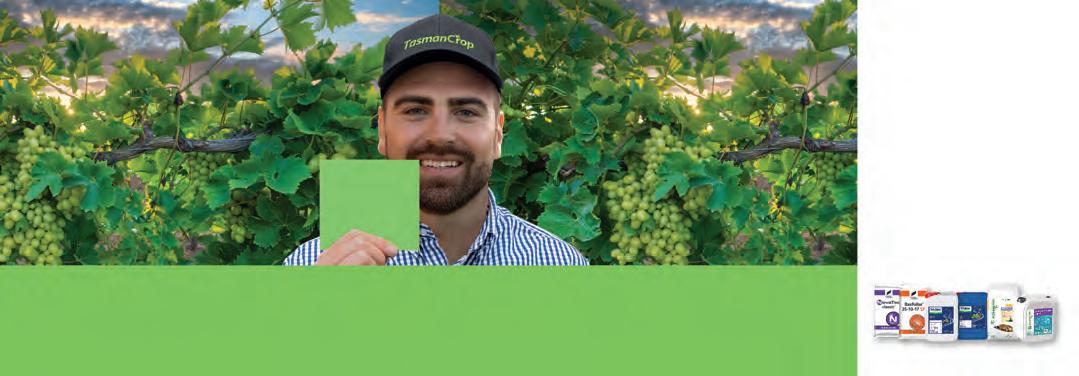
Maté would occasionally stand a threeyear-old Michael on a box in the winery, so he could reach the switch to the pump. “He’d call out to me to start or stop the pump. I can still remember being extremely bored.”
But Michael and his siblings learned a lot in their early years, in the winery and bottling line, making up cartons, and helping sell wine on Saturdays, when Aucklanders would drive out west for eggs, fruit, vegetables and wine. “We used to sell 90% of the production of the winery through the shop.”
Back then San Marino was mostly focused on fortified wines, but Maté’s Kumeu Red Dry had also gained “quite a reputation”, especially with WWII soldiers who had returned to New Zealand with a taste for that style, and for the vermouth he made on the side. By the 1970s San Marino was moving to table wines, as Müller-Thurgau gained popularity.
“It is a very New Zealand thing that if something is not working quite right, we have the ability to change quickly and move on.”
Michael Brajkovich MW
Then in 1972 Michael decided he would become a winemaker, focusing on sciences at high school, along with French, to ensure he could connect with a country he still deemed the “epitome” of winemaking. The same year Maté travelled across South Australia, visiting wineries and spending time at Roseworthy Agricultural College. “I still have the cassette tapes he had recorded each day,” Michael says, reflecting on his father’s excitement at the possibility his son might attend the college. Maté only had a primary school education, and he and Melba, who had studied teaching, gave their four children a “great work ethic” and a steady focus on the importance of education, Michael says. “It was, and still is, really high on the list of things – do well at school and go on to university. And all of us did.”
In 1981 Michael graduated from Roseworthy and joined the family business, nurturing dreams of Merlot, fuelled by the purchase of a Corbans Merlot vineyard. That focus saw him work with Château Pétrus in Bordeaux, producer of “the most famous and the best Merlot in the world”, he says. “What a great opportunity. I pinch myself even now. How did that happen?”
But Merlot struggled to ripen in Auckland,
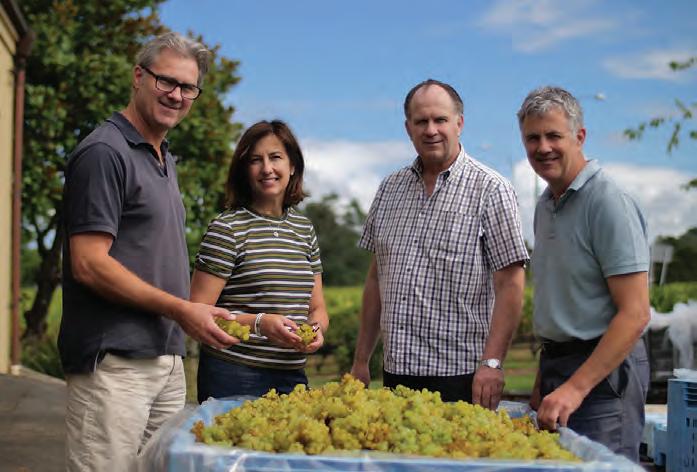
while Chardonnay proved itself every year, so they swiftly changed tack. Maté had planted Mendoza Chardonnay in the 1960s, but plantings in the early 1980s gave them access to newer clones and rootstocks, while the 1986 government vine pull enabled them to adapt. “We planted better varieties using better trellising design and making wine in a better way,” Michael says.
In 1984 he made a Merlot without inoculating with yeast, inspired by wild ferments he’d worked with in France. “We didn’t tell anybody we were doing it, because we thought people would think we were nuts.” Despite the success, with better texture, mouthfeel, and richness on the palate, he was reluctant to progress to the more delicate whites, until his brother Milan and Cellar Master Nigel Tibbits urged him to continue. “In 1986 we let the fermentations rip, and we haven’t looked back”. The Burgundy-influenced Chardonnays, featuring indigenous yeasts, extended lees ageing, and malolactic fermentation, changed the face of the company, renamed Kumeu River Wines in 1986. “But we never dreamed then we would have the kind of success we have had.”
Winemaker James Healy, whose groundbreaking Chardonnay made its mark on Cloudy Bay and Dog Point Vineyards for 30 years, had his first wine job at Corbans in Auckland in the early 1980s. There was a lot going on in wine in West Auckland back then, James says, recalling occasional drinks in the back of San Marino’s winery, where Maté Brajkovich held court. When Michael returned from Roseworthy, they struck up a friendship, and James watched with interest as Kumeu started to drop inoculation. Michael had a profound effect on New Zealand winemaking, but “he’s very
unassuming and modest”, says James, who joined Cloudy Bay in 1991, and immediately pushed for wild Chardonnay ferments, followed by Sauvignon Blanc the next year. “Michael was the inspiration to start not using yeast.”
In 2017 the Brajkovich family bought a new vineyard on Rays Road in Hawke’s Bay, where they are gradually planting more Chardonnay on a limestone hill, echoing the characteristics of Chablis, “with very pure vibrant mineral expression of Chardonnay”, Michael says. “It’s quite different to what we get in Kumeu.”
He visited beloved wine regions throughout France and Italy before his trip to Croatia, and says understanding the best producers in the world has been hugely important throughout his career. “They are the standards to which we hold ourselves, particularly Burgundy in our case… I learned from them back in the 80s and they continue to evolve and get better.”
But New Zealand producers have a cultural advantage in their ability to adapt, unhindered by appellations or attitudes.
“That’s a huge advantage for us and also why New Zealand as a winegrowing country has done so well in a very short space of time. We are willing and able to change and use science to advance our cause. As opposed to, ‘I do it because my grandfather did it’.”
Nearly 90 years after his own grandparents arrived in New Zealand, there’s a new generation of the Brajkovich family Michael hopes will soon join Kumeu River, while he and his siblings look to continued improvements. “Everything is about fine tuning now. Trying to find different angles.”

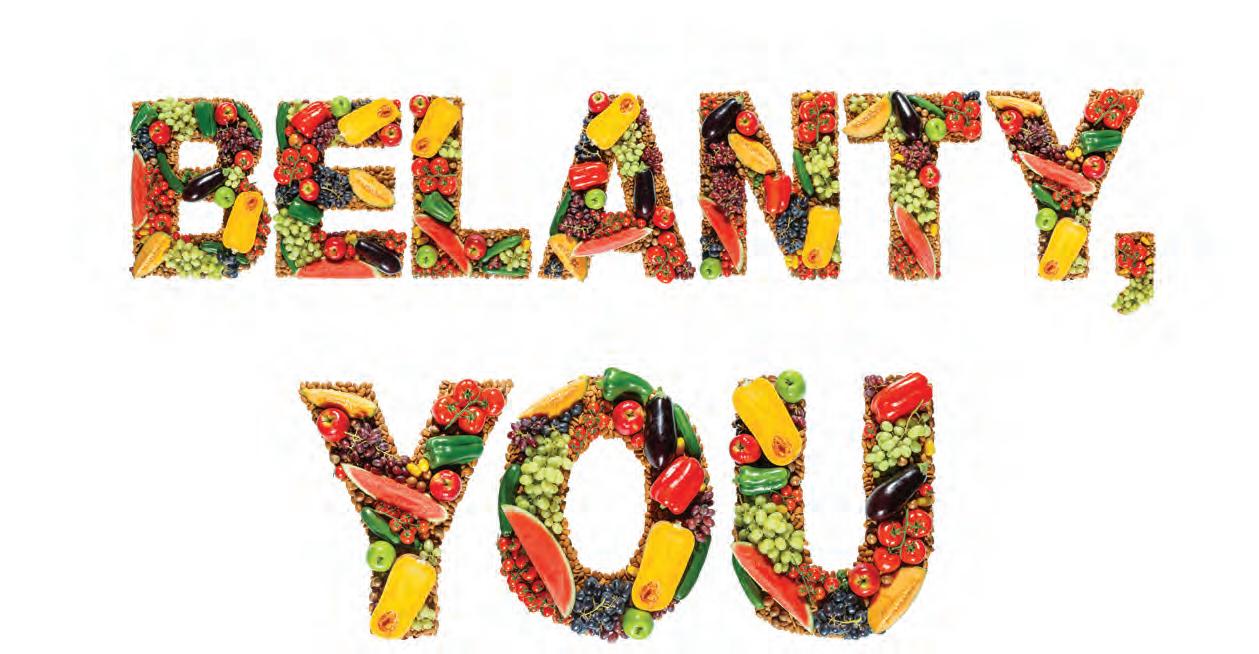

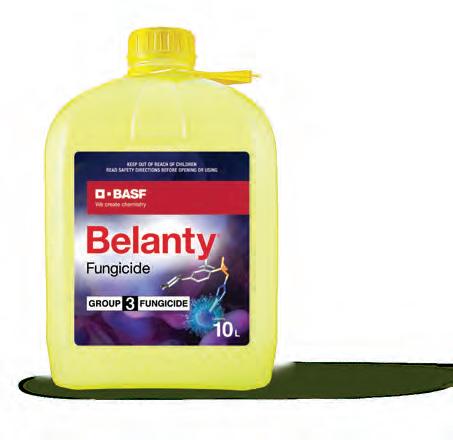

SOPHIE PREECE
When Nick Hoskins took up an apprenticeship with the Wellington Parks Department aged 17, he was simply keen on a job outdoors. But that foray into nursery production, botanic gardens, and sports field maintenance proved fortuitous for New Zealand’s wine industry, launching a career that would influence the outcomes of Wairarapa’s developing industry, the country’s Pinot Noir clones, the genetics and health of grapevines, and the smooth transition of wine research into the field, including his leadership of the seven-year Vineyard Ecosystem Programme.
“Nick truly is an industry taonga,” says Riversun Nursery founder Geoff Thorpe of the New Zealand Winegrowers (NZW) 2024 Fellow.
A Pinot Pioneer Fifty years after he took up his apprenticeship in horticulture and gardening, Nick says he wasn’t a great scholar in terms of biology or plants, but enjoyed the outdoor work and learned a lot along the way. He moved to Martinborough with his wife and young daughter in 1980, working on the farm and gardens of a big homestead. But as grapes were planted nearby, Nick’s horticultural skills were increasingly in demand, starting with work on Wyatt Creech’s vineyard. “There was no one with much skill in terms of plants and he asked if I would help him out, so I started working for him and we made a nursery to grow rooted cuttings.”
Nick went on to work with Larry McKenna at Martinborough Vineyards. “I didn’t know anything about training

grapevines. It was a little bit of ‘do stuff and see what happened’.” There was plenty of excitement about developments in the region, but far less experience, he says. “We were in the same boat as a lot of others planting vineyards at the time.”
Nick worked with Larry for 12 years, growing knowledge in the vineyard, and getting a taste of work in the winery at vintage, on the bottling line, and in selling wine at the cellar door. “It was the whole gambit, from start to finish.” They also had a wine tasting group, “which was a bit of an eye opener for me,” he says. “It was a lot of fun.”
Support from viticulturist Richard Smart and other wine researchers grew Nick’s appreciation for wine science, fuelled by myriad trials at Martinborough Vineyards. “Larry had a bit of fascination with science as well and we were always trialling things in the vineyard and winery that would give us points on the Pinot board. We were always looking at different ways of doing things.” His influence on the industry from those nascent days will see Nick recognised at the Wairarapa Wine Region Pinot Pioneers dinner in early August, alongside Richard Riddiford, founder of
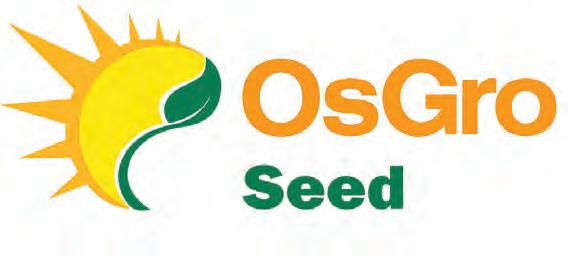
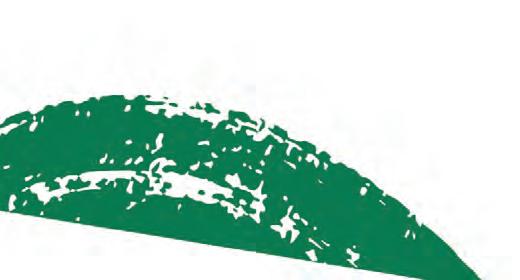
Palliser Estate.
“Nick has an exceptional ability to see the bigger picture in a very positive way,” Larry says. “He has a vision which includes and extends beyond many aspects of what he’s endeavouring to do.” He and Nick “grew up together” at Martinborough Vineyard in the late 80s and into the 90s, and Nick went on to become one of the most important people in the viticultural industry, Larry says. “In his work life he is very diligent, patient and knowledgeable, allowing him to calmly explain what’s required. His communication skills are at the heart of this approach.”
While at Martinborough Vineyards Nick was involved with the Wairarapa Grapevine Improvement Group, and was its Chair when he met Geoff Thorpe at one of the national meetings. The grapevine grafting aspect of Riversun was growing steadily and Geoff had become frustrated by the lack of progress on a draft certification scheme to ensure vines were true to type and not carrying virus. Throughout “quite tense and contentious national meetings”, Nick stood out as a voice of “calm, clear, unemotive reason”, Geoff says. “He would sit back

and listen to all the different viewpoints and once it was clear we had reached an impasse, he would speak quietly and table his thinking. And everyone would think about it for a minute or two and then go ‘yeah, great solution Nick’.”
Demand for vines exploded in 1998 and Geoff asked Nick to become Riversun’s client liaison. “I needed to focus on growing volumes, developing and incorporating quality standards into our own business, and we needed someone to support clients with site selection, what rootstock, variety, clone to order, how to prepare the land and plant, and look after their vines.” Nick, who had been at Martinborough Vineyards for 12 years by then, knew the role would take him further into the areas of genetics and vine health he was increasingly interested in. Geoff and he “share the passion for getting those things right”, he says. “Vine health is kind of a broad concept, but it starts at the nursery, so we have to make sure we’re getting the right plant material and it is what they say it is.”
After a year working remotely, Nick moved to Gisborne to be more closely connected with operations, and found himself liaising with Dr Rod Bonfiglioli,
who became the Technical Director when Riversun launched its Vine Certification programme in 1999. The scientist, with his focus on vine material health and diversity, was a great influence, Nick says. “I could offer him the practicality of what I knew and he could offer the science of what he knew.”
After three years in Gisborne, Nick returned to Martinborough, and in 2005 started Vine Managers Wairarapa Ltd, providing management for more than 150 hectares of vineyards. Then in 2009 Rod asked him to take over the three-year NZW Virus Elimination Project, which had just been launched in Martinborough and Hawke’s Bay. Nick thought the multimillion-dollar programme was beyond his skills, but Rod, who was terminally ill, was insistent. “He didn’t want it to turn into a science-fest,” Nick explains. “He wanted it to be a very practical project, which is what it ended up being.” Nick worked with science advisors and Rod’s widow Ruby, a skilled technical writer who delivered comms around the project. He loved the opportunity to ensure the science was practical for growers. “It’s
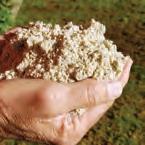
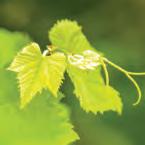
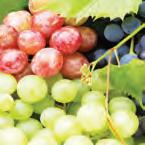

really about trying to drive those outcomes. And you have to start with industry outcomes in mind, in my view.” Scientists are not necessarily good at that, he adds, “but I have learned that they really value the input from other people, particularly people who are working in the field.”
The Virus Elimination project, which extended into a second period from 2012 to 2015, changed Nick’s career path. He went on to become the manager of NZW’s multifaceted Vineyard Ecosystems project, overseeing work being done by Plant & Food Research, Auckland University, and Linnaeus laboratory, along with other contracted research organisations.
On the conclusion of that programme in 2022, Nick wound up Vine Managers, and supported Riversun with inhouse research and development, along with client liaison, while helping develop BioScout, an agritech startup offering infield spore detection via cutting edge technology and artificial intelligence. He’s the perfect man to take that advancement into the field, concludes Geoff. “If anyone has the credibility with growers and wine companies to adopt such leading-edge technology, it has to be Nick Hoskins.”


100% natural, BioGro certified
Supplies readily available source of calcium and sulphate sulphur to support soil health and plant growth.
For more information scan the QR code or go to gypsum.co.nz





SOPHIE PREECE
A self-confessed “nerd” with a penchant for policy and a passion for sociology has been recognised for his commitment to New Zealand’s wine industry. Xan Harding’s road to Hawke’s Bay winegrowing veered from a horticultural science degree in Palmerston North to a banking career in China, via policy work in Wellington and a Muscatfueled epiphany on his 30th birthday.
“It didn’t take me long to work out that grapes are mostly about repetition and I needed stimulation off vineyards.”
Xan Harding
When he and his wife Ali planted vines in Hawke’s Bay in the early 2000s, Xan decided he’d keep just one foot in the vineyard, stepping the other squarely into governance. “It didn’t take me long to work out that grapes are mostly about repetition and I needed stimulation off the vineyards,” he says, looking back on 14 years with Hawke’s Bay Winegrowers, five years on the New Zealand Winegrowers (NZW) board and finance committee, two years with the Sustainable Winegrowing Committee, and a seat at the table of Hawke’s Bay Labour Governance Group, Hawke’s Bay Winegrowers Charitable Trust, and Hawke’s Bay Future Farming Trust. In 2022 he was elected as a councilor on Hawke’s Bay Regional Council, while growing biodiversity, electrification and organics on his own Bridge Pa vineyard.

“I am easily bored if doing one thing,” admits Xan, who has been made a 2024 NZW Fellow, recognising his dedication to industry organisations.
Hawke’s Bay Wine Chief Executive Brent Linn calls Xan “a fount of knowledge about what has happened and happening in the Hawke’s Bay Wine scene”. He has been tenacious, reasoned and collaborative in his approach to issues affecting the industry, and in particular with regard to water, Brent says. “Xan has always brought a very reasoned science-based logical approach, and often that is what is missing in some of these discussions.”
The road to wine Xan grew up in Upper Hutt, in a family of “Forest and Birders”, then studied Horticultural Science at Massey University. In 1987, with an honours degree in cell transplant vegetable production hot in hand, he grabbed a job in banking, “in the middle of a share market bubble”. Banks were keen to professionalise and were taking graduates from across the board, “and I could get paid double going to a bank”.
He moved to Auckland for five years as an ANZ cadet and corporate banker, before moving to Wellington for a stint of policy
work, which “reinforced my nerdiness”, he says. Put another way, “that refined my latent abilities to be analytical”. Four years in Wellington led to five years in China, first as the ANZ Group Representative for South China, then in Shanghai as China Chief Operating Officer in the lead up to Y2K. In the midst of that period, Xan had “a bit of an epiphany” while celebrating his 30th birthday in the White Swan Hotel in Guangzhou. “I had a beautiful Muscat and it was a lightbulb moment,” he says, calling himself an “enthusiastic quaffer” until that moment. “It triggered my thinking around the wine industry, and a great appreciation and interest in how fine wine can be.”
In 1996 he and Ali bought a block of land on the coast at Haumoana, which he believes had previously been a Corbans vineyard, prior to the government’s vine pull in 1986. The land was in a state of “rack and ruin”, but in 2000, five years after the White Swan epiphany, they returned to New Zealand and set about planting vines, tapping into guidance from industry pioneer Mark Nobilo.
The vines were barely in the ground before Xan was on the Hawke’s Bay Grape Growers Association, eagerly exercising his off-field talents. He was Chair of that organisation for


a few years as it wound down, and in 2006 helped write the constitution for the new iteration of Hawke’s Bay Winegrowers, before becoming Vice Chair of that industry association through to 2018, and a committee member until 2020. He far preferred the vice position to being chair, focusing on the “nuts and bolts” that support the industry. “So much of Hawke’s Bay Winegrowers work is representational and my personal view was that it was better a winemaker doing that stuff,” Xan says. “I had no desire to lead in that way.”
Instead, he spent 14 years behind the scenes, working with the accounting and administrative teams, while tackling issues of labour, water-related policy, and planning changes. Xan notes that others before him had done a good job in cementing the place in the District Plan for winegrowing as a vertically integrated industry, with accommodative rules in the plan around cellar doors, winery and grape production on one site. “I was involved in various efforts to preserve that kind of regime and deal with other things that came along, like gas guns and frost fans. Fairly quickly that grew into the wave of more popular concern about the state of waterways in the early 2000s.”
Wine into water
Xan became increasingly involved in catchment conversations, linking communities, council and the wine industry, including as an industry representative in the council plan for the integrated management of land and water resources in the Tūtaekurī, Ahuriri, Ngaruroro and Karamū (TANK) catchments. “I became the go to person to represent Hawke’s Bay Wine’s interests in water and environment and environmental regulation.”
He had worked and travelled in China’s Pearl River Delta, so knew how bad a degraded waterway could be. However, he doesn’t call himself an environmentalist (“such a loaded term”), considering ‘humanist’ a more apt description. When he turned 50, he took on a research project that combined the two, following his Diploma in Environmental Management with a Sociology Masters looking at the relationship between catchment groups and Te Mana o te Wai, a te ao Māori concept encompassing the relationship between water, environment and communities.
Six months into his still-uncompleted studies Xan was offered a job with the regional council as a senior advisor on TANK catchments, so stepped out of the talk and into the walk of the topic. Then in late 2022 he was elected to Hawke’s Bay Regional Council, bringing his experience as a grower, a humanist, and a “wanna be sociologist” to the role.
Amidst all of this, he and Ali still grow grapes, with a vineyard in Bridge Pa, where they’ve planted a corridor of indigenous species between blocks to attract native birds, insects, skinks and geckos, have solar panels for irrigation, run a fleet of Nissan Leaf electric cars, get around the vineyard on electric bikes, and should reach full organic certification for their Syrah and Cabernet blocks this year. The measures are about growing biodiversity and responding to the threat of climate change, which was apparent before Cyclone Gabrielle hit vintage 2023, with earlier bud burst and ripening year on year, Xan says. But having a climate-driven cyclone make “a hell of a mess” in your region puts you automatically into adaptation mode, he says. “Your lofty ideals around mitigation go right out the window in cold hard practical terms when you are hit by such an event.” Other wine regions in New Zealand and abroad are “just one climate-exacerbated weather event away from a similar experience,” he adds. “We can only hope and plan that collectively we can learn from that and have enough time up our sleeves to do something about the root cause.”
Now, nearly 30 years after his muscat epiphany, Xan is juggling another ball, as General Manager Operations and Sustainability for Japanese company Greencollar New Zealand. “This is such a wonderful opportunity for Hawke’s Bay because they have aspirations to grow 100 hectares of individually hand sculpted bunches.”

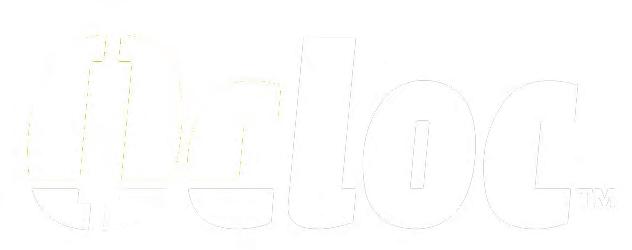
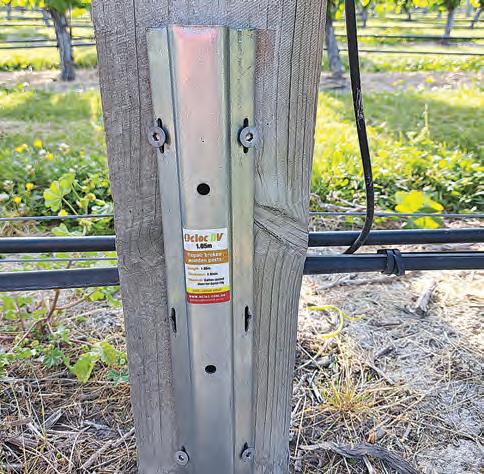

ADVANTAGES
• Ocloc repair posts are an inexpensive fix for broken wooden posts
• Keeps existing posts in the ground acting as a secure repair
• 20% the cost of post replacement
• Single pass repair, no wire removal required
• No post removal, no post graveyard
• Available in Galfan coated high tensile streel for strength and durablity
“The Ocloc repair system is a great low-cost strong fix for what has been a very expensive problem, until now.”
– Richard Leask, Leask Agri
ABLE TO BE INSTALLED ALL YEAR ROUND

CATHIE BELL
Two studies in Marlborough reveal changing the way vines are pruned and treated for trunk disease could save money without impacting quality.
“We need to keep tracking the vines to understand what impact trunk surgery has on vine productivity.”
Dr Eline van Zijll de Jong
Grape Days attendees in Marlborough, Central Otago and Hawke’s Bay heard from Bragato Research Institute (BRI) Viticulture Field Research and Translation Coordinator
Yuichi Ando, who presented the findings of a long-spur pruning trial in three Sauvignon Blanc vineyards, assessing the impact on quality and cost.
A vineyard using the standard four cane pruning method was assessed against one using a four bud-spur vine method and one using a five bud-spur vine method. The study found no difference in disease rates, or the incidence of botrytis or powdery mildew. Both long-spur treatments produced a smaller harvest bunch weight, resulting from lower berry number, but the different pruning methods had no effects on overall yield, wine acidity or volatiles. There were savings of up to 80c to $1.40 in the long-spur treatments, although that depended on vineyard management, Yuichi said, explaining that cost savings are not expected in the conversion year. The trial also revealed that not all vineyards are
suitable for long-spur pruning. Conversion could take up to two years, and Yuichi’s advice was to not try everything at once. Taking time and using care could improve the longevity of the cordon and prevent additional maintenance costs, he said.
Dr Eline van Zijll de Jong, from Linnaeus Laboratory, presented on the management of grapevine trunk disease through remedial surgery. The surgery – cutting out pieces of the trunk where disease is showing – can be used to help the vine return to health without having to take the whole vine out and replace it, potentially saving costs.
A five year project assessed three vineyards, two in the Hawke’s Bay – one Cabernet Sauvignon and one Merlot - and Photo on left: BRI Interim Chief Exective Dr Bruce
“If you don’t want any stress, buy a Europress”. With the perfect combination of power and control, the Europress cares for your grapes as much as you do. Easy to use and even easier to clean, more juice per tonne with preset and individual programs.
Find out why so many winemakers rely on the Europress.
Planning for Vintage 2025? Call to discuss the range.


04 390 3577 grapeworks.co.nz
one organic Sauvignon Blanc vineyard in Marlborough. The results were consistent across all three, she said.
Prevention of infection is vital, and there is no cure. She recommended viticulturists intervene early when trunk disease was detected. Trunk surgery needs to cut as low as possible to eliminate as much of the pathogen as possible. There appeared to be no difference between vines cut in winter and those cut in spring, althought spring might be better to avoid frost damage. “It is early days. We need to keep tracking the vines to understand what impact trunk surgery has on vine productivity. There was no effect on wine quality. Some productivity gains were recorded.
Grape Days are a New Zealand Winegrowers and BRI initiative to provide high-level overviews of the latest industryfunded research, with an emphasis on applied science.
Growers spoken to at the Marlborough event said it was a useful and worthwhile session. Whitehaven’s Andrew Holland said it was good to hear what PhD students had found in their research. “Some of the things are anecdotally known in the industry; to have proof behind it is interesting, if nothing else.” Foley Wines’ Kevin Ryan said he looked for something to take away when attending Grape Days. “It makes people think about the long term. You can’t sit on your laurels.”
Exploring root stock opportunities
RACHEL PETRIE
Microbes could complement irrigation in New Zealand vineyards, growing the resilience of vines, says Dr Solomon Wante, a Research Associate in the BRI Grapevine Improvement team.
At the Grape Days events, Solomon shared findings that Trichoderma has demonstrated ability to mitigate biotic and abiotic stresses, attaching themselves to roots to create a symbiotic relationship, with potential to mitigate the unpredictability of climate change-induced drought stress.
Solomon inoculated potted vines grown in two different Marlborough soils with Trichoderma then monitored drought stress, stomatal conductance, stem water potential, photosynthesis rates, and root biomass, under controlled conditions in a glasshouse at Lincoln University. The biggest finding was a consistent increase in route biomass in all replicates regardless of the irrigation method.
BRI Knowledge Transfer and Engagement Leader Braden Crosby continued the

theme of climate change and applying less irrigation, sharing information on a rootstock project studying the influence of deficit irrigation on a 30-year-old repository of 11 different rootstocks at Pernod Ricard. The project was led by Yuichi Ando, with the help of Dr Mark Krasnow, of Thoughtful Viticulture, and Dr Stewart Field, a lecturer at Nelson Marlborough Institute of Technology (NMIT). “Understanding rootstock performance in a changing climate will be key to ensuring our plantings today are robust for future environments,” Braden said. “Investigating vine water usage and key performance metrics under a stress condition will hopefully lead to a wider array of genetic material planted for these future challenges.”
Central Otago Grape Days included a summary of the data gathered so far by Otago Polytechnic from the clonal repository in Central Otago, run in partnership with Riversun Nursery, which has 12 clones of Pinot Noir. Attendees also heard from BRI Research Winemaker Ngarita Warden on the wines produced from the trials. Mark Naismith, Vineyard Manager at Te Kano, said the Polytech and BRI clonal trial information was enlightening. “To see the clonal traits matching what most Central Otago growers would describe as anecdotal adds verifiable weight to good planning and design. The ongoing wine trials will certainly assist in discussion around desired wine styles and economics.”
Optimal hang time for Pinot quality
A trial comparing the impact of ‘hang
time’ on red wine quality was also on the stage at Grape Days. Dr Damian Martin, Science Group Leader at Plant & Food Research’s Marlborough site, covered a 2021 collaboration between Plant & Food Research, a commercial Marlborough winery and NMIT, assessing grape sugar loading and harvest date implications for red winemaking.
Detailed Pinot Noir berry sampling was conducted to determine the end of sugar loading, with three successive harvests –nine, 21 and 28 days after sugar loading –undertaken in the same Marlborough Pinot Noir block. “Sugar loading occurs from berry softening to maximum berry size – about 22 brix – and is reliant on photosynthesis and osmotic potential gradients,” Damian says. “Hang-time is the period from the end of sugar loading until harvest and involves berry dehydration and cell death, so has nothing to do with photosynthesis. You need fast sugar loading to allow enough hang-time for good things to happen before the berry’s ‘use-by’ date expires.”
Both commercial scale ferments and replicated small-scale wines were made, and overall quality, typicality, concentration, body, sweetness, and flavour intensity were rated lowest in the first pick, but not different between the second and third. Astringency was highest in the third pick, while the 21st day pick was softest. Wine anthocyanins were 50% higher in the early pick, while total phenolics were not different between picking dates, Damian said. “Our results indicate that the optimal picking date for Marlborough Pinot Noir in 2021 was about 21 days post sugar loading.”


A new experimental facility in Blenheim will help grape growers adapt to the changing climate. Te Whenua Tupu, the Living Lab, was launched in late July at the New Zealand Wine Centre Te Pokapū Wāina in Marlborough. It will allow researchers to study the effect of the environment, both above and below the soil, on growth and development of plants, and develop tools and technologies to help future-proof the horticultural sector.
“The
changing climate adds new challenges to the horticultural sector in New Zealand and globally, and finding new ways to grow crops is vital to future-proof the sector.”
Dr Damian Martin
“The changing climate adds new challenges to the horticultural sector in New Zealand and globally, and finding new ways to grow crops is vital to future-proof the sector,” says Dr Damian Martin, Science Group Leader Viticulture and Oenology at Plant & Food Research. “This new facility allows us to understand how environment influences the growth of plants down to the cellular level, and helps us develop new tools and technologies to grow our crops in existing or new regions.”
The Living Lab is based in a 600m2 shelter with space for 48 full-size potted plants to be grown and studied in a highly-instrumented, highly controlled environment. The facility also includes covered outdoor education spaces, which will support training of students, growers and industry representatives in new growing techniques.

This dynamic series of research presentations from organisations within the New Zealand Wine Centre – Nelson Marlborough Institute of Technology, Plant & Food Research, and Bragato Research Institute – is designed to provide quick and insightful snapshots of key findings, methodologies, and potential implications of research being undertaken by the Wine Centre’s research community. Each session is dedicated to a specific theme. Remaining sessions for 2024 are August 26, September 30, October 28 and November 25, from 1.30 to 3pm.
Contact Stewart Field (stewart.field@nmit.ac.nz) to be put on the mailing list.

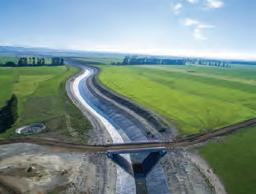

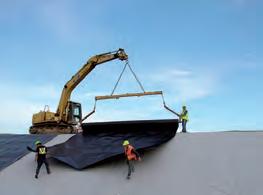
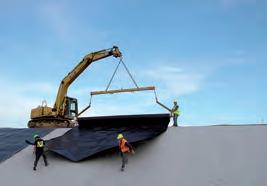
Viking Containment is New Zealand’s leading supplier and installer of geosynethic products for the primary, civil and building construction sectors.
Viking Containment is New Zealand’s leading supplier and installer of geosynthetic products for the primary, civil and building construction sectors.
Geomembrane Liners for
Geomembrane Liners for
➤ Water Storage Dams
Landfill & leachate
➤ Irrigation Canals
➤ Frost Protection
Potable Water Reservoirs
➤ Wasterwater Lagoons
Wastewater Lagoons
➤ Dairy Effluent
➤ Floating Covers
Irrigation & Dairy Effluent
➤ Baffle Curtains
Floating Covers
Baffle Curtains
Geosynthetic Products
➤ Bentomat®
Geosynthetic Products
➤ Geogrids
➤ Geosynthetic Clay Liners
Bentomat ® Geosynthetic Clay Liners
Geogrids
➤ Geocells
Geocells
➤ Geocomposits
➤ Geotextiles
Geotextiles
Associated Products
Associated Products
➤ Geoladder®
Geocomposites
➤ Depth Gauge
Geoladder ®
➤ Geolock®
Geolock ®
Depth Gauge
➤ Viking Vent
Viking Vent

JOANNA GRIGG
After listening to Emily Blumenthal at the WinePro session on artificial intelligence (AI), the first thing I did was download Google Gemini. After bombarding it with questions, like a persistent four-year-old, the potential of this tool started to dawn.
Yabble, where Emily is an AI Growth Consultant, is a New Zealand founded, global tech company that develops and integrates AI platforms. By bringing platforms together, they become more powerful, insightful and useful, she says. Yabble works with businesses, including Fortune 500 companies, to incorporate AI into the way they gather insights, but is yet to work with a wine company.
Emily demonstrated how AI could be used to improve a wine company’s marketing success rate, by understanding and testing consumer perceptions.
“Don’t just rely on AI; do speak to actual consumers, but it’s a great way to start and test concepts.”
She started the session by using Google Gemini to create personifications of different wine varieties, based on tasting notes. Sauvignon Blanc was a pale blonde with green eyes, looking like a free-spirit, and Merlot was a groomed bearded man. Pinot Noir was a redhead woman, with pale skin and vintage accessories.
Emily divides AI tools into two models: the generic ones like ChatGPT, Gemini and Bard, which tend to always want to please. The second are specific or multimodel AI tools, like the one that Yabble has developed. “It is more truthful, exists in a walled environment so data is kept safe, and it doesn’t hallucinate due to poor data feeding in.”
Emily says one benefit of AI is augmenting consumer voices by tapping into data on consumer wishes. It can draw upon consumer sentiments by accessing social ratings, online comments and chats. “The biggest gain I’ve seen by using it, is improving customer experience.”
AI is also ideal for finding and presenting structured data, like finances, sales and production figures. Emily


gave examples of using AI to test a wine product with different consumer persona. AI developed the persona then asked them questions about what aspects of the wine and packaging were important to them.
Two examples were the Serious Saver identity and the Health-Conscious identity. Meanwhile, the Gen Z identity listed sustainable ethical practices and a credible marketing story as being important. This type of person was highly influenced by social media, especially celebrity collaborations. Lighter wines were of interest and aesthetically pleasing packaging was very important to this person. ChatGPT predicted that the most popular drink for Gen Z would be La Croix, Red Bull, Monster Energy, Starbucks, and Gatorade. “It can provide
quite good probability that the result is current and up to the minute.” Another benefit of AI is speed of research. When asked how grapes could knock gin off its perch, AI came up with the idea of grapebased brandy, Emily says. “Maybe the next hot spirit.”
ChatGPT has grown to one hundred million users within two months but New Zealand is very conservative in AI uptake compared to the United States. “It is important to keep pace,” Emily says. “We are releasing upgrades at Yabble every two weeks. Some technology being used by Coca Cola is only four months old.”
Some bigger companies are building their own AI systems, but Emily says using an external supplier is a way to keep up with the rapidly changing field.

Yabble cofounder Rachel O’Shea is one of the speakers at the New Zealand Winegrowers 2024 Wine Business Forum in Wellington on 29 August. Rachel, who has worked globally in the wine industry for more than 15 years, has also worked with Generative AI technology since its early commercial inception. Rachel is focused on helping global companies drive efficiencies, process improvements and new and different ways to do business more effectively.
nzwine.com/en/events/altogether-unique-2024
When work shouts you one educational trip a year, why not choose one halfway around the world? Isabella Pucci-Schaefer, Assistant Winemaker at 21 Brix, a small family winery in Portland, New York, chose WinePro as her educational trip based on the speaker line-up, especially the session on artificial intelligence. “I’m really interested in AI but also am also taking the classes on fining agents and the New Zealand wine industry.”
The inaugural WinePro was held in Blenheim on 26 to 28 June with a major trade expo, packed conference programme, Women in Business breakfast, and Dragon’s Den startup event. Wine Marlborough General Manager Marcus Pickens called it timely for New Zealand’s wine industry. “There are so many exciting research and agritech developments in the field, in the lab, and on the horizon right now. They are changing the face of our industry, able to improve our emissions, waste, wine quality, and health and safety.”
Speaking on the second day of the event,
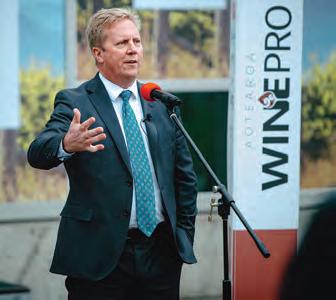
Marcus said technology and research was helping the wine industry approach the challenges of climate change, labour supply and surging vineyard costs, along with industry ambitions to grow circularity and sustainability. “Seeing industry engage with suppliers, agritech startups, and science providers like Plant
Removes soil compaction and lets oxygen into the soil which helps release locked up fertiliser. Aeration also helps with drainage.
& Food Research is exciting, because they are growing solutions to all of those challenges.”
The conference programme – which included everything from electrifying viticulture operations and managing labour challenges to utilising artificial intelligence and improving circularity – was a powerful opportunity to glean insights from experts across an array of wine-pertinent topics, Marcus said. “We have gathered an extraordinary lineup of speakers and it’s been great to see the industry so engaged.”
The event was an opportunity to celebrate New Zealand’s international reputation as a wine producer and cement Marlborough’s place as a hub of technology and innovation, said Marlborough mayor Nadine Taylor at the event launch. “WinePro provides an opportunity for suppliers and innovators to come together and learn about the latest developments and discover new ways to grow their business and improve production.”

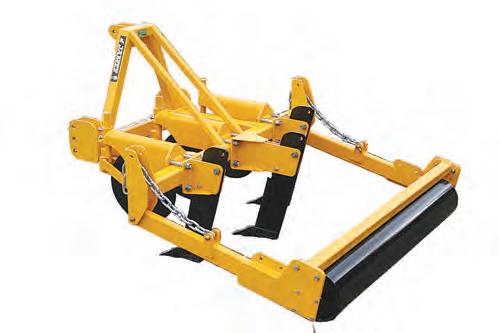

The Aerator is also used for root pruning which will produce new feeder roots and better production.
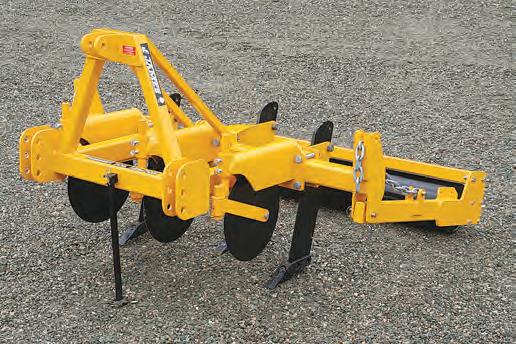
Specialising in all aspects of vineyard and winery valuation, including specialist plant and machinery. Experienced in all South Island wine growing regions.


SOPHIE PREECE
RNA technology could be a gamechanger in vineyards, with the ability to turn gene expression on or off to protect a vine or boost its performance, says molecular biologist Dr Ellie Bradley.
Once developed, it is conceivable that ribonucleic acid technology could reduce the need for chemicals targeting pests and pathogens in vineyards, and that a grower facing a drought year, for example, could use an RNA-based spray to change gene expression patterns and improve the vines’ resilience to water stress.
“That’s a really key part of what we are interested in,” says Ellie, a postdoctoral researcher on the Bragato Research Institute (BRI) Grapevine Improvement team. “It’s a response that is highly specific and transient, so you can adapt to the environmental conditions you are facing that year, and work with the existing vines and their genetic material.”
RNA is essentially the “messenger” in the cell, carrying genetic information encoded in DNA to the machinery that is responsible for making functional proteins. It also acts to regulate the expression of genes, turning them on and off, Ellie says. “Because of this, by changing the levels of RNA in an organism we can make functional changes in a way that is temporary and doesn’t result in changes to the DNA. Meaning this technology is non-GMO.”
Ellie will discuss the potential of RNA technology at BRI’s Research and Innovation Forum in Wellington on 30
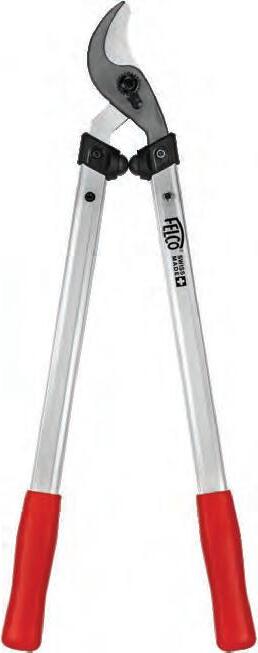


August, including an overview of the Grapevine Improvement team’s two-year Tuned Vines programme, which is working to find epigenetic markers, such as which genes are activated or silenced when a grapevine is water stressed. The project is also seeking proof of the concept that small RNA molecules, applied to the vine as a root dip or by spraying the leaves, could be used to ‘tune’ vine responses.
The ability to specifically silence genes using RNA was discovered in the 1990s and over the past few decades the understanding of the mechanism has grown, Ellie says. When it comes to vines, there are plenty
of challenges to be tackled, “including ensuring we understand the inherent specificity of the technology to avoid silencing non-target genes”. The fact that RNA degrades rapidly in the environment is on one hand a boon, allowing for reactive responses to environmental changes without impacting long term gene responses. But it’s also a challenge, with methods required to stabilise it long enough to be effective, Ellie says.
Despite her many caveats on the wealth of research still to be conducted before the technology is available, “it’s hard not to be excited”, she admits. “It’s very cool.”

The potential of RNA technology in vineyards is one of the discussions at the Research and Innovation Forum in Wellington on 30 August, being held as part of the New Zealand Wine, Altogether Unique 2024 programme. Dr Ellie Bradley of the Bragato Research Institute (BRI) Grapevine Improvement team will be joined by biochemist Dr Wayne Patrick, Victoria University’s Associate Dean of Science, who will canvas the role of enzymes as precise tools of winemaking, and the role of AI and machine learning in engineering enzymes with new and improved properties. Along with presentations on cutting edge innovations, the forum will include the launch of the New Zealand wine industry’s Roadmap to Net Zero 2050. See page 54 for more.
The
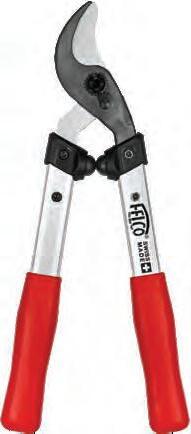

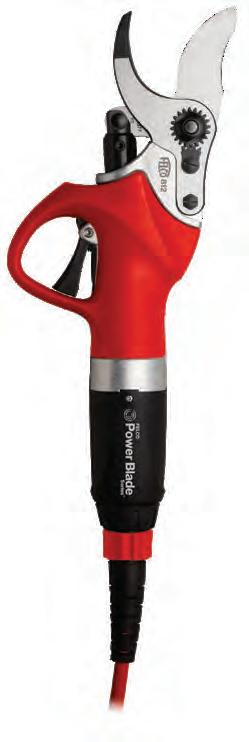

SOPHIE PREECE
A project tapping into financial information from organic winegrowers will result in hard data to back up anecdotal accounts, says Framingham viticulturist James Bowskill.
His Master’s project, funded by Organic Winegrowers New Zealand (OWNZ) through Lincoln University, will look at the financial implications of running a fully converted vineyard organically, including costs, yields, fruit price and wine price. “Hopefully it will give us average costs of production and return per hectare,” James says. “It would be great if people can use these warts-and-all figures to see if organic production stacks up financially and makes sense for their operation.”
But the process is “an unbelievably big can of worms”, he says. “People had to sit down and slog through a very


complicated, time consuming and very private spreadsheet.” In order to make the task viable in a one-year study, the research will not compare conventional and organic grape growing, but people will be able to consider the results against the Ministry for Primary Industries (MPI) vineyard benchmarking reports. Thanks to “awesome” support from New Zealand Winegrowers and MPI, James has been able to use the same definitions for a lot of costs.
He believes the project is overdue, with people long relying on anecdotal reports when considering a transition to organics. It’s information that would have been useful to Framingham when it converted a portion of its vineyards to organics in 2012, relying largely on personal experience reports from others. “What people were saying is not what we were seeing,” he says. That’s a personal view, he adds. “I don’t think we are alone in that. If this report goes well and we get a lot of high-quality participants, we can have some numbers instead of just anecdotes.”
The report will also include data from organic growers who make and sell wine, reflecting the price of wine sold and any advantages of that, he says. “Is it more viable
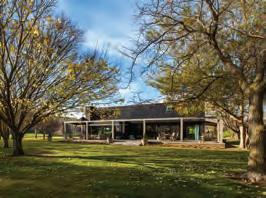


to be vertically integrated than just being a grower?”
James sees the study as a good follow on to the Organic Focus Vineyard project, which ran from 2011 to 2014, with three focus vineyards in different wine regions used for wider industry learning. “It was really cool at the time, with lots of information about the conversion period across the three regions in New Zealand,” James says. “It got a lot of the conversations going. Hopefully this can be a next step.”

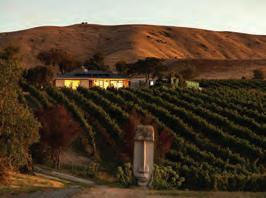

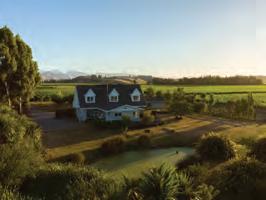

NADINE WORLEY
New Zealand’s wine industry needs to change the way it talks about packaging, say industry leaders in an “expanding niche market”.
The Alternative Wine Packaging webinar was hosted by Tim Nowell-Usticke from WineWorks, which will soon install a pilot bag-in-box plant at its Marlborough bottling plant, and Dr Edwin Massey, New Zealand Winegrowers General Manager
Sustainability, who sees alternative packaging as part of the industry-wide goal of being net zero by 2050. “Through data collected through Sustainable Winegrowing New Zealand, wine packaging makes up at least 44% of the total footprint of a bottle of wine,” Edwin says.
The webinar brought together experts and innovators behind new wine packaging, starting with Chris Archer from Joiy Wines, which has exclusively used cans since launching with a Riesling in 2017. It now has Marlborough Sauvignon Blanc and Central Otago Pinot Noir in cans as well as Mimosa and Sangria. “At the end of the day it’s the magic that’s inside the packaging that the consumer is buying,” Chris says, noting there’s no loss in quality in moving to the canned format. “Our wines age exactly the same as a screw cap glass bottle… Our sulphur losses are the same. From a quality perspective, I am 100% behind using cans.”
One of the main challenges in using cans is the large minimum run quantities for can manufacturers, with requirements of up to 150,000 units in New Zealand, Chris says. However, there are also big benefits, including weight reduction. “One tonne of aluminium can make enough cans for about 20,000 litres of wine, compared to one tonne of glass at only 1,825 litres.” They have also seen a 40% reduction in fuel costs for transport.
The environmental benefits of the packaging options presented in the webinar, in particular the decrease in carbon emissions, was a common theme among the presenters.
The webinar also included producers of innovative wine packaging not yet used in New Zealand. Santiago Navarro, chief executive and co-founder of Packamama, describes his company’s flat-pack wine
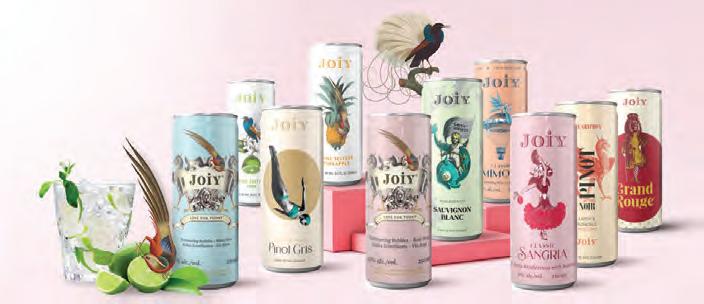
bottles as “better wine bottles”. They are made from recycled PET and are significantly lighter than glass at only 63 grams per 750ml, with “only half the emissions compared to glass”. Santiago says the unique shape means the bottles can be flat and crossed-packed, allowing about twice the amount per pallet compared to glass bottles. “Innovation is key… the New Zealand industry needs more choice,” he says.
Another low-carbon format getting a lot of attention globally is the Frugal bottle from United Kingdom-based Frugalpac. Commercial Manager Ciaran Dickson says the bottle, which is made from paper outer and food-grade plastic inner, has a carbon footprint six times lower than glass bottle. He sees two advantages of the Frugal bottle over other packaging: “Consumer acceptance, as it is a 750ml Bordeaux shape, and also for 360-degree branding, which really appeals to the younger consumer.”
Matt Dicey also discussed the importance of market acceptance when sharing Dicey’s journey to get their Central Otago wines into bag-in-box format. Matt says they have seen more acceptance in restaurants and on-trade due to the lack of wastage, but the task has been harder in some more traditional wine stores. “ There are always going to be those that do and those that don’t.”
Getting their wine in a bag-in-box wasn’t easy. “There have been lots of learnings and people helping with information the whole way through,” Matt says. He shared their journey, including importing their own semi-automatic bagging machine and sourcing recycle-ready mono material bag boxes with a lower oxygen transport rate.
Like Chris, Matt says one of the biggest challenges was minimum run sizes. “An example is the bags – we had to buy 10,000 units. We have subsequently sold on about 3,500 bags to other producers keen to start their own journey. As more producers put high-quality wine in bag-in-box the better the market acceptance will be, he adds. “The more people beating that drum the better.”
Neil Pollett from Green Bottle is currently exploring a re-use scheme with the Visy 415g wine bottle, “the most commonly used wine bottle in New Zealand”. The company has tested the bottle extensively with partners in Germany, Neil says. “We are confident that bottle can be used immediately for re-use.” Green Bottle has done a lot of work modelling the carbon emission of refillable glass, showing the average single-use wine bottle in New Zealand produces 370g of carbon in production, while refillable glass produces only 22g. “In a nutshell, one recycled glass bottle is roughly equal to the carbon emissions of 20 reused bottles,”

A new $130 million can manufacturing facility will launch in South Auckland on 9 September, with minimum order quantities of 30,000 printed cans. Recorp’s newly appointed Chief Executive Bruce Parton says that will open up the market for smaller businesses, including wine companies, to explore alternative packaging. “Our team of New Zealand investors, experienced can makers and innovators is ready to challenge the status quo, by offering customers of all sizes flexible, innovative new can options, low minimum order quantities and accelerated new product development timelines.”

Neil says. They’re not changing wine packaging, just the way it’s dealt with post consumption, “by washing not melting it”, he adds, calling it an “evolution not revolution”.
A recent survey conducted with Auckland Council saw more than 90% of participants say they would like to start reusing instead of recycling all their empty bottles with wine bottles being the most popular option for a re-use glass trial. “That was a pretty resounding ‘yes’ from the consumers.” He hopes wine companies will consider the Porto Protocol global reuse campaign, which asks wineries to move to labels that can wash off, so they are “reuse ready”, with the added bonus of being compostable. “Without that small label change we can’t begin to wash off the current overly sticky labels.”
Tim concluded the webinar by highlighting the need for the industry to make educated decisions. “WineWorks will invest in any technology that’s got ongoing volumes.”

Nadine Worley is a winemaker, a lecturer at NMIT, and the co-founder of Fugitive Wines. To see the Alternative Packaging FAQs go to nzwine.com/members/ sustainability/guides/climate-change
A lighter environmental footprint is pushing the “humble” bag-in-box and other alternative packaging options into the limelight, says Fugitive
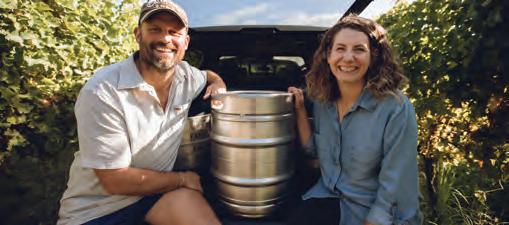
Organic Co-founder and Winemaker Nadine Worley. “Recent studies have shown bagin-box has one of the lowest carbon footprints of all the current alternative packaging formats, with carbon emissions up to 87% less than lightweight glass.” She launched Fugitive with viticulturist Logie Mackenzie in 2021, and they’ve just released the 2023 Marlborough Sauvignon Blanc in a box.
Logie says the purpose of Fugitive was always to make organic wine with a heightened flavour profile but low carbon footprint. “Being organic was only half the story, we wanted to make wine with the lowest carbon footprint possible. The more we researched it was clear single-use glass bottles weren’t going to be part of that story.” They started out supplying reusable kegs to bars and wine stores, but found the logistics too much for a small wine company. “So, we went back to the drawing board to look for other alternative packaging options that would work,” Nadine says.
“We wanted packaging that would maintain wine quality, be fully reusable or recyclable, and have the lowest carbon footprint possible.” When they heard about new premium recycle-ready wine bags, which can be easily recycled through the soft plastic scheme, it was “a game changer”, she says. “It makes you realise all the wasted weight and packaging required for glass bottles”.

SMETA is globally recognized as the most comprehensive framework for ethical trade audits, focusing on labour standards, health and safety, environmental performance, and ethical business practices.
By conducting a SMETA audit through BSI, your organization achieves full transparency across its supply chain, and efficiently meets legal and ethical requirements. This commitment to ethical business practices and sustainable supplier relationships significantly enhances your organization’s reputation and shows your people-first approach.
Contact us to find out how we can assist you with demonstrating ethical best practice in your supply chain.
P: 0800 583 965
E: info.nz@bsigroup.com
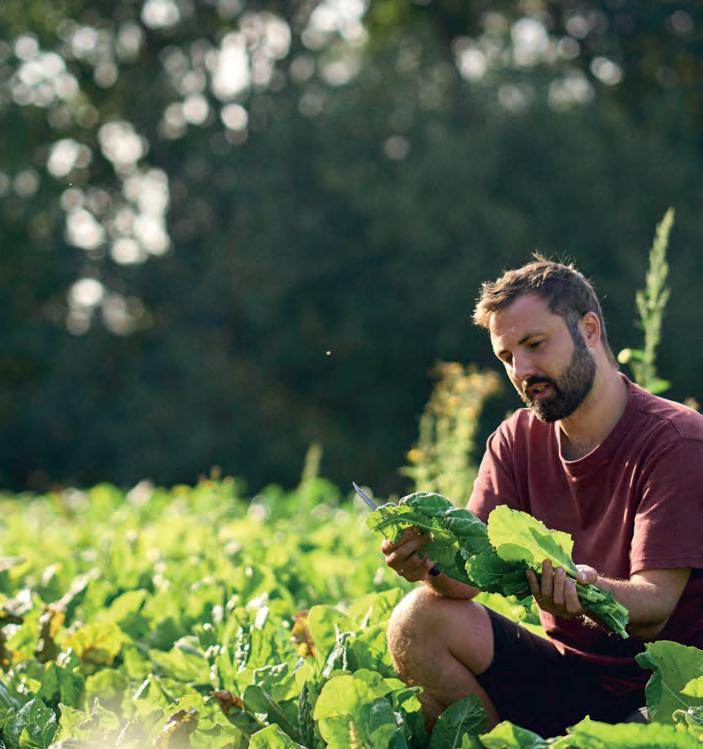
Find out more:
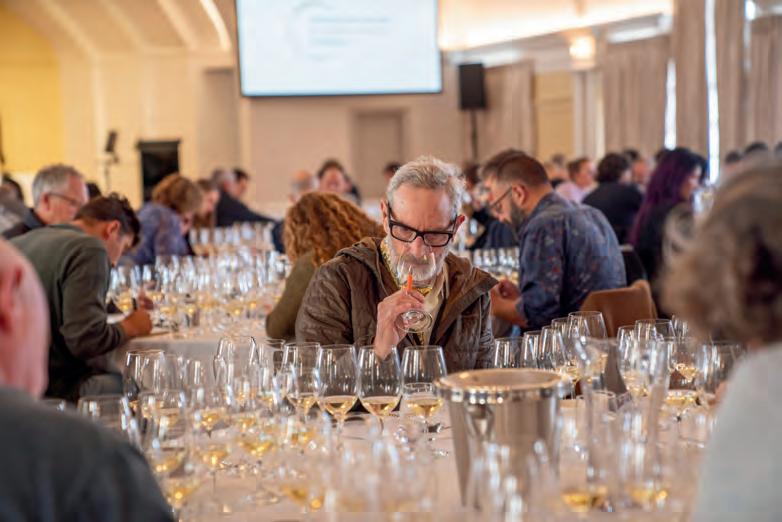
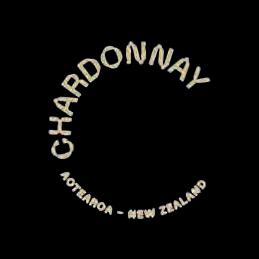
Taking place on September 26th and 27th in the beautiful Te Matau-aMāui Hawke’s Bay. Expanding on our foundation of education and community laid in 2023, this year the Symposium shifts focus to explore the sense of place in Aotearoa Chardonnay.
This immersive event will feature keynote speakers, panel discussions, wine tastings, networking opportunities, and offers a unique space to gain knowledge and inspiration.
Elaine Chukan Brown (USA): What is sense of place?
Stephen Wong MW: Aotearoa Classics; Benchmark and Archetypes Tasting and discussion.
Brenna Quigley (USA): Geology and Terroir; the mechanics of terroir and how to taste for it.
Steve Smith MW: Smith and Sheth/Pyramid Valley case study and tasting.
Jasper Morris MW (UK): Burgundy update; tasting, and discussion.
Elaine Chukan Brown (USA): The epitome of sense of place in Californian Chardonnay; tasting and discussion.
Braden Crosby: Clonal tasting of BRI Microvins from Escarpment and Two Terraces; investigating the effect of clone on regional identity, sense of place, and profitability.
Blair Walter, Sherwyn Veldhuizen, Jeremy Mckenzie: Case studies from Felton Road, Bell Hill and Isobel Estate.
Robin Shaw (AUS): Telling the story of place; advice from across the ditch.
Samantha Connew (AUS): Tasmanian Chardonnay case study and tasting.
Jasper Morris MW (UK): The Challenges and Future Prospects for White Burgundy; tasting and discussion.
Terroir specialist, Geologist, Decanter Rising Star 2023, and Wine Enthusiast 40 under 40. Brenna is committed to thoughtfully applying the science of geology to the world of wine through both education and hands-on vineyard investigations.


Credit: Michele Joly

Author of award-winning book Inside Burgundy (2010) and editor of the Burgundy focused website insideburgundy.com, Jasper Morris MW is one of the world’s most sought-after experts on Burgundy.
Experienced across the industry as a buyer, critic and writer; Jasper has been a Master of Wine since 1985 with an illustrious career behind him as a wine merchant and author. He was Berry Bros. & Rudd’s Burgundy Director from 2003 to 2017 and currently manages his website www.insideburgundy.com

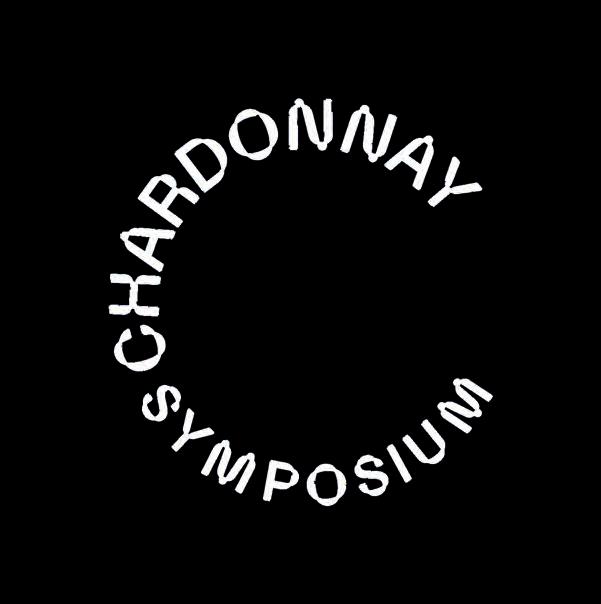
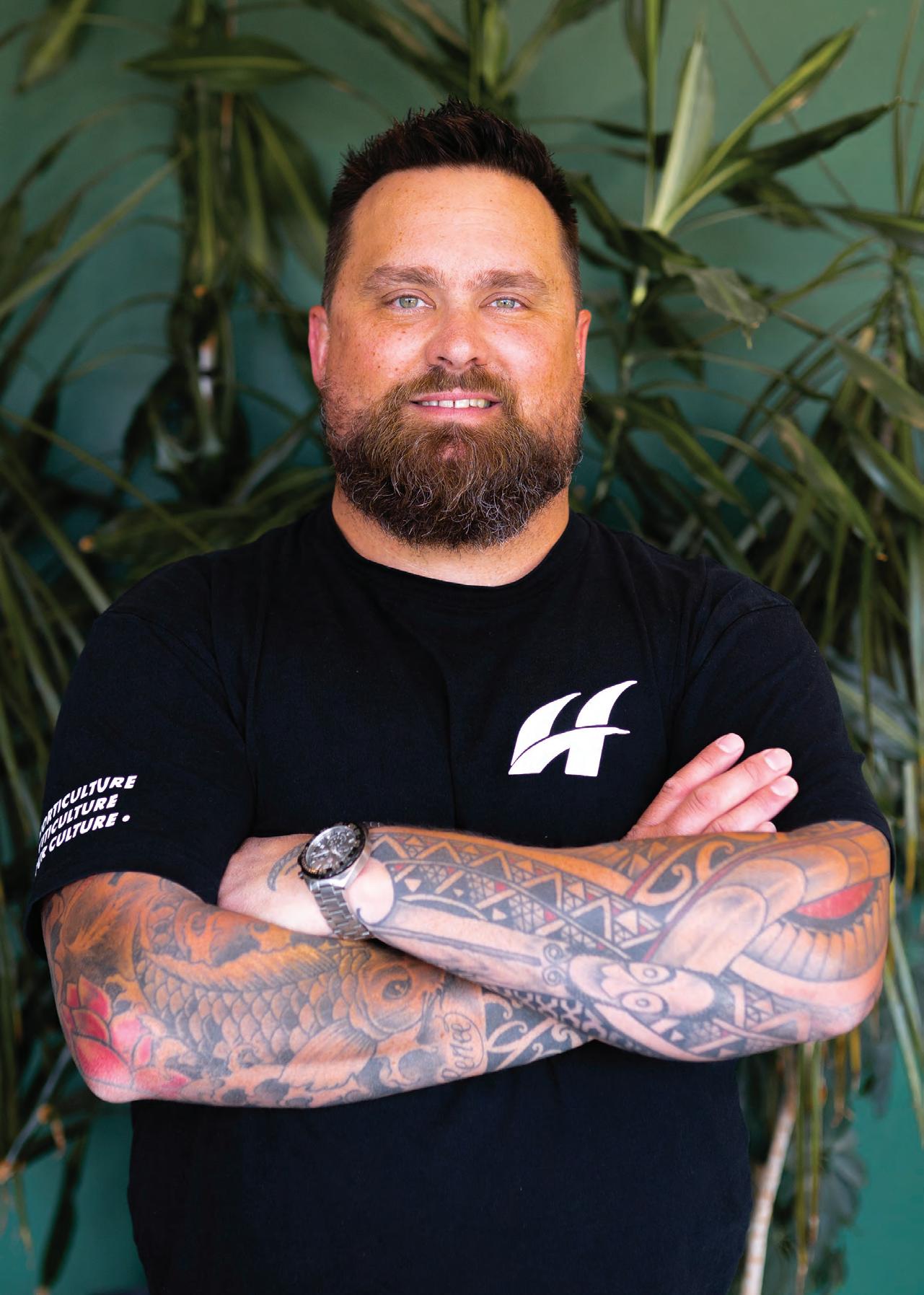
SOPHIE PREECE
Growing up in an English council estate, Aaron Jay had a simple life plan – join the army, earn some money, get ahead. “Put your head down, put your bum up, don’t ask too many questions, buy a house, and take a holiday once a year.”
A few decades on his Marlborough labour company employs 110 full-time staff across three provinces, a couple of hundred travellers and Kiwis, and 1,200 Recognised Seasonal Employee (RSE) scheme workers. “I don’t want to think about it too often because it makes me feel sick,” Aaron says. “There’s a lot of responsibility, when you think about the number of people who depend on the income from working for Hortus, particularly in the RSE scheme.”
He’s chuffed by the recently released Hortus Impact Report, which illustrates the
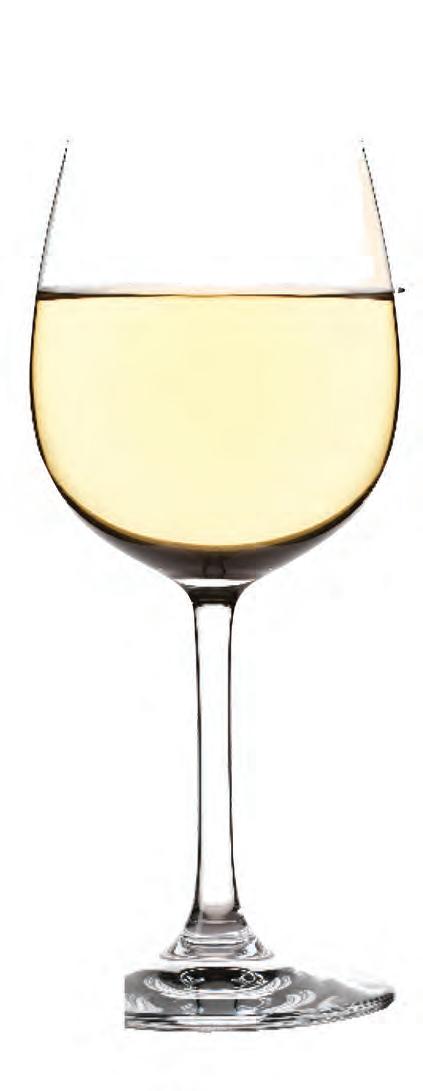
conduit between the two. “Quite simply we don’t have a business without them and the impact is ours to share.”
“There’s a lot of responsibility, when you think about the number of people who depend on the income from working for Hortus, particularly in the RSE scheme.”
Aaron Jay
Getting down to business
Aaron moved to New Zealand in 2001 when he was 21, three years after his British father and Kiwi mother came over with his two younger brothers. “Life dealt us a certain hand and it required me to come over a bit later on,” he says. He’d left school at 16 then done an array of jobs, including in insurance, banking, and data analytics. They meant little to him at the time but in retrospect proved valuable apprenticeships, “for lack of a better term”.
When he arrived in New Zealand Aaron began working in vineyards, trying everything from piece rate work
to driving tractors. When his wife Renee, also a vineyard worker, was pregnant with their first daughter they decided they needed a new plan, and in 2008 launched Marlborough Vine Works with seven RSE workers, half a dozen Kiwis, and a van. They also had an ethos of respect, with the couple adamant from the very beginning that they would never ask anyone to live in accommodation they wouldn’t live in, or do work that they wouldn’t expect to do. They’re values that were supported by “a really awesome client base”, Aaron says. “The first set of advisors we had were our clients… They saw something in us and became our biggest advocates.”
His years in Marlborough vineyard work had exposed Aaron to the reality of “rogue” contractors at play back then. “I wanted to try and provide a much more professional service and a peace of mind service, so the growers employing us knew we were doing right by our people,” he says. “Having worked in the industry, and with people who didn’t look after their employees, I knew what not to do; I just had to work out what to do.”
The learnings from Aaron’s previous jobs – from desktop to vineyard – proved valuable along the way, with a grasp on


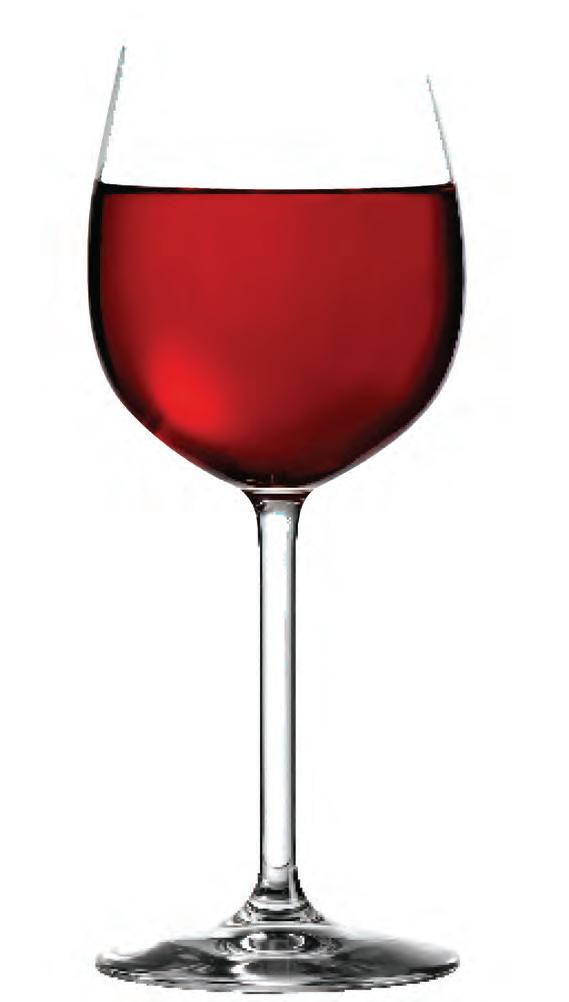

everything from insurance and mortgages to the ramifications of the official cash rate. But the first years of business were tough, with late payments from clients putting the family house at risk, and Aaron working 80-hour weeks trying to keep their head above water.
He eventually followed the advice of his bank at the time, BNZ, and attended an Icehouse owner management course, dramatically changing the fortunes of his company, including its rebranding to Hortus in 2013, repositioned as a labour company specialising in viticulture. “We learned a massive amount which changed the shape of the business,” Aaron says. In the 14 years since he began with Icehouse, the company has achieved 29% growth year-on-year, and has expanded to Hawke’s Bay and Bay of Plenty.
The Icehouse impact Aaron hit the ground running with Icehouse, “like a sponge, taking in everything I could”. The programme developed his understanding of branding, marketing, goalsetting and leadership, as well as the importance of finding the right people to grow Hortus alongside him.
“That’s one of the biggest things I took away – confidence in my decision making and closing the gaps by bringing in the right people to support me. Now we have a really strong team.” It’s meant constant reinvestment to allow Hortus to move to “the next rung on the ladder”, he adds. “We’re constantly investing in the future.”
As well as learnings, Icehouse gave him a “powerful” network, working with people from diverse backgrounds – from meat works and stainless-steel fabrication companies to mammoth multinationals – bringing a valuable cross section of perspectives. The group has met every year for the past 11 years, and check in frequently, so that once “complete strangers” now understand a great deal about his business and family. “It made me realise how important it was to have people who have your back,” he says. “It’s really lonely being an employer and sole owner operator. Sometimes you wonder how to navigate that. Having people from Icehouse in the same position, you can lean on them and use them as a sounding board… The network and insights you can get from these people is extremely powerful.”
Aaron was inspired to build a similar culture of support within the business, “and now we have a really awesome alumni outside Hortus, but we have an incredible
The Hortus Impact Statement from 2023 reports that 1,200 Recognised Seasonal Employee Scheme employees, working in New Zealand for between two and seven months, earned a combined $NZ25 million in take home pay between January and December 2023, which impacted 24,020 family and friends in their home nations. The information, gleaned from company data, survey results from workers, and personal storytelling, reveals that 67 employees used their 2023 Hortus earnings to start a business, 69 bought land, and 257 built a house, while the income also paid for 2,100 children to go through schooling. Hortus founder Aaron Jay says the figures embody what Hortus calls its MAP values: Making a Difference, All Together Better, Proud of What We Do. And they are testament to the work of the people the work for, he says. “These are not our numbers; they are our clients’ numbers.”
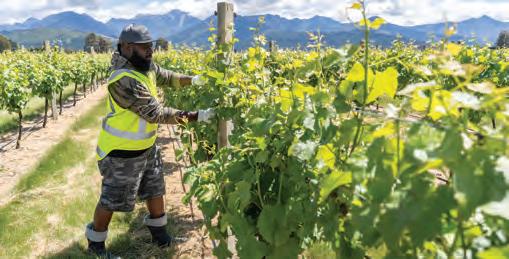
one inside Hortus as well.” Aaron has put 10 of his staff through the Icehouse programme, to ensure the team is aligned and high performing, with a common view of the “personality” of Hortus and its place in the wine industry. “We are using the same terminology about the direction of the business.”
New Zealand’s wine industry is growing in scale and maturity, with its people, technology and aspirations in constant evolution, Aaron says. “It’s an awesome industry to be involved in and one we should be extremely proud of.” He’s equally proud of the RSE scheme, initiated in 2007, believing it to be a win-win for the wine industry and the seasonal workers it employs. According to the Hortus Impact Statement, the more than $NZ25 million
in RSE earnings last year, after deductions, impacted 24,020 family and friends in the workers’ home nations, with 67 businesses launched as a result of the income, along with 69 land purchases and 257 houses built. Those life-changing opportunities mean a lot, says Aaron, echoing the values espoused by Sam Stubbs of the Simplicity KiwiSaver fund, who talks of the intersection of money, choice, and dignity. “If you have access to money then you have choice, and if you have choice, you have dignity,” Aaron says. “My goal is to try and create that for as many people as possible.”

Read more about Aaron’s Icehouse experience at theicehouse.co.nz/ kiwi-business-stories/owner-managerprogramme-hortus
Small and medium businesses are the “engine room” of New Zealand’s economy, says The Icehouse chief executive Olivia Blaylock. As a registered charity, The Icehouse is an advocate for the midsize business industry in Aotearoa, she says. “For 23 years, The Icehouse has listened to and mentored 4,000 Kiwi business leaders to achieve an average post-programme growth of 250% within their businesses. As the business landscape is in an important period of change, the entire Icehouse team is focused on delivering up-tothe-minute nationwide support of owner managers.” Icehouse alumni have achieved an 11.03% average annual compounding growth rate, compared to a 6.35% average for small to medium businesses, and a 15.61% increase in operating profit, compared to 6.%. A recent SME Impact Report, containing data from more than 900 unique businesses between 2017 and 2023, reveals that 77% of the programme alumni reported an improvement on financial performance, and 83% reported an impact on personal wellbeing. Read the full Impact report at theicehouse.co.nz
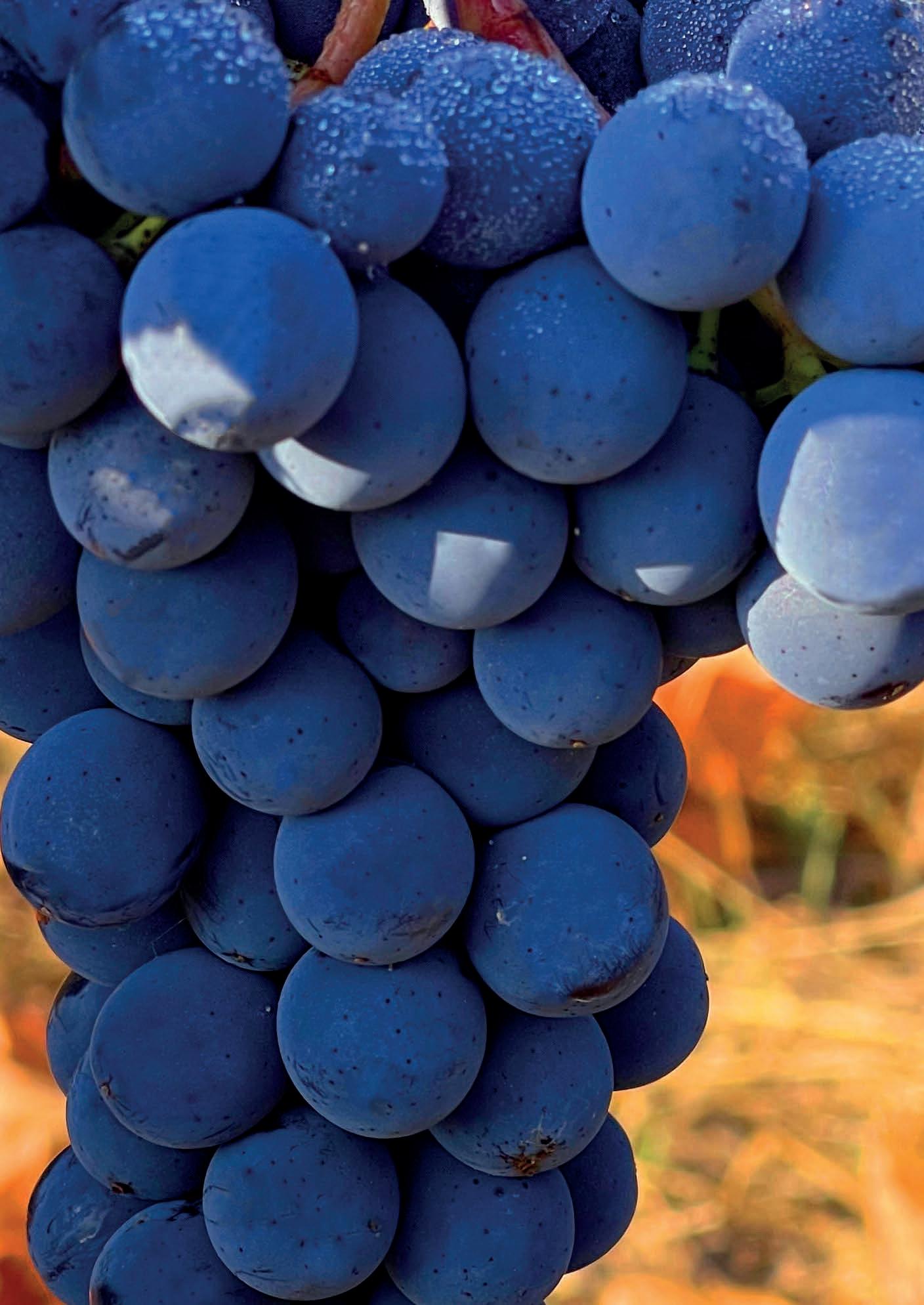

JOELLE THOMSON
Jane Cooper has a soft spot for wines with a point of difference, and there is no shortage of that in her brand Alexia, at home in the heart of Greytown.
Her fruit comes from a relatively unusual place for the Wairarapa, with Manuka Flats vineyard planted in the lee of the Tararua Ranges, 15 minutes’ drive north of Greytown, rather than the more eastern sites, closer to the coast, typical for the region’s vineyards.
“We really want to make some of the best wines in New Zealand and to do that we need to be creative, innovative, making different styles and grabbing people’s attention.”
Jane Cooper
Then there’s the cornucopia of grape varieties planted, including Viognier, Chenin Blanc, Gamay, Grüner Veltliner, Lagrein, Cabernet Franc, Syrah and Riesling. “I want to make a diverse range of wines because we use a narrow range here in New Zealand and we need to innovate, especially with the change in climate that we are dealing with,” Jane says, noting that the past four years have been a roller coaster of climatic changes, with warmer, wetter, drier vintages, along with lower crop levels.
Climate challenges aside, Jane is keen to push boundaries. “We really want to make some of the best wines in New Zealand and to do that we need to be creative, innovative, making different styles and grabbing people’s attention,” she says. “As members of the wine industry we need to be innovative for many reasons. At the moment we are so reliant as an industry on Sauvignon Blanc that we need to branch out.”
Manuka Flats was planted in 2007 by Julie Collins and Simon Dawson, a chemical engineer who had investigated soil maps and weather data in the early 2000s. “I really enjoy making different styles of wines from

different experimental grape varieties, which made this particular vineyard work well for us,” Jane says. “Because Simon and Julie were so forward thinking that they decided to plant some varieties that do not really exist in a mainstream way in New Zealand.”
The soils of Manuka Flats Vineyard are the same as those found on the Martinborough Terraces, with Ruamahanga stony silt loam offering free draining properties highly valued in this part of the winemaking world, particularly given the increase in wet weather events. Weather patterns have changed over time at the Manuka Flats Vineyard, with less windswept rain off the hills now, and also fewer frosts, Jane says. “We have a bit of a backup plan with all these different varieties because we don’t know what’s coming, in terms of weather.”
Simon and Julie retain ownership and management of the site, while Jane and her partner in wine and life, Lesley Reidy, oversee the vines. “It was important to me to have some high-level input into the way the vineyard is managed,” says Jane, whose plans to become a lawyer were disrupted by a visit to Te Mata Estate Winery in Hawke’s Bay. She completed her law degree at Victoria University then studied viticulture and winemaking at Lincoln University in 1991, going on to work in New Zealand
and overseas, building her reputation as winemaker and wine judge.
Jane was working in Nelson when Alexia began as a side hustle in 2000, and continued the brand when she joined Matahiwi in northern Wairarapa in 2004, as General Manager and Chief Winemaker. Alexia was put on ice in 2012, when she and Lesley had their second child, but resumed in 2017, after Jane left Matahiwi. “We also then started planning to have a winery in the middle of Greytown,” she says. “I remember a wine speaker a long time ago saying: ‘Where you really want to be is where you want people to come to. You can get your grapes from anywhere, but if you want to be in a place, make it somewhere that people love coming to.”
The winery and cellar door were opened in 2020, sitting comfortably down the end of a long road with a mix of residential and industrial neighbours. “We get fantastic support from the locals but it was a challenging time to open,” Jane says. “At the time we had an eight-year-old and a 10-yearold, and the winery site was not developed, so the children played in the carpark for the whole vintage. It was pretty traumatic trying to establish a winery that year, and it was thanks to the support of friends that we were able to make it work.”
This year Jane produced Chardonnay for the first time in four years, and also made a dry co-fermented white wine from Gewürztraminer, Pinot Gris and Riesling. The vintage was larger than 2023, she says. “Last year was a disaster so we did a very small vintage and so this year we made a little bit more wine. We would like to make more overall so that we can grow sales here at the winery, where we serve food at the cellar door.”
The biggest production at Alexia is Rosé, made entirely from Pinot Noir. Gamay is also showing promise, as are Grüner Veltliner and Lagrein, a northeast Italian variety which has a characteristically deep colour intensity and smooth tannins, making a medium bodied red. Asked which of the myriad varieties has the most potential and Jane’s immediate answer is Chenin Blanc.
When she was interviewed for this story, Jane was planning for a trip to Japan to judge for the first time at the Japan Wine Challenge. It’s a long way from Greytown, physically and metaphorically, but both places have Jane Cooper’s heart; one for its close-knit community, the other for its innovation, creativity and spark.

Jane Cooper has been Chair of Judges for The National Wine Awards of Aotearoa New Zealand since its launch in 2022. The awards are simultaneously the newest and the oldest national wine competition in New Zealand, run by the team that organised New Zealand’s longest running wine show, the Royal Easter Show Wine Awards. Jane says wine judging requires discipline and focus, “to highlight and pull out the best wines in a lineup, and to be consistent with that”. It takes time and the right personality to become very good at it, she says. “And you have to love it, I think.”
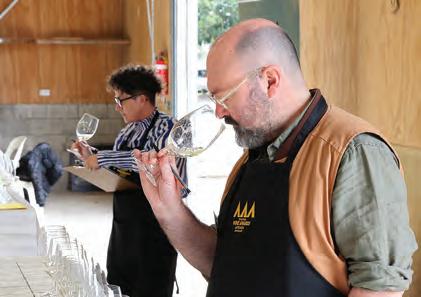
Keen to innovate, Jane introduced an organic trophy last year and this year has included an alternative styles category, aimed at lo-fi and natural wines. “I would love to draw these wines into the awards and celebrate those styles as well,” Jane says. “I am also trying to increase the diversity amongst the judges as we often see a majority of winemakers judging and I feel we need more people from other areas of wine – hospitality in particular. People who have come from the world of wine but not a winery environment. They just have a different lens which is so important I think.” Entries for the 2024 awards open 12 August and close 6 September. Initial results will be released 11 October, with the Awards of Excellence Long Luncheon on 3 November. nationalwineawards.co.nz
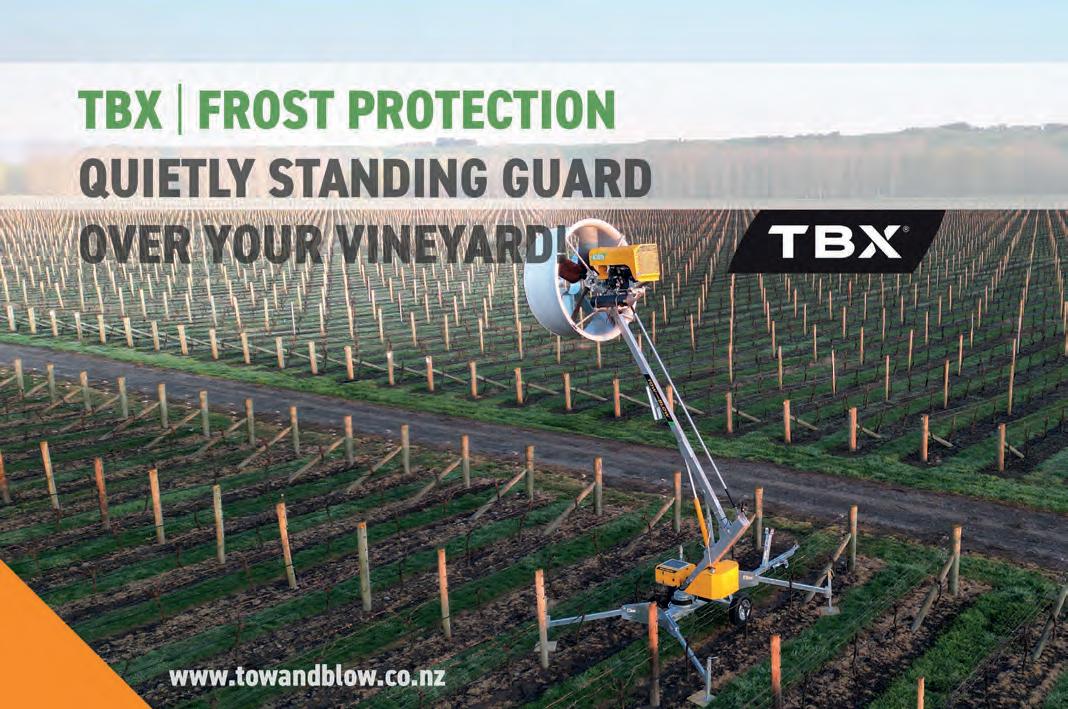
For over 40 years Valagro has been working in the field of biostimulants and specialty nutrients. Using this knowledge and experience, they have been able to harness valuable active ingredients from nature to help growers achieve healthier fruit and better harvests. Valagro Biostimulants are backed by science.
WHAT SCIENCE DOES VALAGRO USE?
GEAPower is the exclusive technology platform created by Valagro. Based on genomic and phenomic science technology, it incorporates the latest methods, technologies and collaboration partnerships with scientific academia and industry experts to assess raw materials and properties, offering sustainable solutions to improve crop performance.
Valagro carefully select plant extracts that help to achieve targeted physiological responses in plants. They then utilise GEAPower to screen, understand and determine optimum efficacy.
GENOMICS
Genomics is a powerful tool to decipher molecular and physiological triggers for specific responses in plant systems. Valagro uses the Gene chip to understand specific plant genes stimulated from selected compounds, and to generate a database of different plant active compounds for current and future Biostimulant production.
Valagro uses Genomics to develop Biostimulants, to understand each bio active compound’s mode of action and prove they are triggering
different physiological responses in plants, relative to environmental conditions
PHENOMICS
Phenomics is used to test plant responses under different controlled conditions in glass house replication. Valagro uses systems such a RGB (Red/Green/Light), NIR (Near Infrared) and Digital Biomass to measure root growth, inter-stem growth and plant biomass. Phenomics is used as a primary screening process prior to field testing, and to prove the specific Biostimulant is generating the optimal plant response. Over 200 active compounds from over 60 specific natural sources are currently used by Valagro.
NEW ZEALAND WINE GRAPE TRIALS 2024
Although Valagro has an exceptional level of science to support the solutions they offer in New Zealand, It is important to continue to conduct trials on specific crops to demonstrate their effectiveness in the NZ environment. In 2024 three trials were conducted on Wine Grapes. MC Set and Talete trials were conducted in Marlborough on Sauvignon Blanc. And the completion of a three-year trial using Kendal on Merlot in the Hawkes Bay.
MC SET TRIAL IN MARLBOROUGH 2023/24
2024 in Marlborough, proved to be a challenging year to achieve a good fruit set. MC Set is based on natural active biomolecules which have a strong ability to stimulate the physiological processes underlying flowering and fruit setting. Unfavourable environmental
conditions can cause floral anomalies, lack of anthesis, bursting of the pollen tube, and abnormal fertilisation. The use of MC Set can have a positive effect during fruit setting and the delicate phenological phases connected to it.
Trials were conducted using MC Set in Marlborough on Sauvignon Blanc. The vines were older and not producing high yields. Hand pick data was assessed from sub samples, 8 vines per sub plot, 96 vines in total. The crop was then machine-harvested to give a commercial representation of the total yields. The total yield compared to Untreated Control (UTC) was 1.5 tonnes higher after the two applications of MC Set, one at E.L 18 and E.L 20. This trial showed a Return on Investment (ROI) of $2966 per hectare after the cost of the product is deducted.
KENDAL TRIAL ON MERLOT 20222024
Kendal is a scientifically proven biostimulant from natural origins that helps plants to remain vigorous in hostile growing conditions. Kendal’s unique formulation boosts the plant’s natural defence (endogenous) mechanisms by stimulating an antioxidant reaction in the plant’s cells.
Kendal is used to increase vine resilience because it contains three main compounds that trigger a series of effects in the plant. Glutathione is an important amino acid that removes toxins from the plant. Oligosaccharines, activate the transcription of defense genes inducing the production of antibiotic and anti-microbic compounds and Saponins have a high antimicrobial
activity within the plant.
Over three consecutive years, Trials were conducted using Kendal in the Hawkes Bay.
Each year there was a consistent increase in yield. Using 12 Sub samples of 8 vines per sample (96 vines in total) hand-picked bunch counts and vine weights were assessed.
Commercial machine harvesting gave
the total yield in the designated trial area which was the same locations each year.
2022/23 had a particularly high yield due partly to Cyclone Gabriel and the heavy rain that occurred close to harvest. Over three years the average ROI was calculated at $2730 per hectare after the cost of the product was deducted.
Contact Nic Peters (Valagro Specialist) on 027-534 4662 to learn more.

In the lead up to the Young Viticulturist of the Year National Final 2024, we meet the national finalists from around the country.
Leon Henson, Vineyard Manager at Batch Winery
Describe what you love about viticulture
I love the communion with nature and the teamwork it takes to foster happy, healthy vines.
What makes your region special?

Waiheke Island is a very special place. Two fault lines run through Waiheke – one actually runs straight under the Batch vineyard. This means that the earth on Waiheke is mineral rich and naturally low in pH. This makes for lovely wines. In 2016, Lonely Planet rated Waiheke as the number five region in the world to visit.
What’s a burning topic in vineyards?
Eutypa dieback is a topic which has been smouldering for a while, and now the problem is burning some vineyards. It takes a large amount of work, planning and money to remedy this scourge, but we can do it.
In 20 years New Zealand wine will... I hope, be producing more of our lovely, juicy, aromatic white wines. Right now most international wine shops only stock two varieties of Kiwi wine. We make good stuff – we’re not a two-trick pony!
Nina Downer, Viticulturist at Felton Road Wines
Describe what you love about viticulture
The diversity of jobs. Every year is different which gives constant opportunities to learn and grow as a viticulturist.
What makes your region special?

The people. The Central Otago wine industry is such a tight knit, collaborative community, always willing to share their knowledge and time with each other.
What’s a burning topic in vineyards?
Resilience. With the forever changing and extreme climate conditions we are seeing as an industry, what can we do out in the vineyard to be resilient to this change? Ways we can increase the health of the vines and the soil so that we can mitigate the outcome and bounce back.
In 20 years New Zealand wine will… have disease resistant vines dispersed out in every region helping us with the ongoing battle that is pest and disease management. Robots and drones will have found their way into vineyards solving some labour shortage issues, and the New Zealand wine industry will still be chugging along, adapting with the changes and making some tasty wine.
Joe Stenberg, Viticultural Assistant for Te Mata Estate
Describe what you love about viticulture
I love the way it combines science, technology, business and tradition to overcome challenges and get the fruit we need.
What makes your region special?
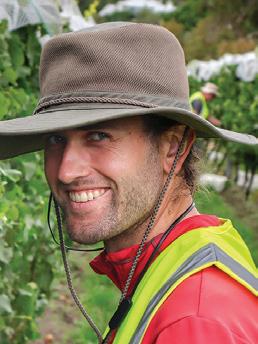
The Hawke’s Bay is special as it has such diverse climates and microclimates capable of producing many different varieties. And all the varieties are showcased in amazing wines that stand up internationally.
What’s a burning topic in vineyards?
Technology and automation. It’ll be interesting to see how automation makes its way into our business and how it will change our day-to-day work.
In 20 years New Zealand wine will… still be producing desirable wines meeting current trends. I have no doubt we will be able to innovate with ease as we have such a strong foundation. We could be growing and making some interesting stuff but doing it well.
Unfortunately, Joe’s response was not in the print version of this magazine. We are sorry for the error and will run more on Joe in the October/November edition.
Anna Kelland, Viticulture Technician at Constellation Brands
Describe what you love about viticulture
Being able to use both science and instinct to grow the best grapes possible.
What makes your region special?

Marlborough makes the favourite wines of so many people around the world. It’s incredible to meet new people and know you were involved in making a product they enjoy so much. Other countries may try to replicate our signature style, but our land and our people make this region unique and special.
What’s a burning topic in vineyards?
As many vineyards are aging, we have the opportunity to make important long-term decisions during redevelopment and replanting. Vineyard infrastructure, soil management, planting material, and heaps of other options can be chosen with the goal to manage vineyards of the future with sustainability in mind.
In 20 years New Zealand wine will… be in a position to flex with market demand, changing climate, and industry challenges. We already are, but the future holds many more things to learn from and make our industry last. New Zealand viticulturists benefit from not having the attitude of ‘this is how it’s always been done’, and we’ll be making the most of that in 20 years’ time.
Wairarapa
James Sutcliffe, Foreman at the Craggy
Range Martinborough vineyard
Describe what you love about viticulture I love being in tune with the seasons and seeing the literal fruits of my labour each year.
What makes your region special?
The community. I know you can say that about most places but in my short time in the Wairarapa I have met some awesome people who have all been very welcoming.
What’s a burning topic in vineyards?
Pruning is something we have been talking about in Martinborough. Seeing decades of poor practices reaching their natural conclusion has been eye opening. We often prioritise the ease of management and yield over vine development, especially in new vineyards. If we want our vines to live for a century we need to have a more considered approach to pruning.
In 20 years New Zealand wine will... look quite different. I think there will be more diversity in the styles that we produce. As younger generations make up an
Wairarapa Regional Winner

James Sutcliffe
increasing proportion of wine consumers, changes in preference will be an opportunity to get creative with what we produce and how we present it.
Annika Salenjus from Craggy Range won the 2024 Wairarapa Young Viticulturist of the Year, held at Escarpment on 20 June, taking the title for the second year running. However, she will be overseas for the national final, leaving runner up James Sutcliffe, also from Craggy Range, to represent the region and fight for the title.

The South Island regional competition, to be held at Waiata Vineyard in North Canterbury, had not been held when this edition went to print. The finalist will be profiled in the next edition, following the Young Viticulturist National Final on 28 August at Escarpment in Wairarapa. The winner will be announced at the Altogether Unique 2024 Celebration Dinner in Wellington on 29 August. nzwine. com/en/events/ young-vit
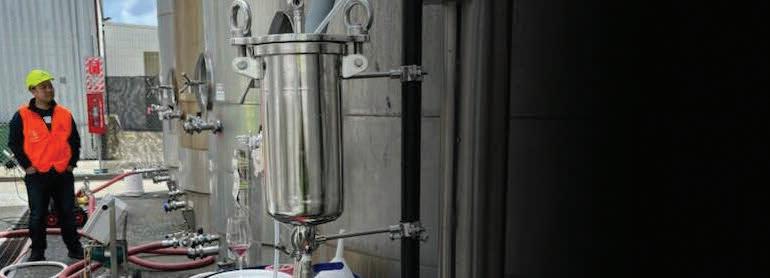
Elaine Chukan Brown and the “electric acidity” of NZ Chardonnay
EMMA JENKINS MW
From commercial salmon fisherman, camel trainer and philosophy academic, to wine writer, illustrator and sought-after speaker, is one of the less common career trajectories. But anyone meeting Elaine Chukan Brown, one of the keynote speakers at September’s Aotearoa Chardonnay Symposium, would be unlikely to come away surprised.
Their obvious intelligence, practicality, perceptiveness and humour leaves no doubt that this is someone with an impressively broad skillset. The native Alaskan now residing in Sonoma, California, is the current Napa reviewer for Wine Enthusiast and co-founder of the Diversity in Wine Leadership Forum, was the former United States editor for JancisRobinson.com, and was awarded the 2020 IWSC Wine Communicator of the Year.
“If Chardonnay can find that unique regional character somewhere in New Zealand, the whole world will hunt for it.”
Elaine Chukan Brown
Elaine is thrilled to be heading to Hawke’s Bay to deepen their understanding of what they regard as one of New Zealand’s most exciting varieties. From a US standpoint, “the understanding of New Zealand Chardonnay is still limited”, they say. “A few of the well-known brands are discussed in the sommelier community, but there is neither broad nor in-depth knowledge of it otherwise. At the wider consumer level there is not much recognition of New Zealand Chardonnay.”
Elaine sees some challenges in our largest export market. “The price point after tariffs, import taxes, etc makes the best wines of New Zealand, which generally speaking tend to have more moderate volume, harder to sell elsewhere,” they explain. “And the higher volume wines need to set themselves apart if they are to become a price point leader. Just as Marlborough has
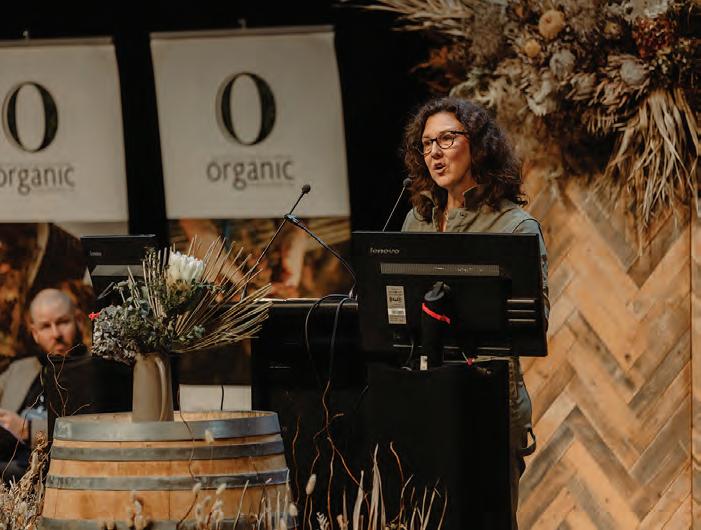
so successfully found its distinctive flavour in Sauvignon Blanc, if Chardonnay can find that unique regional character somewhere in New Zealand, the whole world will hunt for it.”
Attendees of last year’s symposium will recall the impassioned advice from US writer Christina Pickard, who urged producers to showcase their authenticity and really tell their story. This year’s programme has a strong emphasis on the concept of ‘Place’, and Elaine, speaking on California and other topics, is joined by geologist and terroir specialist Brenna Quigly, who will explain the mechanics of terroir and how it might be perceived in the glass, whilst renowned Burgundy expert Jasper Morris MW will examine terroir through the lens of Burgundy.
While Chardonnay is often referred to as a “winemaker’s grape”, Elaine says in reality the picture is far more nuanced. “Chardonnay is one of the most place expressive varieties while also growing decently in a range of conditions. It is often described as a neutral grape because it does carry cellar choices so well. But I view cellar and place in equal proportion for the
variety, which is unique.”
New Zealand’s signature, is all about “the electric acidity”, they say. “I describe it as a high wattage lightbulb wearing a diffusing lens - elevated and stimulating but the edges are softened to pleasurable brightness.” Day two brings a deep dive into clones, Aotearoa case studies, as well as Australia and Burgundy tastings, wrapping up what is sure to be another exciting, thoughtprovoking symposium.
Elaine will be familiar to many in the New Zealand wine industry for the moving closing speech they gave at Pinot Noir New Zealand 2017. Since then they have visited numerous times, most recently for last year’s Organic & Biodynamic Winegrowing Conference, and have also presented New Zealand wine at ProWein and Texsom amongst other events.
If you see Elaine without a glass of Chardonnay in hand at September’s symposium, see if they need a pie. “My life dream continues to be someday having the opportunity to judge the national pie awards, or if that is an honour too high to hope for, then at least witness them.” Bakels, you heard it here first!


“Have a look at this” said a good friend as he passed me a cutout from The Times with the heading “The wine gadget sommeliers say can make your £10 bottle taste better”.
“I plan to order and test drive a Winewizard to see if it lives up to its claims. Until then I will continue to swirl my wine glass vigorously.”
Bob Campbell MW
British inventor, Michael Pritchard,
Winewizard that pumps millions of microbubbles into a glass of wine. The process, he claims, “improved the taste of cheaper reds, whites and rosés, or brings younger, high-quality wines to maturity.”
A six-month study by Plimpton College in East Sussex “found that some wines effectively aged by up to ten years with one quick application of the pump". It increases the surface area of the wine by 10,000 times and successfully replicates a process that usually takes place over years or even decades in a cellar – meaning the wine can reach its optimal potential in just seconds,” Pritchard said. Sound a bit far-fetched? Most wine drinkers will have experienced a boost in wine quality when robust reds are sloshed into a decanter. I choose to drink red wine in large glasses to expose the wine to air.

• 21, 22 Sept, 5, 6 Oct 2024
• 23, 24 Nov, 7, 8 Dec 2024
• Saturdays & Sundays, 9am - 4pm


The process can be accelerated by swirling the glass for extra air exposure. The wine often seems to become smoother and more complex. Why shouldn’t a man like Pritchard, who was awarded an MBE for services to innovation in 2013, refine the process of oxidation and make it even more effective?
Winemakers worldwide use a process called micro-oxygenation that was authorised by the European Commission in 1996. Micro-oxygenation controls the uptake of micro doses of oxygen and can benefit wine in a number of ways, including softer tannins and a silkier texture.
I plan to order and test drive a Winewizard to see if it lives up to its claims. Until then I will continue to swirl my wine glass vigorously.

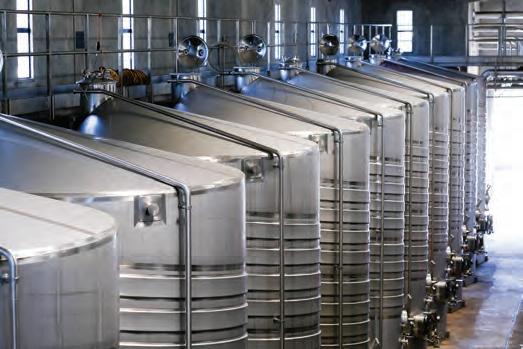
What’s been going on?
JAMES MORRISON
Winter certainly arrived early in 2024, with the coldest May for nearly two decades and the first month with below average temperatures in four years. That included record breaking cold and a significant number of frosts, which drove down the mean temperature in most regions.
June has given some respite, with a return to warm conditions and record-breaking temperatures in Hawke’s Bay. July has been reasonably dull and cool at times in the east. El Niño has receded and an early shift to cooler than average sea surface temperatures across the equatorial Pacific Ocean is usually the signal that La Niña is on the way. It is looking more likely that La Niña will develop during spring, although the commentary from around the world suggests this is not locked in yet. Other climate drivers such as the Southern Annular Mode and Indian Ocean Dipole are hovering around neutral and not giving away any teasers about how the remainder of 2024 will play out. If La Niña does arrive during spring, then we may
see an early period of westerly conditions across New Zealand that give way to a northnortheast flow later in September or early October.
Spring is approaching with the promise of milder weather, but we know the risks spring frost brings. Even though the onset of the growing season varies from region to region, frost is still a risk to most growing regions across New Zealand. Last year was a timely reminder of this, with significant frosts recorded as far north as South Auckland in early October, and late November frosts recorded across much of Marlborough.
Although there are several methods of mitigating the risk of frost on a vineyard, two of the most successful and widely used are helicopters and frost fans. Both of these methods involve mixing milder air that is found several metres above the surface on clear, settled nights. As a parcel of air cools on a settled night it becomes denser and
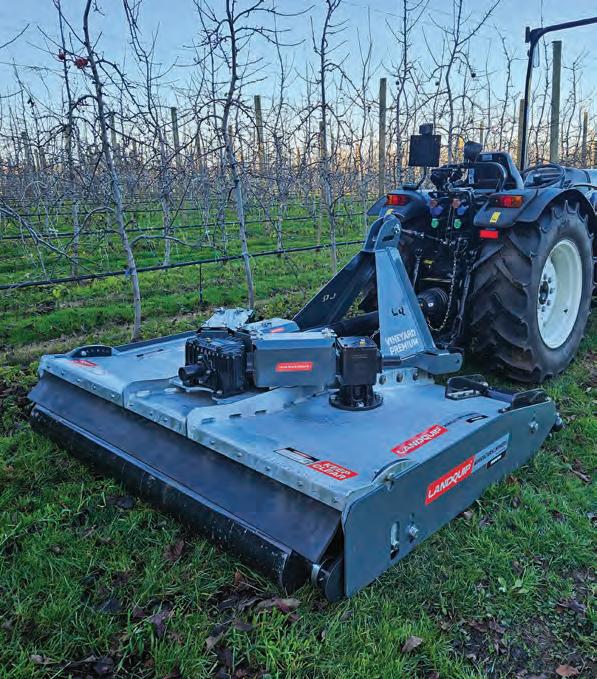
heavier and can stratify. This heavier air at the surface becomes colder than the air above and the temperature of the air above the surface is warmer with height. The difference between the surface temperature and the temperature at a higher elevation is the inversion. Utilising potentially milder air from 10-20 metres above a vineyard can be an extremely effective method of mitigating the risk of frost. However the quality or strength of an inversion can vary due to the topography of the vineyard and the surrounding region, as well as the current synoptic conditions or weather patterns.
A wide open and generally level surface provides the best chance for air to stratify as it cools. Areas that are on hillsides or surrounded by hills and mountains are the sources of drifts that develop. There can be multiple drifts present in areas surrounded by complex topography and these drifts can create a more turbulent airflow over a vineyard that leads to a weaker inversion. The quality of an inversion can be extremely


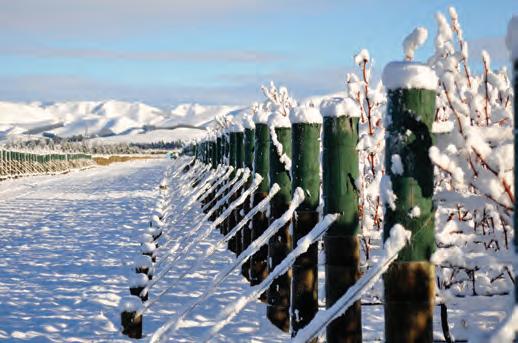
localised and a strong inversion in one part of a region is often completely different to the inversion observed just a few kilometres away. The best method of understanding what the inversion over any vineyard or future development is still an intensive climate study.
for August and September
Gisborne/Hawke’s Bay
Warm north to northwest winds are likely to return at times and could make late August feel like spring has arrived early. Rainfall totals have been elevated at times, but rainfall could reduce from late winter and through early spring under a west to northwest flow. Early spring frosts are possible with drier and clear conditions, especially on the back of any southwest changes that break up the northwest flow.
Wairarapa
The lower North Island is susceptible to stronger than average winds when the northwesterlies arrive. August and early September may see the return of stronger winds. This may help with milder than average temperatures at times although there is still a risk of frost. Rainfall is likely to be near or even a little below average through early spring.
Nelson
Temperatures are likely to remain above average, helped by more frequent northwest winds. Rainfall is likely to run close to average, with fronts moving in from the northwest producing rain for the upper South Island. There will still be some risk of frost on the back of southwest changes.
Marlborough/North Canterbury
Temperatures are likely to run near or above average along the east coast of the South Island through late winter and into spring. Mild northwesterlies are likely to bring an early return to 20C+ afternoons from late August or early September. The risk of frost is most likely after any southwest changes. With faster moving systems under a west to northwest flow, the chance of frost becomes more reliant on the timing of clear skies and incoming ridges of high pressure. Rainfall is likely to run near or a little below average through early spring.
Temperatures are likely to be near or above average. Northwest winds may strengthen in late August and early September. The frost risk may be reduced at times as faster moving weather systems move across the lower South Island. As with Marlborough and Canterbury, the timing of clearances and incoming high pressure will be important when determining the chance of frost. Rainfall totals are likely to be close to average through late winter and early spring.

James Morrison runs Weatherstation Frost Forecasting: weatherstation.net.nz

The most advanced Cloud-based controller for viticultural irrigation & fertigation


Arkal Spin Klin
Nova Plus
Exceptional Performance. Modularity at its Best.

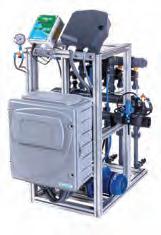
GSI Pro Fertijet Injector
Web-based control of irrigation, filter flushing and multichannel fertigation


D5000 AS CX Dripline
A long-term, safe and non-leaching solution to reduce root intrusion

To find your local dealer contact Water Supply Products: Auckland: 09-916 0094 Christchurch: 03-348 1293 wsp@watersupply.co.nz www.watersupply.co.nz
Demonstrating our commitment to the future through climate change mitigation
Dr Edwin Massey
Net zero - a new climate change goal
Climate change is one of the most pressing challenges for our industry. There is strong evidence that New Zealand is becoming warmer, drier and exposed to more frequent weather events. The changing climate will influence what grapes we can grow and how and where we grow them. Just as importantly, how we respond to a changing climate will be crucial to our reputation, as a producer of premium sustainable wine, influence our market access, protect our social license to operate, and help reduce ongoing production costs.
To reflect the importance of climate change mitigation to our reputation the New Zealand Winegrowers (NZW) board agreed to update the industry’s climate change goal to ‘the New Zealand wine industry is net zero by 2050’. A net zero target is more ambitious than the previous goal of carbon neutrality as it seeks a specific balance between the amount of greenhouse gases (GHGs) produced and the amount removed from the atmosphere. This goal increases our industry focus on reduction in absolute emissions across the whole supply chain and includes nitrous oxide and methane as well as other GHGs.
According to the World Economic Forum, a net zero goal sets the gold standard to limit temperature rise to 1.5C by the end of the century. Individual companies in pursuit of a net zero goal can focus as much as possible on

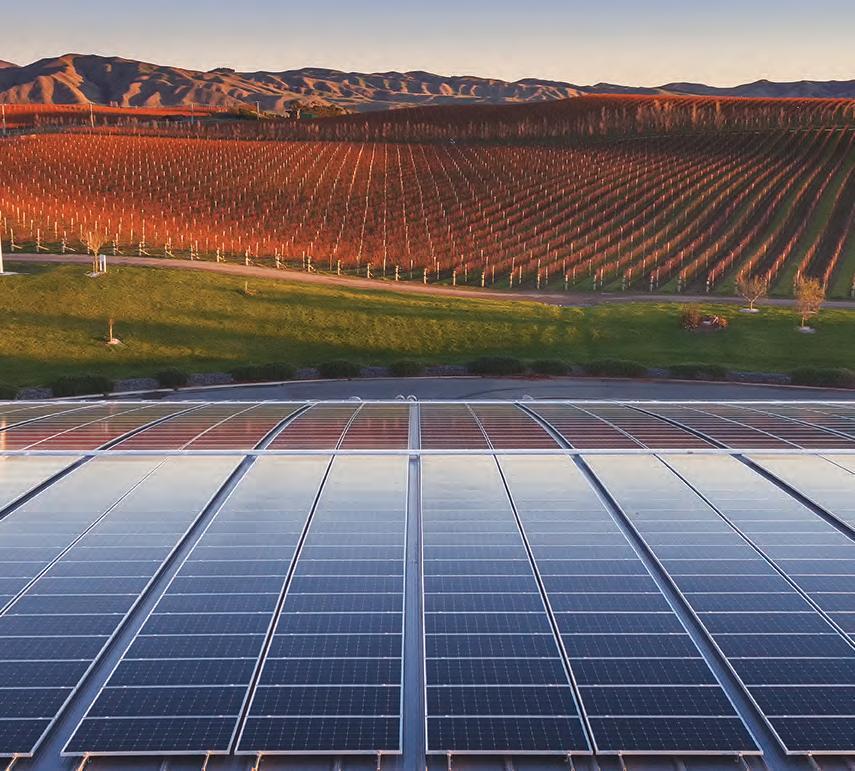
reduction across the whole supply chain and use offsetting to reach net zero only if it is unfeasible to eliminate emissions permanently.
This year NZW has partnered with EECA (the Energy Efficiency and Conservation Authority) and thinkstepanz to develop the industry’s Roadmap
to Net Zero 2050. This work will help to identify achievable milestones that will guide our industry towards our goal and provide insights for winemakers and viticulturists on how to reduce emissions in the winery and vineyard. The Roadmap will be presented at the Research and Innovation Forum taking place as part of
Add Superzyme® to enhance the biology of your soil with beneficial bacteria and fungi. Highfunctioning, positive soil reduces the need for synthetic fertilisers and improves disease
The high-quality range of BIOMIN® mineral nutrition increases absorption, reducing rates and the number of applications required. Less tractor passes and less freight for clean and clever energy use.
Rootella, Mycorrhizal fungi ensures vines thrive, extending root systems, drought resilience and protection. Additionally 60% of carbon is sequestered via your vines and stored permanently in the Glyco-protein secreted by these fungi.
Humax® and Mobilizer® Humic and Fulvic Acid, increases Water Holding Capacity and Cation Exchange Capacity of soil addressing fertiliser loss to waterways.
Altogether Unique 2024 in Wellington on 30 August 2024. If you would like to find out more, we would love to see you there.
“A net
zero target is more ambitious than the previous goal of carbon neutrality as it seeks a specific balance between the amount of greenhouse gases produced and the amount removed from the atmosphere.”
Dr Edwin Massey
How far do we have to travel?
In June this year NZW released the National GHG Emissions Report 2023. This report outlines vineyard and winery GHG emissions analyses based on submissions from Sustainable
Winegrowing New Zealand members for the 2022/23 season. This is the third report to quantify and track the industry’s GHG emissions. It does not quantify the full emissions footprint of wine but production does capture emissions from energy use, plant protection chemistry, and fertiliser (manufacturing and filed emissions), as well as winery transport and packaging. We are the only wine industry worldwide that tracks this data at a national level.
Estimated GHG emissions from wine production and packaging to the winery door was 170,245 tonnes CO2e for the 2023 vintage, equivalent to 310g CO2e/ bottle of wine. Vineyard activities account for 34% of total emissions, with winery activities accounting for the remaining 66%. The two main contributors to total emissions are winery packaging, which accounts for 53% of total emissions, and fuel use on vineyards, which accounts for 20%. Total vineyard emissions were 1398kg CO2e/ha on average for the 2022/23 season. Diesel use accounted for the most GHG emissions on vineyards at 780kg CO2e/ha.
The need to take action
These statistics highlight that as an
industry we have a long way to go to reach our net zero goal by 2050. There is no doubt that research and innovation are needed to help drive progress and will be a vital component of a more sustainable future. Nonetheless, there are decisions and actions that all members can take now to begin or accelerate their journey to net zero. Many members are already working hard to minimise their impact on a changing climate.
There is no silver bullet and progress requires the collective implementation of a number of small actions; whether that’s an individual vineyard owner doing one fewer vineyard pass next season, a wine company conducting an energy audit and implementing its recommendations, or engaging with EECA to help produce an emissions reduction plan. Overall, the most important decision is to just start thinking about what opportunities you have to reduce emissions in your business. Every step we take helps to protect our reputation and market access. Only together can we make a positive impact on our industry, our wine and our world.

Dr Edwin Massey is General Manager Sustainability at NZW

For strong vines, consistent yields and better tasting wines*apply:
Mycorrcin – to boost soil microbes that increase root growth and nutrient uptake
Foliacin – to improve foliar health and resilience in times of environmental stress
Digester – to stimulate decomposition microbes to recycle organic matter fast


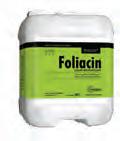
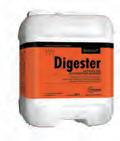
*Asusedin2021AccoladeWinestrial for provenyieldincreaseandbettertastingwine.
Available from leading horticultural suppliers

In New Zealand, we take great care to understand and protect our primary industries from biosecurity incursions through rigorous border control procedures and strict import health standards. But what about the things we can’t control? Some recent arrivals impacting our primary industries and native estate include myrtle rust and fall army worm. These two pests most likely arrived via the aerial pathway, something we are just starting to understand and investigate.
New Zealand Winegrowers (NZW) is involved in Scion’s latest research programme, Protecting Aotearoa from Aerial Invaders in a Changing Climate, as part of the Programme Advisory Committee (PAC). Scion is a Crown Research Institute specialising in research, science and technology development for the timber industry. Although Scion’s primary focus is on the timber industry, this research will assist all primary sector producers, including viticulture, that could be affected by a pest or disease introduced to New Zealand via the aerial pathway.
Entomologists and atmospheric scientists are collaborating with industry partners, iwi, Taranaki Regional Council, and local community initiatives on the five-year research programme, funded by the Ministry of Business, Innovation and Employment Endeavour Fund. The research aims to strengthen New Zealand’s biosecurity and develop a warning system to help us predict when meteorological conditions are likely to deliver insects and pathogens to our shores, spread by the wind.
Ultimately, a new warning system – the Aerobiological Surveillance and Prediction System (ASaP) – will be developed. The warning system will help predict when organisms may arrive and if they are a threat, and it will flag locations for surveillance before insects and/or pathogens can become established.
The program will tackle aerial biosecurity threats by updating wind trajectory models, studying the origins and changes of ‘airbridges,’ understanding how insects and microbes move from airbridges to the ground, and researching their survival in extreme atmospheric conditions during
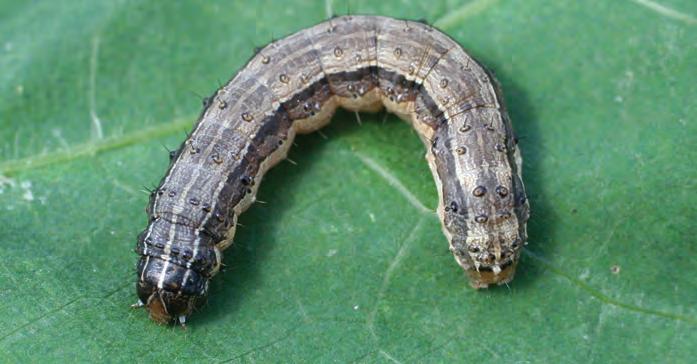
long-distance travel.
An airbridge is like a natural highway in the sky that allows insects and pathogens to travel from one continent or island to another. Wind and weather patterns create updrafts into these invisible paths, helping organisms move across large distances. Noticeable and colourful Australian pest insects such as butterflies and moths have regularly been recorded in New Zealand, often clustered on the west coast following northwesterly winds.
Currently, there is a critical gap in biosecurity defences that allow insects and pathogens to reach New Zealand via an airbridge and spread until our surveillance systems detect them. This problem could worsen with the changing climate. A warming planet significantly increases jet stream instability, as seen in storm frequency, intensity, and severe turbulence.
The team estimates that preventing the establishment of just one serious pest could contribute NZ$0.125 - $1.25billion through avoided losses in primary sectors such as viticulture, horticulture, and forestry. There is also a real threat to our biodiversity, native vegetation, and forests, which could impact carbon sequestration.
Throughout the research programme, monitoring of atmospheric transport via airbridges, quantifying how insects and pests move between the Earth’s surface and upper atmosphere, atmospheric survival data, and a case study in Taranaki will inform the development of the ASaP tool.
The project’s learnings will also be shared

with tamariki in the Taranaki region through a community outreach and educational project being co-designed with iwi.
Scion’s project partners are the University of Canterbury, NIWA, Virgina Tech, Taranaki Mounga Project, Taranaki Regional Council, Maanaki Whenua, AgResearch, and Plant & Food Research. Alongside MBIE, Te Uru Kahika – Regional and Unitary Councils Aotearoa – and The Foundation for Arable Research contribute funding.

Jim Herdman is NZW Biosecurity Advisor. This piece was written with support from Vanessa McWilliams, Science Communications Advisor at Scion.
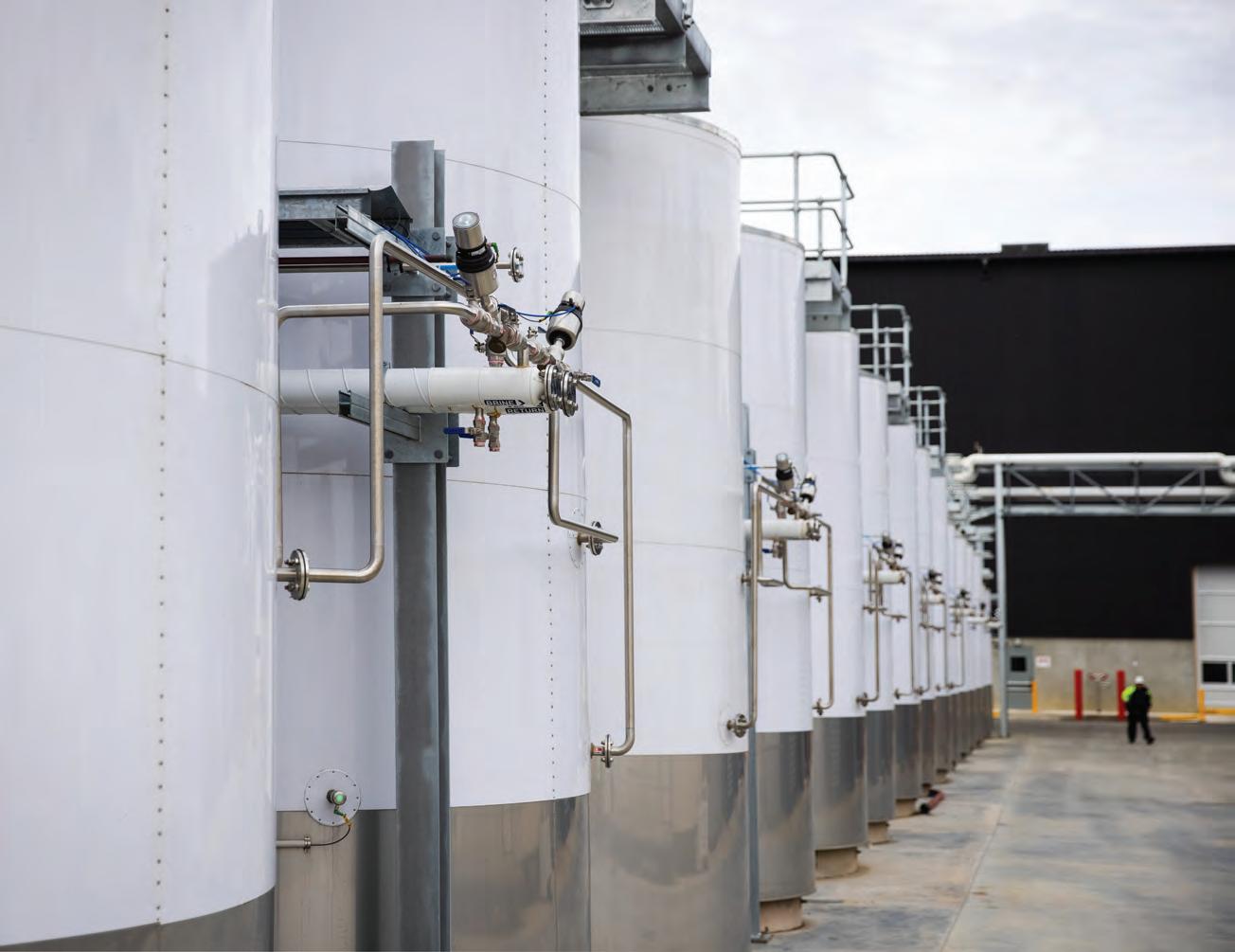
20+ years working with local installers, providing fit-for-purpose valves and tank control management systems for New Zealand winemakers.
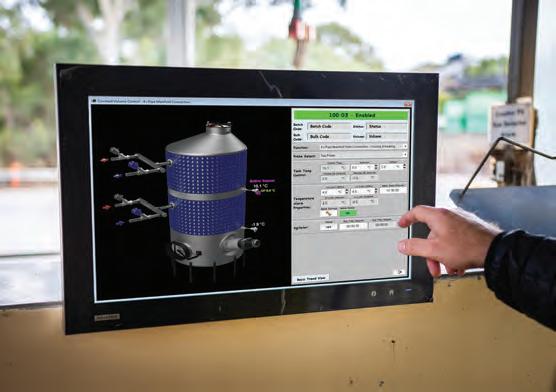
// Discover why the wine industry prefer to partner with us >

Taking NZ wine to the world: Bringing the world to NZ wine
Advocacy on matters of vital importance to the industry
Larissa Trownson
Member Class Directors Election –nominations open
In October this year, New Zealand Winegrowers will be holding an election for the five Member Class Directors on its Board, who are elected for a four-year term, on the basis of one vote per Member. The last Member Class Director Election was in 2020, and the terms of those five Directors also finish in October this year.
“Now is the time to think about who you would want to govern your national body, or whether you would want to yourself.”
The Board’s role is to govern and provide strategic direction to New Zealand Winegrowers (NZW). As part of this, it directs the spending of your levy money, so it is important that you get involved. Nominations open soon – now is the time to think about who you would want to govern your national body, or whether you would want to yourself. Get involved!
Any Member may be nominated and, because of the Member Class voting system, every Member – large or small – will have an equal chance to influence who is elected for these positions. NZW hopes to see a diverse range of talented candidates standing across gender,

ethnicity, age, regions and industry roles.
Who may stand as a candidate?
To be nominated as a candidate, a person must be appointed by any NZW Member to exercise their voting rights (ie a Member Representative). In addition, they must not be disqualified under the Rules of NZW or law, or currently declared bankrupt.
What is the commitment required to be on the Board?
The Board usually meets six times a year for around a day and each Director is also expected to serve on two Board Committees. The most important requirements of candidates are that they care about the future of the industry and are prepared to contribute their skills, experience and perspectives. Directors are expected to work in an open-minded way with the other Directors for the benefit of the whole industry, not their particular interests.
What are the next steps?
Any Member of NZW may nominate a candidate from 5 August to 6 September. Detailed information on the nomination process will be sent directly to Members on 2 August (and, from that date, can be found on the regularly updated dedicated webpage on the NZW Members website, under ‘About Us’ then ‘Governance’). In the interim, if you have any questions, please contact the NZW Advocacy Team at advocacy@nzwine.com.
Detailed nomination information sent to members Friday 2 August
Nominations open Monday 5 August
Nominations close Friday 6 September
Members advised of candidates Monday 23 September
Voting opens Monday 7 October
Voting closes and results announced Friday 18 October
On 26 June 2024, the New Zealand Winegrowers Board set the following levy rates for the year 1 July 2024 to 30 June 2025.
Wine levy - The levy rate to apply to sales of grape wine is 3.12 cents plus GST per litre.
Grape levy - The levy rate on winegrapes from Vintage 2025 is to be set at the rate of 0.935% as follows:
(a) if sold by or on behalf of the grower, 0.935% of the farm-gate price plus GST;
(b) if exported by or on behalf of the grower, 0.935% of the free onboard value plus GST;
(c) if made into grape juice or grape juice concentrate, 0.935% of the notional price of the grapes plus GST.
In the case of (c), the notional price for the year 2025 vintage has been set as 75% quartile for the region and variety concerned as determined from the 2024 vintage as listed in the last published version of the New Zealand Winegrowers (NZW) grape price data for that vintage.
These rates are set by NZW pursuant to clause 9(1) of the Wine (Grape Wine Levy) Order 2022 and clause 11(1) of the Commodity Levies (Winegrapes) Order 2022. If you have any questions, please contact our Advocacy team at advocacy@nzwine.com.

A regular feature to inform and update the wine industry on research projects being undertaken for their benefit. Newly approved projects when available are briefly summarised. Ongoing projects have longer articles that describe progress and what has been achieved so far. When completed, each project report will be shared in full detail in the Research Library on nzwine.com.
Bragato Research Institute conducts research in-house or collaborates with research organisations throughout New Zealand. The main research providers for each project are listed.
Updates are provided on the highlighted projects in this supplement.
Vineyard innovation
Improving remedial surgery practices to increase vineyard longevity
Linnaeus, SARDI
Long spur pruning as an alternative to cane pruning for Sauvignon blanc
Bragato Research Institute
Evaluating water use efficiency and drought tolerance of various rootstocks grafted to Sauvignon blanc
Bragato Research Institute
Potential applications of nanotechnology for wine growing in New Zealand
University of Auckland
Varietal diversification
– Cool climate aromatic white wine produced by Marlborough
Bragato Research Institute, EIT, NMIT
Sauvignon Blanc Grapevine Improvement Programme
Bragato Research Institute, Plant & Food Research, Lincoln University
National Vine Collection
Virus Eradication
Bragato Research Institute
Winemaking innovation
Exploring reductive aromas in Pinot noir
University of Aucland
Precipitation of calcium tartrate and other compounds in wine
University of Canterbury
Lab on a Chip: Developing diagnostic devices for the wine industry
University of Canterbury
Prevention of quercetin instability in bottled wine
Indevin
Sustainable winegrowing
Building soil health on vineyards
Bragato Research Institute
Microbial community and vine responses to increasing temperatures in the New Zealand context
University of Auckland
Development of an anaerobic chain-elongation bioprocess for grape marc valorisation
University of Auckland
Evaluating ecologically sustainable ways to disrupt the wētā-vine association
Plant & Food Research
Potted Vines: Exploring the Role of Trichoderma on Marlborough Soil to Influence Drought Stress Shift
Bragato Research Institute

Dr Seth Laurenson, Bragato Research Institute
Soil is the foundation of our industry, and maintaining soil health is a priority focus for Bragato Research Institute. Grape growers tend to have a close relationship with the soil because it influences the health of grapevines and the character of resulting wines. There is also increasing awareness that soil health is declining in many vineyards across New Zealand.
In 2023, Bragato Research Institute (BRI) conducted a survey to identify practices that are being used by grape growers to build soil health. The survey identified techniques ranging from irrigation management, reducing compaction, and fertilisers, to cover crops, mulching or composting. However, soil health is a complex issue to manage because soil characteristics, climate and the grower’s own goals all vary on a sub-vineyard scale. When faced with this complexity, many growers are uncertain about the most effective management practices for their specific soil profiles.
The survey identified that 96% of growers want more information to support improved soil health. Specifically, respondents wanted this information to be more specific to their location and the potential issues that might be limiting vine performance and recommendations to be focused more heavily on these unique circumstances.
Based on this feedback, BRI, in collaboration with Plant & Food Research and the Marlborough District Council, have developed a ‘proof-of-concept’ that can guide site specific soil management practices to promote soil health. The proof-of-concept tool provides soil property information on a specific
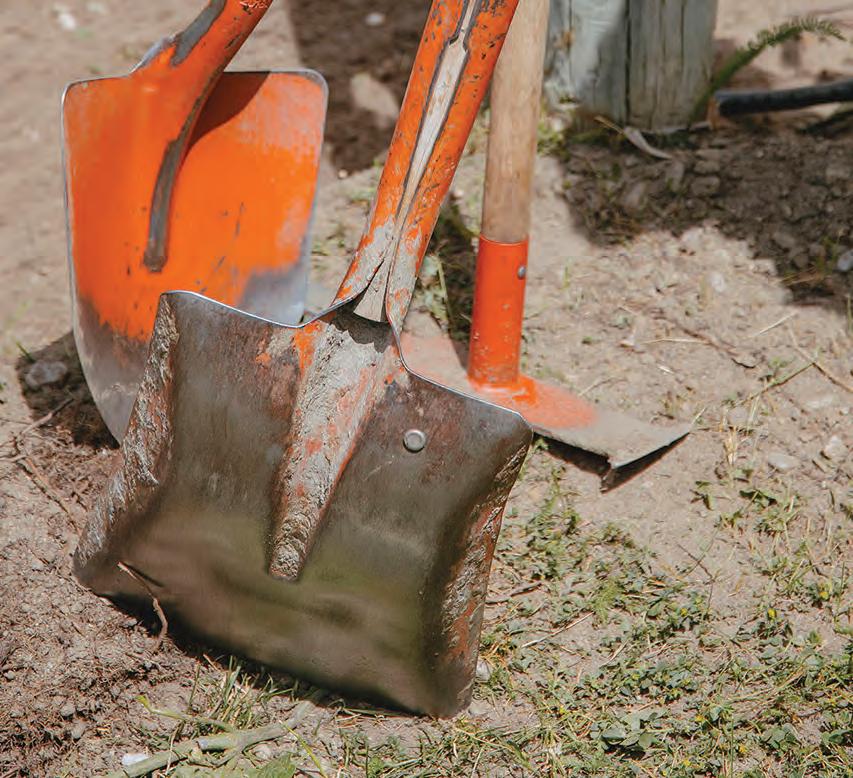
parcel of land, and recommended management techniques based on the soil’s susceptibilities to conditions affecting vine performance. We aim to provide a tool and knowledge to help grape growers make rational and effective changes within their businesses. The proof-of-concept tool is simply to demonstrate the concept and is not perfect at this stage. We are currently seeking feedback on this proof-of-concept so that we can develop something that is valuable for the wine industry in meeting its goals of enhancing soil health.
The tool was initially developed for the Marlborough/Ward area. We assessed 16 unique environments (Typologies) based on a series of soil properties that influence
vine growth and performance. The 16 Typologies represent the diversity of soil-related growing conditions across Marlborough. The different Typologies are shown in the map interface through coloured shading in Image 1.
Currently the tool relies on relatively coarse scale soil mapping. Growers will find that soils will often vary within the mapped Typology zone. Our goal is to refine both the Typology mapping and our understanding of the variation within polygons with feedback.
To begin, users pinpoint their vineyard location and select a land parcel of interest. They are then presented with detail regarding the property, including the distribution of

different Typologies that are present across the site and the proportions of each, as a % of the total property size.
For example, the image to the right shows that this property is comprised predominantly of the Renwick type, followed by Dashwood, with lesser coverage of the Western Wairau.
These soils contrast significantly in their characteristics. Renwick soils are typified by deep loam brown soils with good drainage properties. The Dashwood is typified by Pallic soils that have imperfect to poor drainage properties. The Western Wairau is typified by Recent soils, with high to very high stone content derived from rivers.
For each Typology, users can click into general information typical properties, its distribution and frequency across Marlborough. A soil profile image and landscape photo are also included so growers can relate their knowledge with what is being predicted as the soil type within the databases we have used.
Each Typology description also contains information on susceptibilities and limitations that affect vine growth and performance. Table 1 shows the susceptibility of the Dashwood type. The soil is at high risk of soil compaction, yet moderate risk of
being limited by shallow rooting depths (i.e., due to rooting barriers such as dense subsoils or shallow water tables) and poor nutrient supply. However, the risk of growth limitations due to poor water retention are low (i.e., sufficient water can be stored in this soil). This data has been created using the Typology data and expert opinion. Detailed information relating to each Typology will grow as we continue to receive feedback growers reviewing the tool.
Next, the tool identifies recommended management practices that are most appropriate for improving soil health at their location based on the Typologies present on their property (see Table 2).
Here, the management practices suitable to the Renwick soil are shown. The selection of management practices was collated from a recent survey of vineyard management practices used by New Zealand growers to promote soil health. This work was undertaken by BRI and a summary is available in the New Zealand Winegrower magazine (June-July 2024 issue).



We assigned the management practices to individual Typologies using expert knowledge. For the proof-of-concept we’ve been able to develop a dataset of current practices and options that can be assigned to a given type. However, we expect this data to be refined/expanded as we continue to receive feedback on this initial prototype.
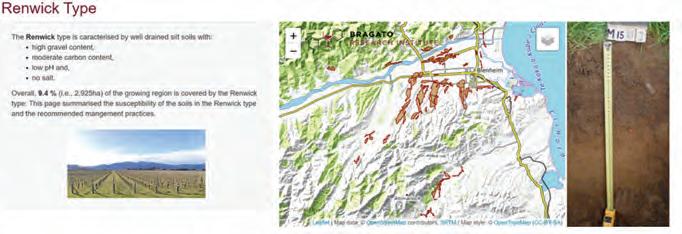
In the near future, we aim to work with industry to establish an agreed soil health monitoring protocol specific to grape growing. We also aim to develop Typology classes for wine regions across New Zealand and develop a matrix of good management practices to support all vineyards. Doing this will allow us to develop a
live Decision Support Tool and implement and measure the effects of various management practices on soil health outcomes. This will ultimately help the industry meet its sustainability goals. If you have feedback on the current proof-of-concept or the future goals, we’d be very pleased to hear from you. Get in touch by emailing info@bri.co.nz.
Recommended Management
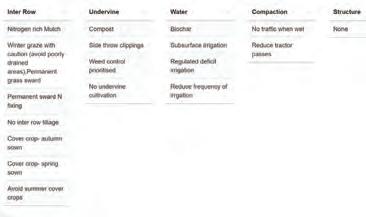
Table
- Recommended Management
Braden Crosby and Yuichi Ando, Bragato Research Institute
Rootstocks are an essential component of grape growing in New Zealand. Rootstocks can influence vine performance, vine longevity, and water and nutrient uptake, and rootstock selection is one of the key decision-making points when selecting new planting material.
Adaptation strategies are required to deal with the changing climate and using more efficient droughttolerant rootstocks is potentially a sustainable solution. This project aimed to understand the benefits that rootstocks may confer with regards to climate change resilience, sustainability, profitability, and quality so the wine industry could make more informed decisions for their businesses.
There are several parameters needed to make informed decisions on rootstock selection. In this project, Bragato Research Institute (BRI) investigated the Water Use Efficiency (WUE), measured as carbon gain per unit of water loss, of 11 rootstocks and their effect on vine performance, in an established vineyard.
BRI identified several commercial rootstock trials in Marlborough, and selected a vineyard in the Renwick area of the Wairau Valley that contained 11 rootstocks grafted to Chardonnay (Clone 6) and planted in 1994.
Measurements of vine vigour were undertaken, with pruning weights, canopy gaps and trunk cross sectional area monitored. Juice parameters and yield were measured in 2024 to understand the carbohydrate partitioning within the vines. Stem water potential (SWP) was monitored throughout the season and WUE, which was measured as a ratio of photosynthesis (A) over transpiration (E) using a CIRAS-4 Portable Photosynthesis System.
Pruning weights, canopy gaps and trunk cross-sectional area varied to a significant level between rootstocks, with parentage playing a role in vine growth and vigour. Vines with Berlandieri x rupestris

parentage consistently had higher pruning weights, lower levels of canopy gaps, and larger trunk cross-sectional area. There was no significant difference in pruning weights and canopy gaps between Riparia x rupestris rootstocks, while Riparia gloire had the lowest vigour of all the rootstocks in all metrics that were measured. V. champinii rootstock Ramsey had the lowest pruning weight relative to the trunk area.
Stem water potential (SWP) was measured as a representation of vine water requirements. SWP readings were tracked during the season with the highest negative pressure
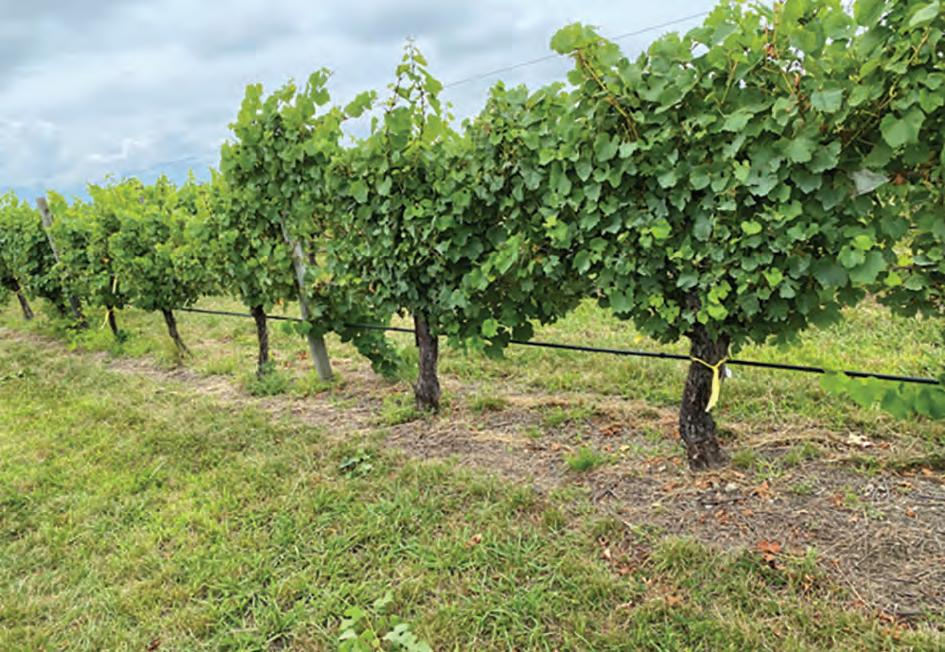
occurring in February in both 2023 and 2024. Irrigation was not used on these vines in 2023 and occurred once at the end of February 2024. SWP varied between rootstocks but was not significant in 2024. Given no irrigation was applied to the vines by early February, all rootstocks could access water through non-applied means.
Water use optimisation was measured as the relationship between photosynthesis and transpiration (Figure 2). Ramsey, Schwarzmann, 420A and Riparia gloire consistently had a photosynthetic rate below the mean. Riparia gloire managed water losses efficiently with low transpiration rates, potentially leading to smaller above ground structures and smaller
canopies. Ramsey and Schwarzmann tended to be inefficient users of water, utilising more water per carbon gain. SO4 tended to be close to the mean in both years, which aligns with observations of vine vigour, yield and brix. Paulsen, R99 and R110 all had a high level of photosynthesis, but to achieve this they used more water, transpiring at a higher rate. These vines had the highest pruning weights and the largest trunk cross-sectional area. This would suggest these vines are using excess photosynthates for building in-season vegetation and permanent structures.
Yield and juice parameters
There was no significant difference in yield, pH or YAN. Yield and brix were not associated with the level
of photosynthesis, with high photosynthesising vines not producing higher yield or brix, indicating partitioning of carbohydrates is being utilised elsewhere. Brix levels ranged from 21.7 to 22.5, with significant differences, however the brix level also aligns with yield trends.
Malic acid and Titratable acidity varied and appeared to be linked to canopy size, with Riparia gloire having the acidity; while Ruggeri, R99 had the highest malic and along with Paulsen had the highest Titratable Acidity.
Conclusion
In conclusion, the findings of this project and previous studies would suggest that no rootstock performs optimally every season. Vine vigour
is strongly related to trunk cross sectional area and parentage. Berlandieri x rupestris crosses have greater trunk cross sectional area and canopy size when compared to Riparia parentage.
Rootstock parentage influenced the construction of permanent structures, which may reflect carbohydrate partitioning. Generally, those that photosynthesised and transpired at a higher rate tended to have larger above-ground permanent structures. Literature would suggest these selections also have larger below-ground structures which might allow them to access more non-applied water sources. These selections might be useful for low vigour scions or under management techniques that lend themselves to reduced vigour such as organic management practices or where water availability is limited. Berlandieri parentage tended to produce larger canopies as vines age in this trial block.
When the ratio of photosynthesis over transpiration is investigated, that is the ratio of water usage for carbon gain, we find there is no significant difference in the instantaneous WUE between rootstocks over both years. The productive WUE of Riparia gloire was highest as it used less water for the same crop and brix level.
Yield, pH and YAN were not significantly different between rootstocks in these years. Brix, TA and malic varied slightly by rootstock. Higher concentrations of malic acid were associated with high vine vigour.
The opportunity to increase genetic diversity in our rootstock selection is large. Having a diversified portfolio of rootstock genetics is a risk mitigation strategy, especially heading into a changing climate scenario.
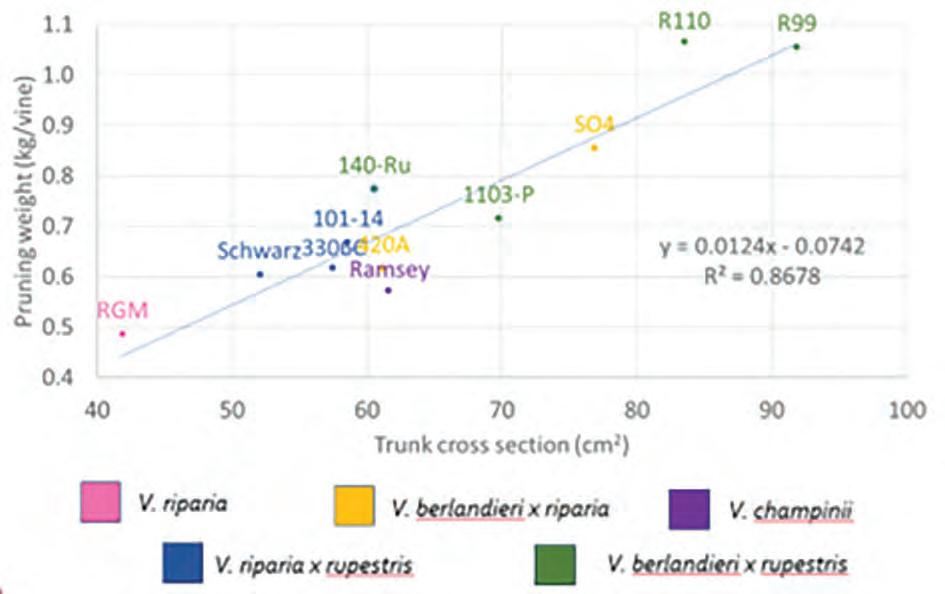
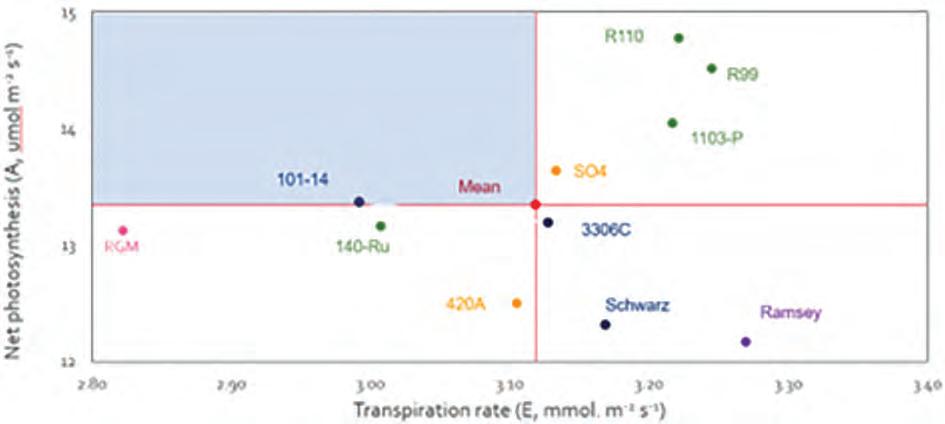
Figure 2. Relationship between Photosynthesis (A) and Transpiration (E) in the 2024 season. The top left-hand box represents optimum vine performance - vines that photosynthesise at a higher-than-average rate, while utilising less water through transpiration.
This two-year project was part of the information used to help build a body of knowledge before data collection starts on BRI’s Sauvignon Blanc rootstock trial. Based in Marlborough, BRI has 15 rootstocks planted to pair objective scientific observation with industry experience. This project is aiming to create opportunities for increasing the diversity of future planting stock to mitigate risk associated with climate change, making the New Zealand wine industry more resilient.
This two-year project was funded by the New Zealand Winegrowers levy and the MBIE regional research institute fund as part of BRI rootstock project 22-017. Thanks to Yuichi Ando (BRI), Pernod Ricard, Andrew Naylor, Dr Mark Krasnow (Thoughtful Viticulture), Dr Stewart Field (NMIT), Dr Carmo Vasconcelos, and Dr Fang Gou (BRI).
Shan Yi1, Kai Xin Chia1, Wei-Qin Zhuang2, Brent Young1
1
Department of Chemical and Materials Engineering, the University of Auckland
2 Department of Civil and Environmental Engineering, the University of Auckland
The New Zealand wine industry is thriving, but with growth comes the challenge of managing grape marc waste – those leftover skins, seeds, and stems. Traditionally seen as a disposal challenge, grape marc is rich in valuable bioactive compounds and organics. While previous research has focused on extracting these bioactive compounds, the remaining organic-rich residue can also be repurposed as feedstock for chemical production, representing a promising, scalable valorisation pathway that has not been fully explored in New Zealand.
To repurpose grape marc as a carbon neutral and renewable feedstock for engineered bioprocesses, Dr Shan Yi and her research team at the University of Auckland (UoA) aimed to develop a novel biochemical engineering process to convert the bulk organics in grape marc into mediumchain organic acids using the catalytic abilities of anaerobic microorganisms. Funded by the Bragato Research Institute, this research project was also part of the PhD research of Kai Xin Chia.
Their approach entailed two specific aims: 1) to develop a treatment process that efficiently converts grape marc into fermentable organics, and 2) to construct an anaerobic microbiome, a mixture of microorganisms that catalyse the anaerobic chain elongation (ACE) reactions to convert the fermentable organics from grape marc into end products like butyric acid and caproic acid, which have substantial
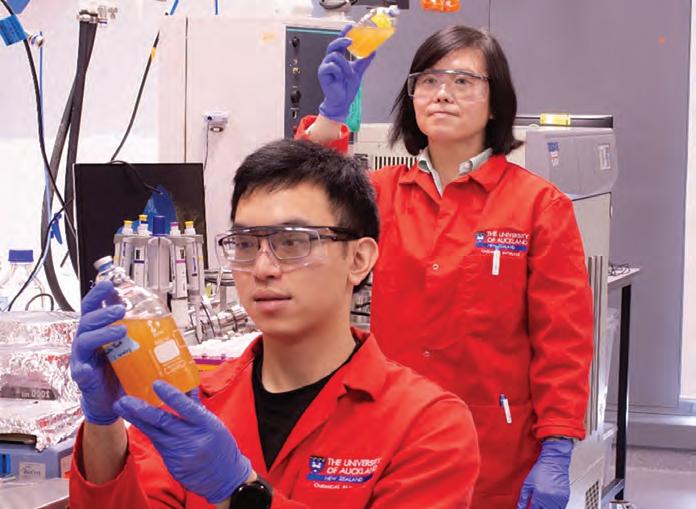
market demand and value. Their innovative approach seeks not only to mitigate the issues associated with disposing of grape marc and its environmental impact but also to add significant economic and social value to the New Zealand wine industry.
Central to their research for valorising grape marc is the ACE reaction, a fascinating metabolism used by bacteria that thrive in oxygen-free environments. These bacteria convert simple organic compounds like ethanol and acetate into larger molecules like butyric acid and caproic acid to gain energy for growth. The UoA team harnessed the natural capabilities of these bacteria, turning them into catalysts in bioreactors to transform
organics from grape marc into valuable chemicals. Because these bacteria prefer mild and oxygenfree conditions, the developed bioreactor process operates without the need for high heat or excessive power consumption, making it an environmentally friendly, low-carbon technology.
The research team’s initial experiments demonstrated that soluble organic compounds in grape marc could be readily converted to butyric acid and caproic acid through bacteriacatalysed ACE reactions. However, most organics in grape marc exist as complex biopolymers like cellulose and lignin, making them inaccessible for ACE reactions. To address this,
the team developed a multi-step process involving physical, chemical, and enzymatic treatments to break down these biopolymers. Under optimal conditions, they achieved over 80% release of organics from the biopolymers, effectively unlocking the grape marc for bioconversion.
Starting with seed material from an anaerobic digester at a local wastewater treatment plant, the team enriched an ACE microbiome containing a mix of bacteria that consistently produced target products at high concentrations, reaching 10 to 12 g/L of butyric and caproic acids. This well-performing ACE microbiome was then used in a lab-scale bioreactor to treat grape marc organics from the multistep process. After the bioreactor operational conditions were optimised, the production of these acids was monitored, confirming the process’s effectiveness. To ensure the reliability of this innovative bioprocess, the team also monitored the populations of three key ACE bacterial strains over six weeks using quantitative PCR. This sensitive molecular technique revealed that the bacteria had adapted well to the bioreactor conditions, maintaining stable cell numbers and consistent
A crucial aspect of this research was its economic feasibility. The biochemical engineering process developed consists of two main units: a multi-step treatment to convert grape marc into fermentable organics and bioreactors with the ACE microbiome to transform these organics into caproic acid and butyric acid. Considering the conversion rates achieved in their laboratory-scale process and the seasonality of grape marc production, the team conducted a
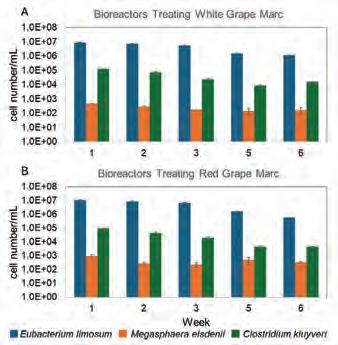
comprehensive techno-economic analysis. The results show that this biochemical process offers a significant economic advantage, outperforming traditional valorisation methods like pyrolysis and anaerobic digestion. The value generated can sufficiently offset bioprocessing costs and greatly enhance the value of the wine industry’s byproducts.
Sustainably repurposing grape marc is increasingly urgent for the New Zealand wine industry. Conventional methods like composting, land application, or landfilling offer limited economic benefits and pose potential environmental risks, such as greenhouse gas emissions and the leaching of organic compounds into soil and waterways. In contrast, valorising grape marc through a biorefinery approach – converting biomass into a variety of valuable products – can yield better financial and environmental outcomes. The biochemical process developed in this research can be used as a standalone method or as part of a larger biorefinery system. Integrating this bioprocess into the wine production chain could help wineries achieve low-waste operations, significantly enhancing their sustainability profile
and bolstering the reputation of the New Zealand wine industry as a leader in environmental stewardship. Additionally, the production of butyric and caproic acids from grape marc benefits not only the wine industry but also other sectors in Aotearoa, New Zealand. This innovative research could significantly contribute to a more sustainable and prosperous future.
In this research, Shan and her team successfully developed an innovative bioprocess to convert grape marc into valuable chemicals, addressing intricate environmental and economic challenges. The next stage will focus on the engineering questions related to scaling this laboratory bioprocess to the pilot stage. The team is also seeking industrial partners interested in collaborating on further investigations and the technology transfer of this novel bioprocess. Please contact shan.yi@auckland.ac.nz if you are interested in partnering. This research not only transforms waste into valuable products but also reshapes our understanding and use of biomass, paving the way for a more sustainable future in the New Zealand wine industry.
Led by Dr Shan Yi and funded by Bragato Research Institute, this two-year project aimed to develop a novel anaerobic chain elongation (ACE) bioprocess to convert grape marc waste into valuable organic acids. By utilising a specialised microbiome in bioreactors, the developed ACE bioprocess supports sustainability and economic growth of the New Zealand wine industry. This project was conducted in the Department of Chemical and Materials Engineering at the Faculty of Engineering at the University of Auckland.
New Katana® takes out weeds including resistant ryegrass for longer
Glyphosate resistant ryegrass has met its match. Katana, the new residual herbicide, provides weed control for up to 5 months. With Katana you’re sorted.


Talk to your local merchant to find out more.
